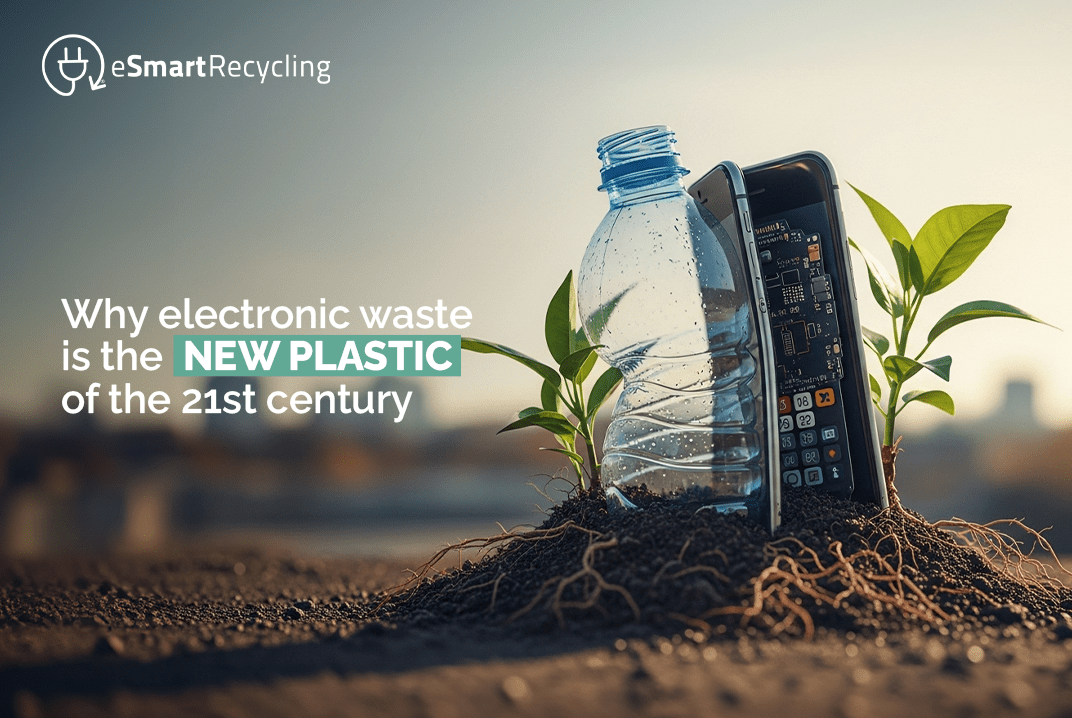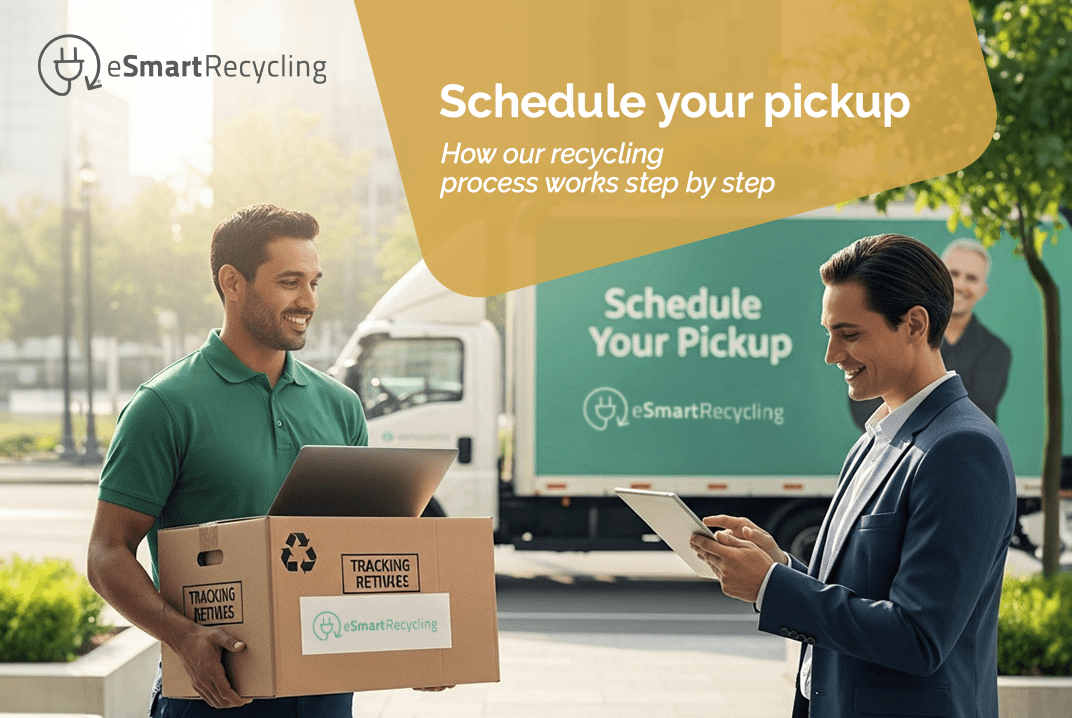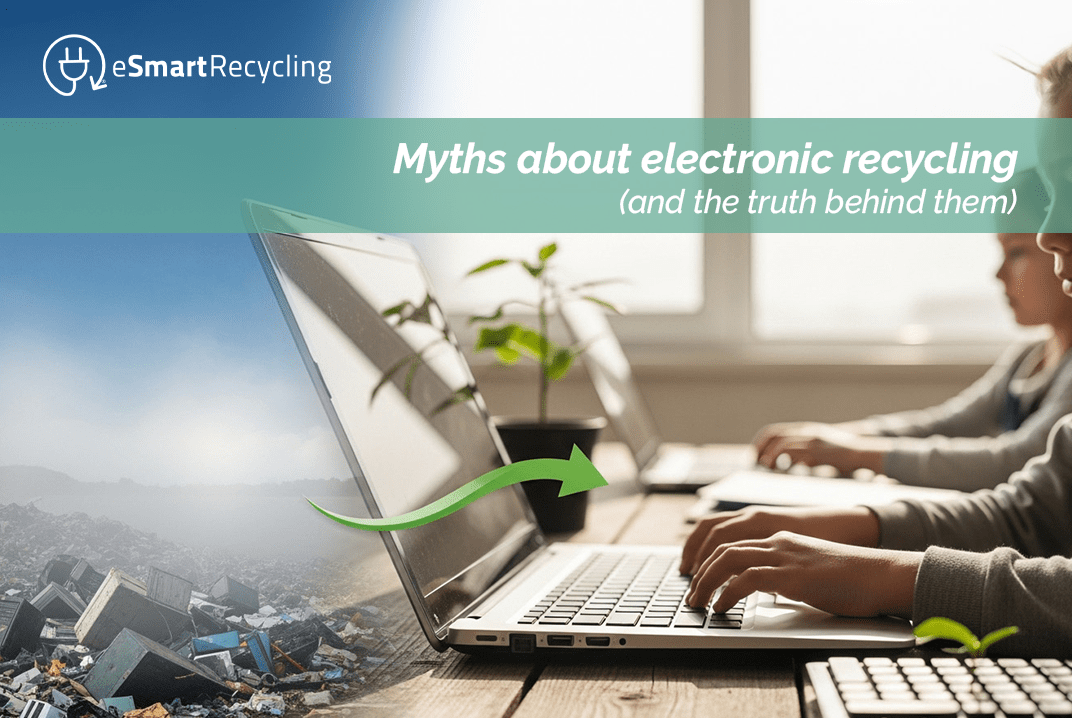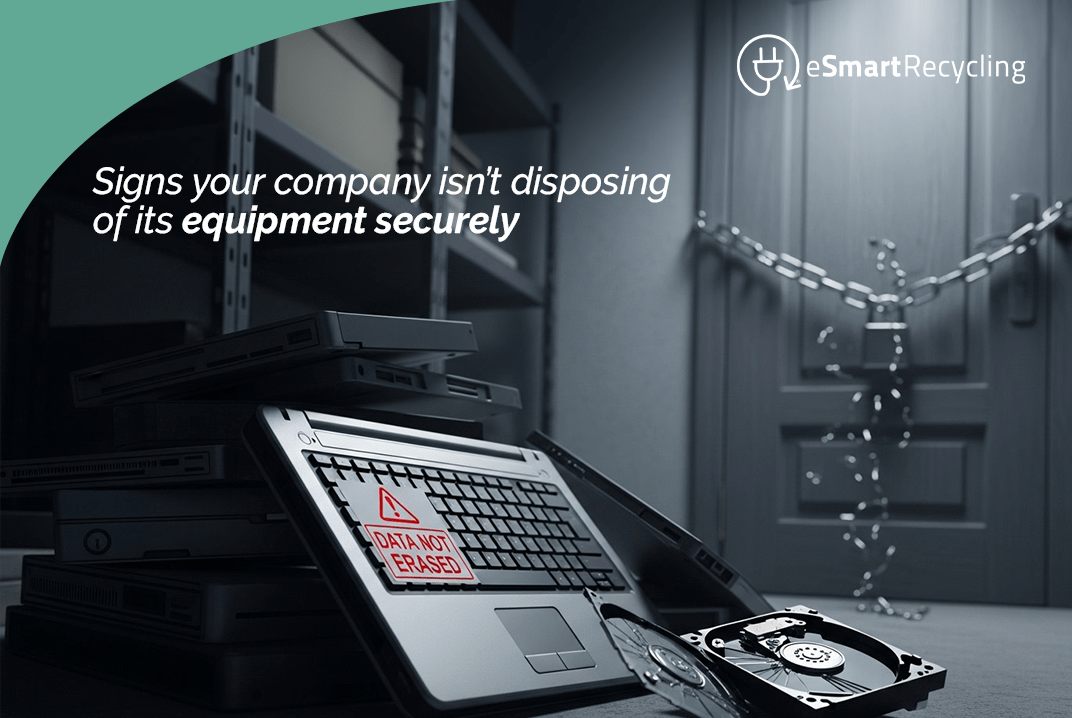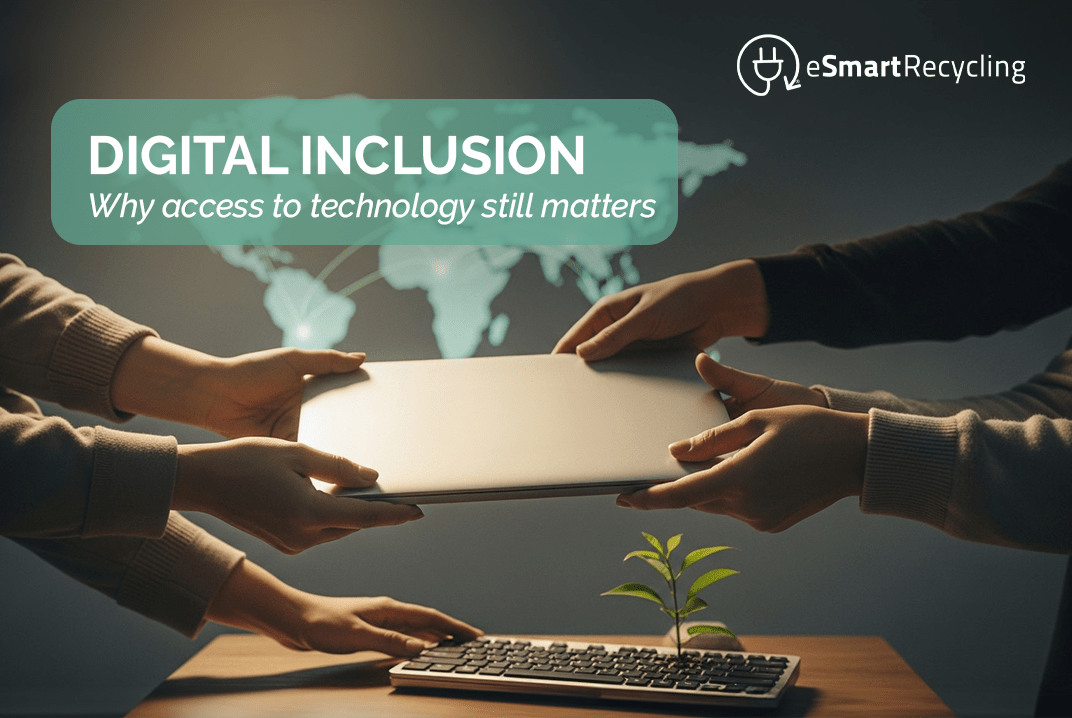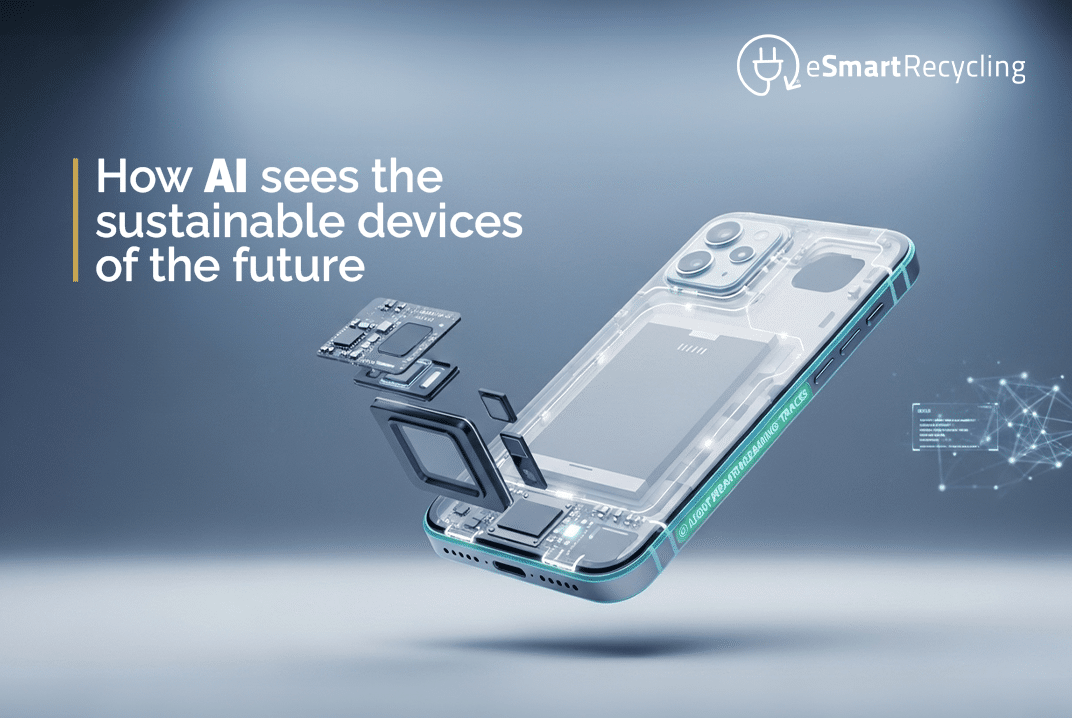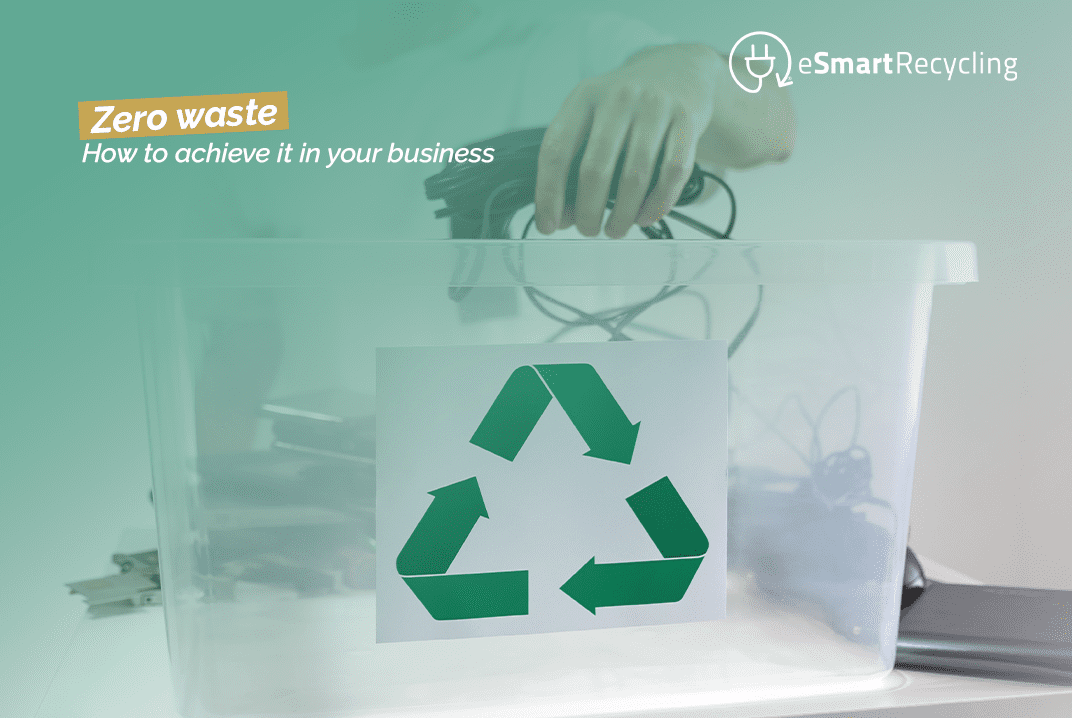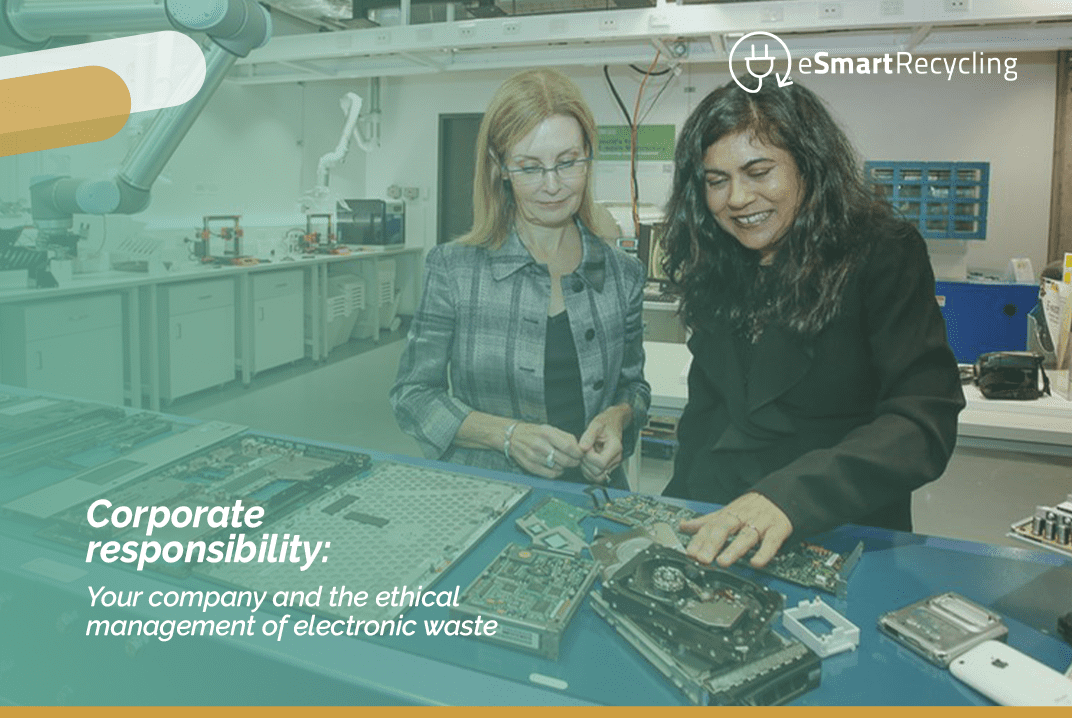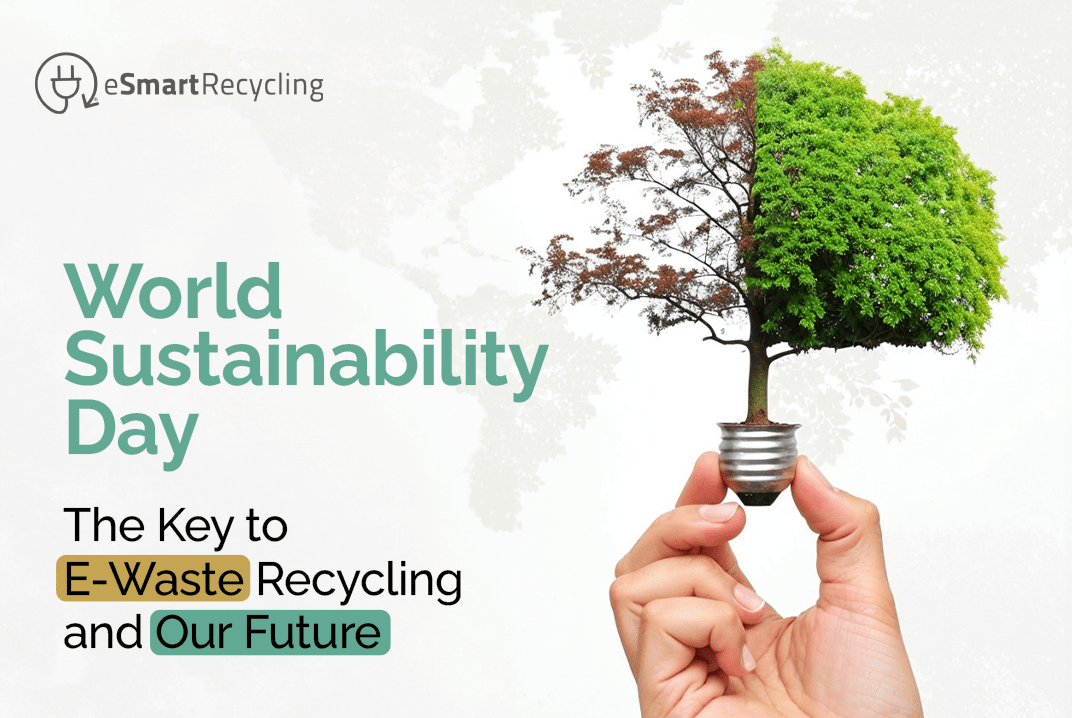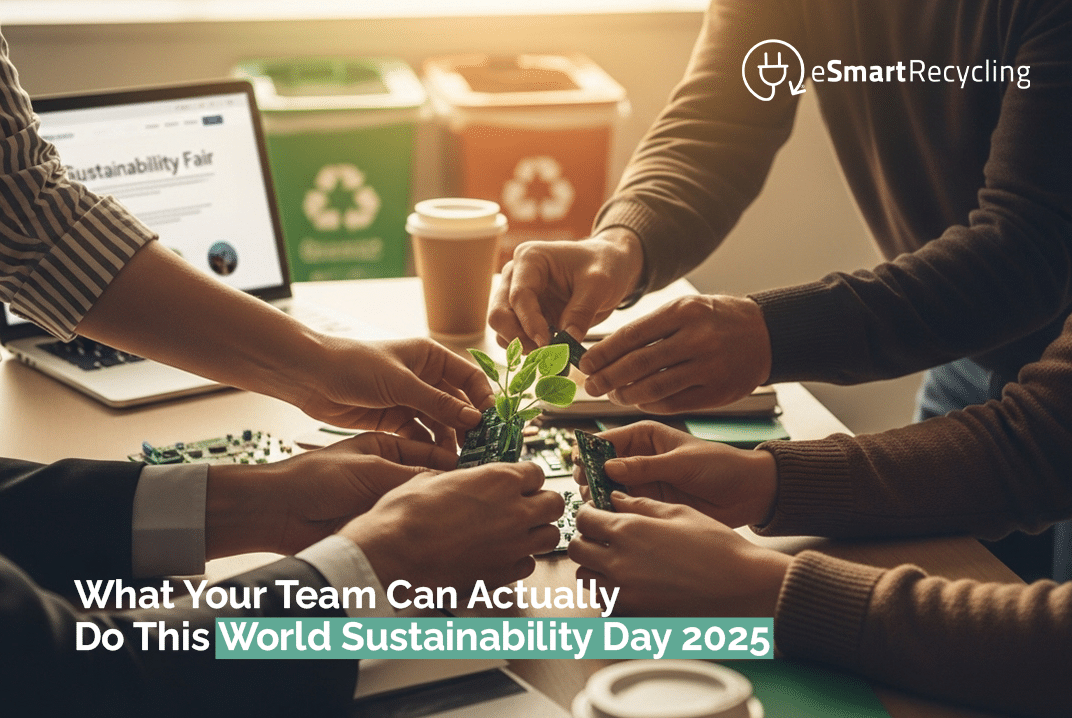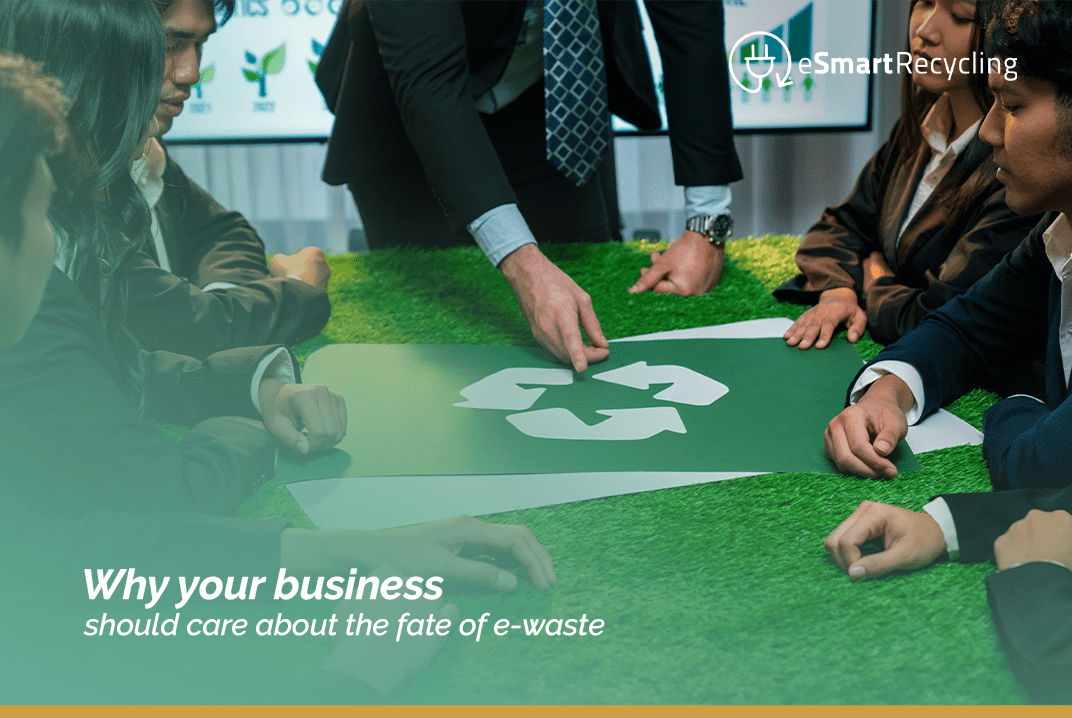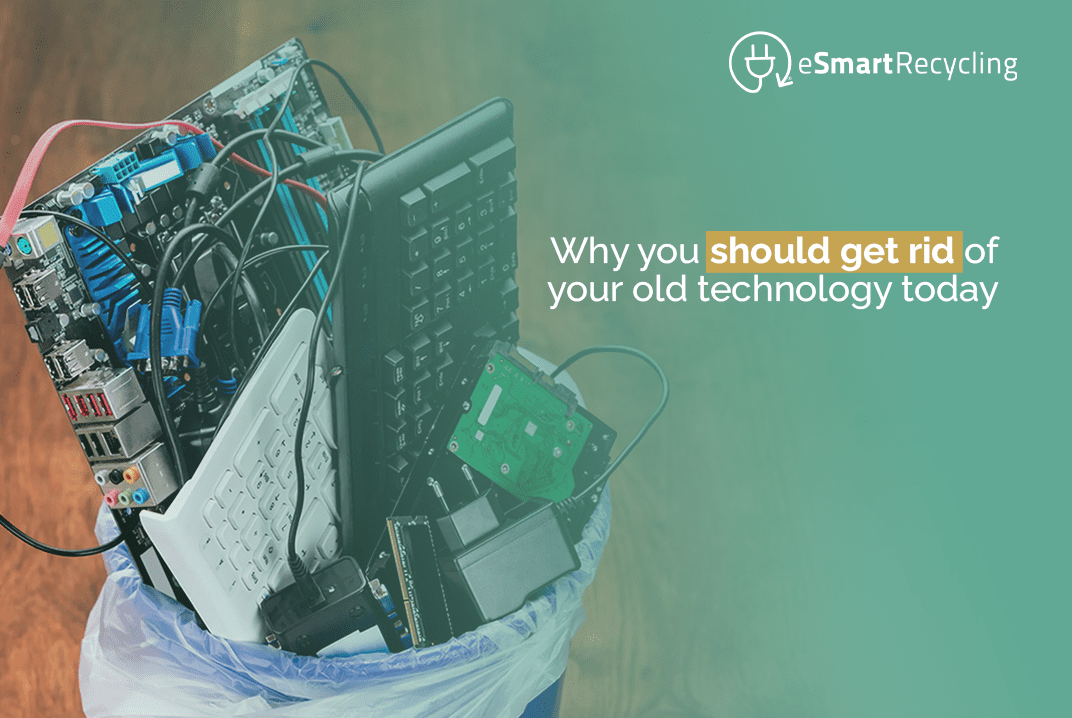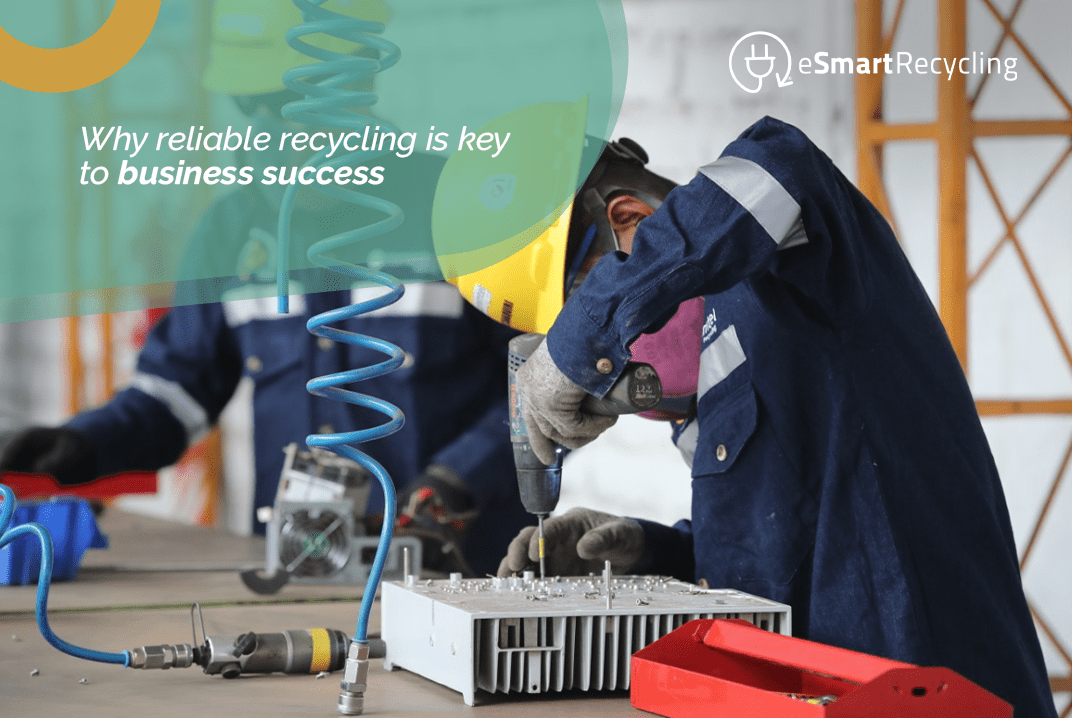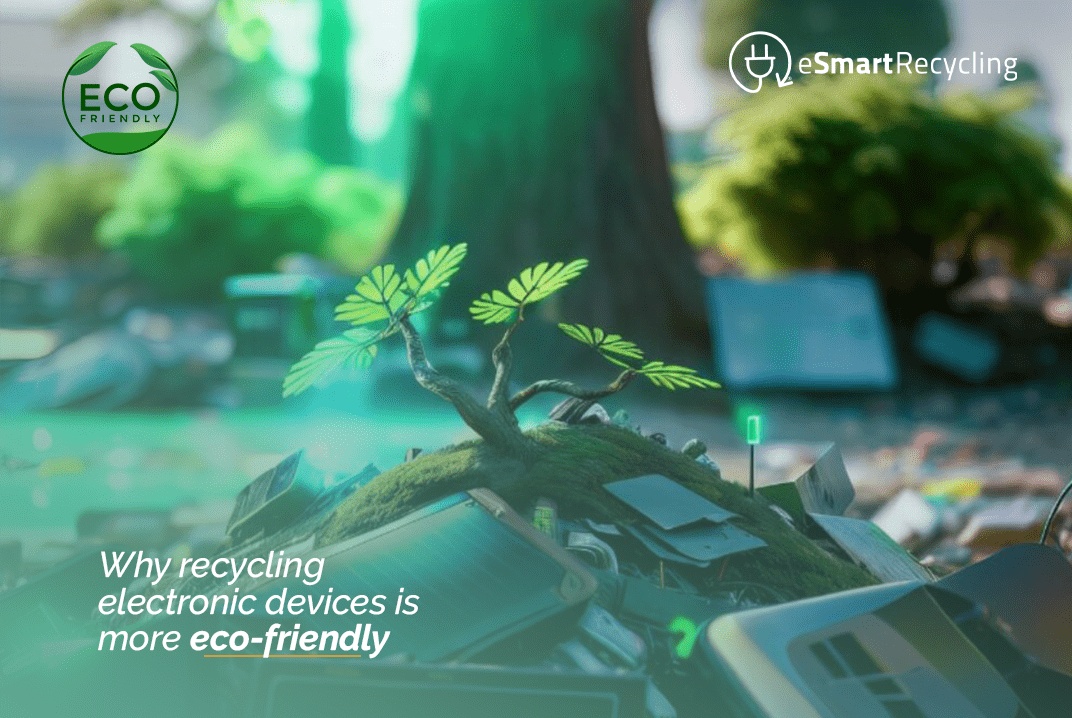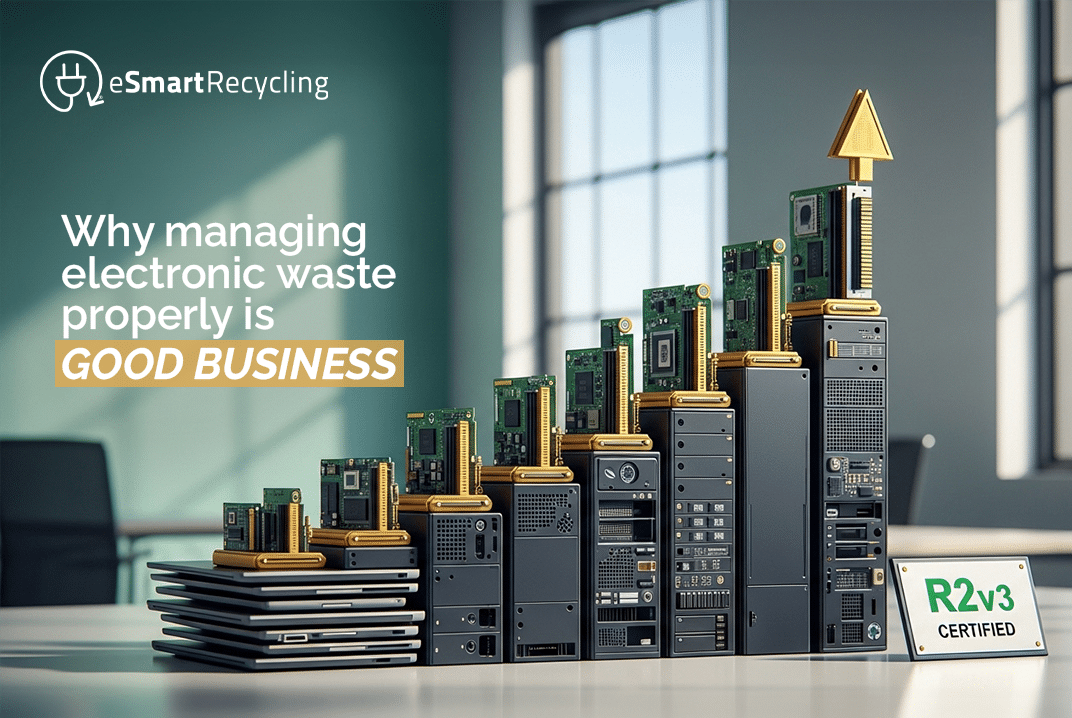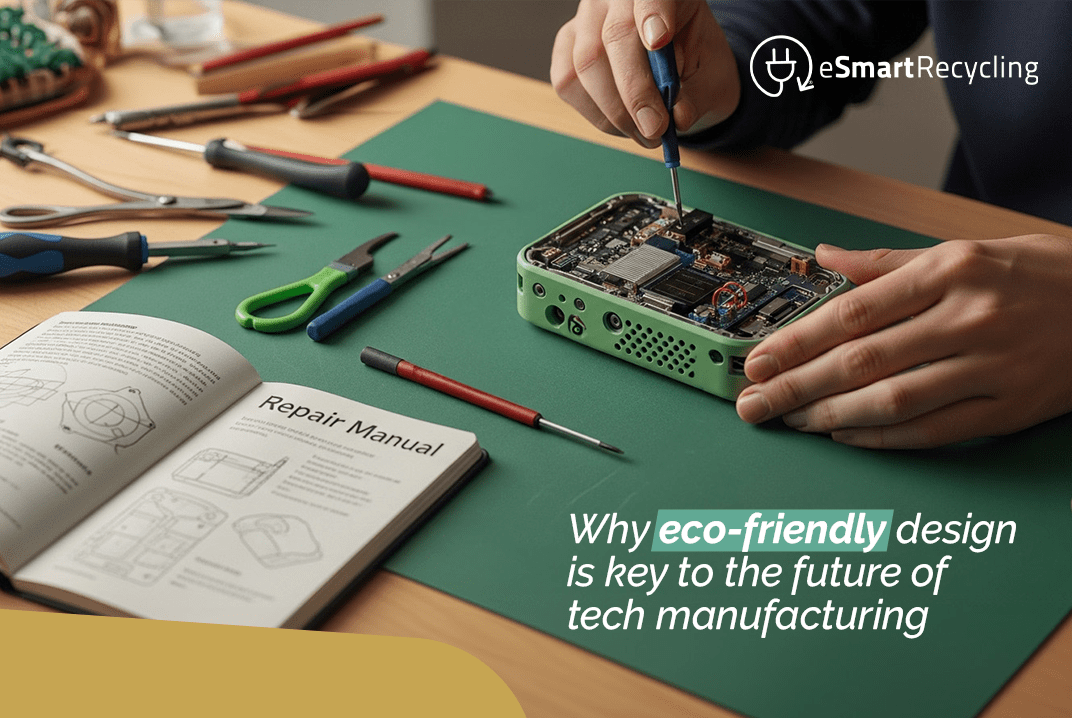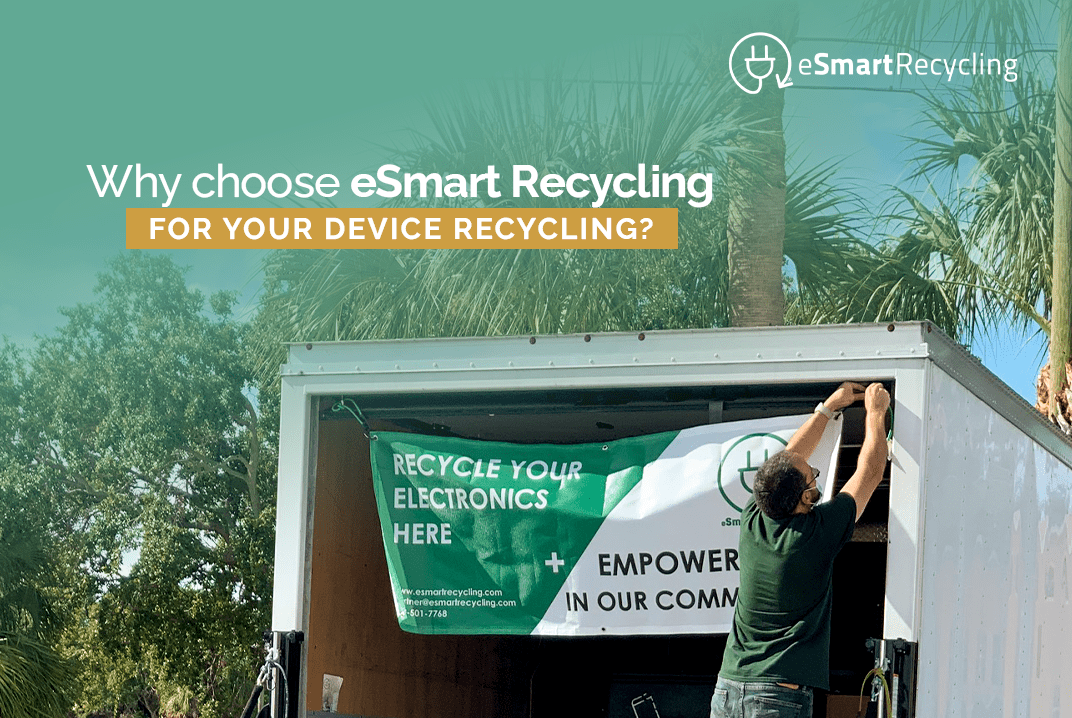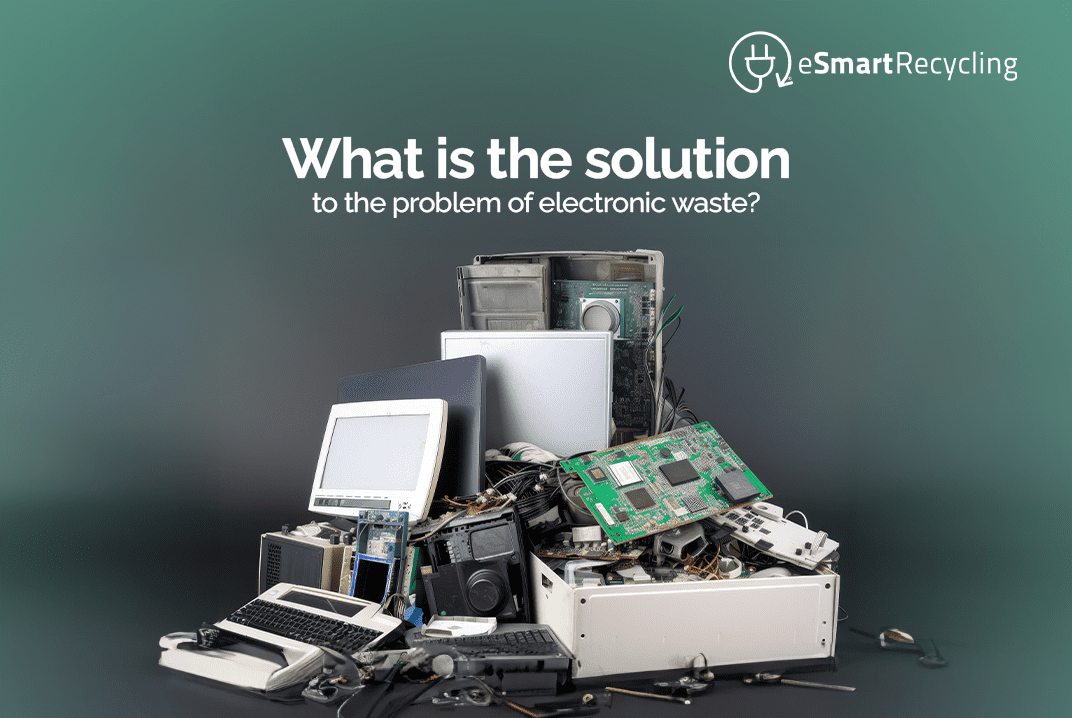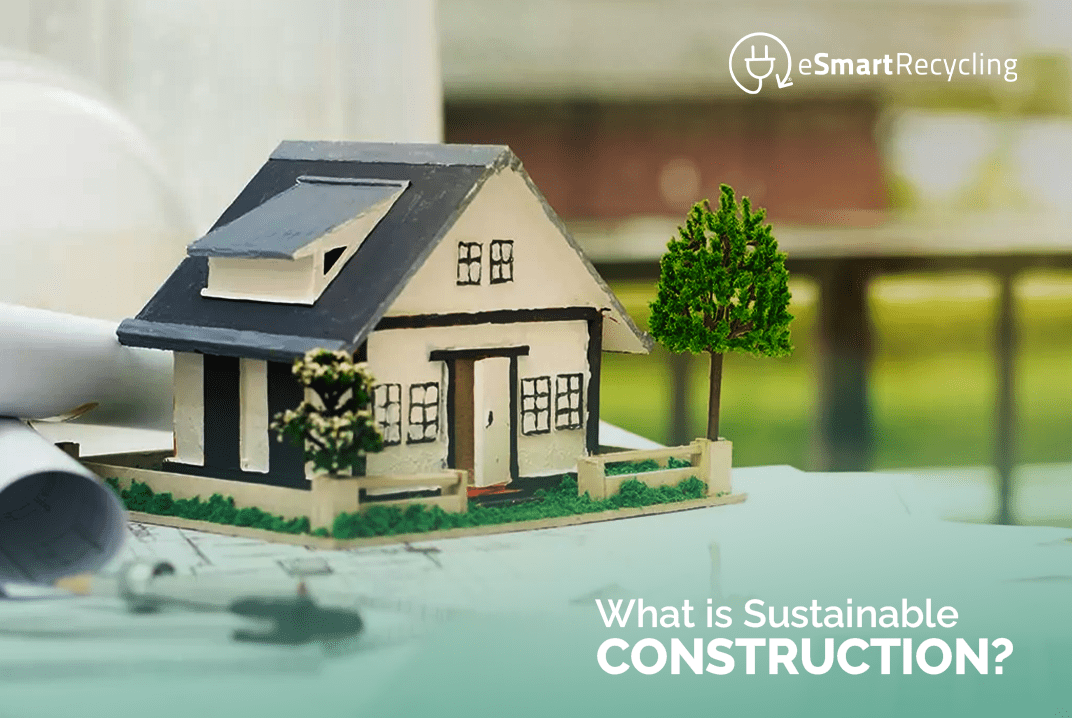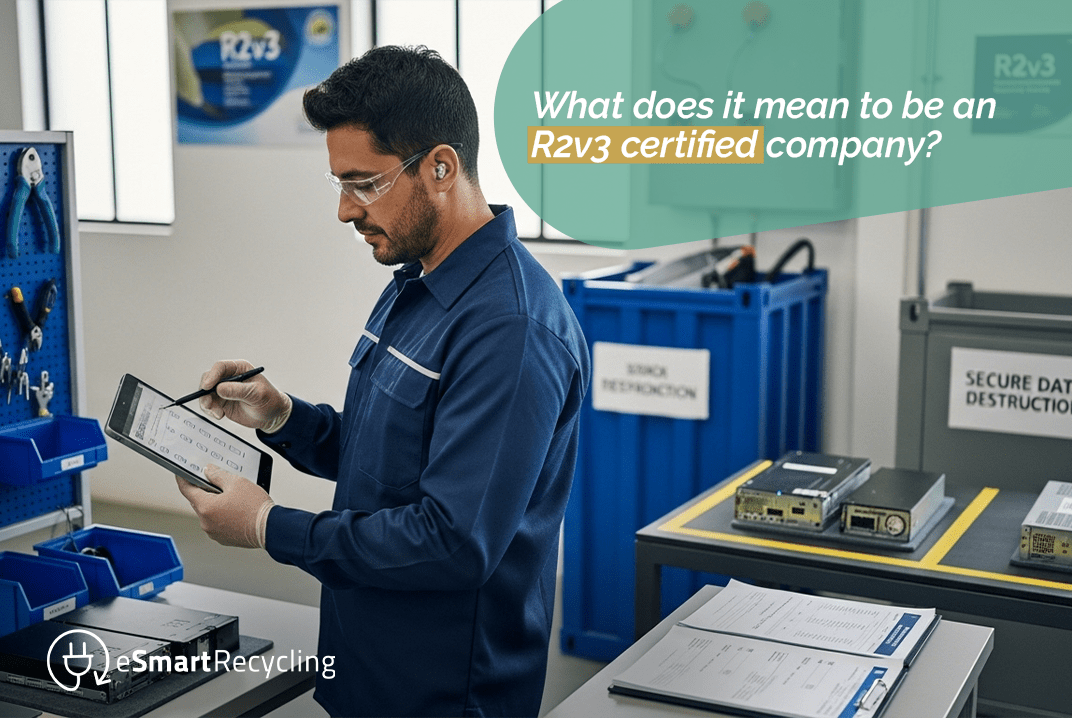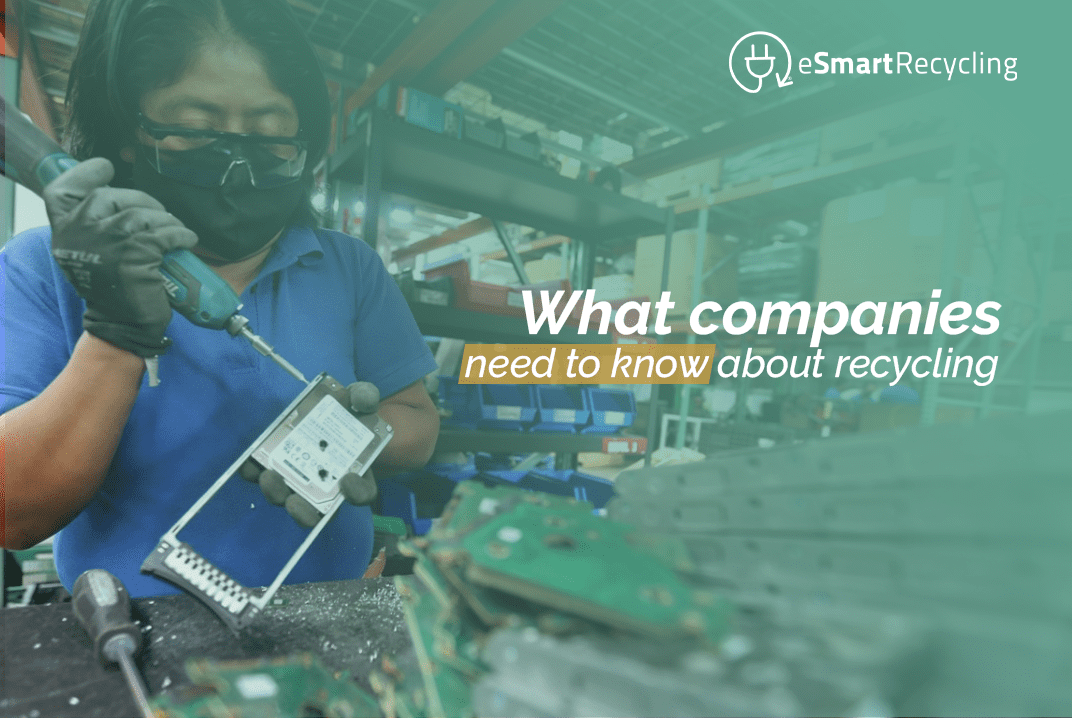eRecycling News & articles
Join our community for exclusive insights, latest updates, and special offers delivered straight to your inbox.
Be part of the e-Revolution and subscribe to our newsletter
December 9, 2025
Electronic waste —or e-waste— is piling up at an alarming rate, with consequences comparable (and in some ways worse) than those of plastic. For companies in the U.S. committed to sustainability, understanding this issue is no longer optional: it has operational, legal, and reputational implications.
Why e-waste is such a big deal
In 2022, the world generated around 62 million tons of electronic waste, a figure projected to reach 82 million by 2030.
Only about 22 % of that amount was formally collected and recycled.
Just like plastic decades ago, e-waste often ends up hidden in storage rooms or landfills, quietly building up. Ignoring it might seem harmless —until it isn’t.
The parallels with 21st-century plastic
1. A growing flood
E-waste follows the same pattern as plastic did: short product lifespans, multiple devices per person, and products that are hard to repair.
Companies constantly upgrade equipment, but very few plan for what happens after.
2. Toxic, persistent materials
Electronics contain heavy metals like lead, mercury, and cadmium, along with brominated flame retardants. When dumped or processed informally, these elements contaminate soil, air, and water.
Like plastic, e-waste doesn’t just disappear —it lingers.
3. Hidden value
Inside those discarded devices lie valuable materials: gold, silver, copper, and rare earth elements. Every ton of e-waste left unprocessed means losing resources that could feed back into supply chains.
Treating e-waste as “the new plastic” means recognizing that what looks like trash may still hold significant value.
What this means for your U.S.-based business
If your organization upgrades laptops, desktops, printers, routers, or cables, how you manage the old ones should be part of your sustainability plan.
With us at eSmart Recycling, we handle secure data destruction compliant with HIPAA, provide detailed inventory audits, and reinvest around 30 % of proceeds into repairing and donating devices to underserved communities.
Improper e-waste management can also create legal risks —while there’s no single federal law, most U.S. states have regulations covering electronics disposal.
Done right, it’s more than compliance: it builds credibility and trust with customers and partners.
Smart practices your company can adopt
- Reuse before recycling —donate or repurpose devices whenever possible.
- Work with certified recyclers who guarantee data destruction and full traceability.
- Keep documentation of every stage: collection, transport, recycling, data wiping, and donation.
- Educate your teams internally so that e-waste becomes as visible as plastic or packaging waste.
Why call it the “new plastic”?
Because e-waste has become what plastic was decades ago: cheap, convenient, and everywhere. It’s piling up fast, and only a small fraction gets recycled. The difference is that this time, we can act before it’s too late.
At eSmart Recycling, we believe in giving technology a second life —protecting the environment while connecting people who need access the most.
December 9, 2025
New regulations are coming, and if your business handles tech equipment, you’ll want to be ready. At eSmart Recycling, we collect and recycle corporate technology responsibly—helping companies meet compliance without stress.
What’s changing in 2026?
The U.S. still doesn’t have one single federal law for electronic waste. Instead, more states are passing Extended Producer Responsibility (EPR) laws, which require companies to manage the full life cycle of their products.
The EPA is also developing a national EPR framework for batteries, signaling tighter oversight of tech and electronic waste by 2026.
In short, if your business owns, sells, or disposes of IT equipment, you’ll need to:
- Prove traceability and secure data destruction,
- Comply with state-specific e-waste laws, and
- Report how your hardware is recycled or reused.
Step 1: Know which laws apply to you
Different states, different rules.
If your company operates across several locations, map out where e-waste and packaging EPR laws are already active.
Also, check which devices contain sensitive data—because disposal without secure erasure can violate privacy laws such as HIPAA.
Step 2: Build a real tech disposal system
That means:
- collecting all unused hardware (laptops, printers, routers, cables),
- auditing every item and its data,
- destroying data safely following NIST 800-88,
- refurbishing and repurposing usable equipment, and
- generating proper certificates for destruction and social/environmental tracking.
That’s what we do at eSmart Recycling. We handle every stage—from pickup to final reporting—so your compliance paperwork is covered, and your data stays protected.
Step 3: Prove it
Saying “we recycle” isn’t enough anymore. Regulators and clients want evidence.
Include your e-waste and recycling stats in ESG or sustainability reports.
Work only with certified tech recyclers (like us).
And document your data destruction and donation processes to show that devices truly reached a responsible end.
Step 4: Stay ahead of future controls
Many state EPR laws will start requiring producer registration and reporting by 2026.
Being compliant early doesn’t just protect you—it gives you a competitive edge. You’ll be able to say: we’re already ready for 2026.
At eSmart Recycling, we collect and recycle corporate tech, audit every device, securely erase data, and donate refurbished equipment to communities that need it most.
Preparing for 2026 starts with doing things right today.
December 9, 2025
When a company decides to recycle its technology with us, two things matter most: keeping data secure and giving devices a second life. At eSmart Recycling, we make both happen, and we make it easy.
1. Schedule your pickup
The first step is simple: schedule your pickup. You can do it directly at esmartrecycling.com or by emailing info@esmartrecycling.com. Our team will coordinate the best date and time for your organization.
If you’re in Tampa Bay, you can also drop off your equipment for free at one of our Community Collection Partners — local businesses and nonprofits that help us collect technology safely across the city.
2. Secure and trackable collection
Our team arrives with everything needed to handle your equipment safely. Every batch is tagged and recorded with a unique tracking number. That traceability follows the R2v3 and NAID standards, ensuring responsible processing and strict data separation (SERI, 2024).
3. Audit and certified data destruction
Once the equipment arrives at our Tampa facility, we conduct a full audit of all devices. Anything that stores data goes through a certified destruction process that meets HIPAA and NIST 800-88 standards used in U.S. healthcare and financial institutions (NIST.gov).
Nothing is “partially wiped.” Every hard drive receives a digital certificate of destruction — so you know exactly what was done and when.
4. Sorting and refurbishment
Not everything gets destroyed. A significant portion of the equipment can be repaired and reused. Our technicians clean, test, and refurbish those devices, preparing them for community programs that donate computers to children and families without access to technology.
As of 2025, we’ve delivered over 3,000 refurbished devices, reaching schools and communities both locally and abroad.
5. Responsible recycling
For items that can’t be repaired, our team dismantles them piece by piece. Each component — metals, cables, plastics, and screens — is sent to certified recyclers within the U.S., ensuring that materials re-enter the production cycle correctly and safely, avoiding illegal exports or environmental contamination (EPA, 2024).
6. Final report and certification
At the end of the process, your company receives a complete report including:
- Certificates of data destruction
- Material recovery summary
- Estimated environmental footprint savings
This report helps you meet compliance requirements while demonstrating a genuine commitment to sustainability.
Recycling your technology with us isn’t just a task — it’s a practical way to protect the environment, keep your data safe, and create social value.
And it all starts with one click: schedule your pickup today.
December 9, 2025
When a company takes tech recycling seriously, it strengthens its reputation among clients, partners, and investors. A well-executed recycling program shows that the organization cares about environmental responsibility, data security, and social contribution. At eSmart Recycling, we collect electronic equipment—computers, laptops, printers, routers, cables—safely audit and destroy data, assess and refurbish devices, and donate part of them to communities in need. Here’s how that directly supports your corporate reputation.
Why tech recycling matters for reputation
Protects your brand from data and waste risks
Technology devices often store sensitive information. Poor disposal can lead to data breaches, fines, or brand crises. According to GreenCitizen, “responsible computer recycling… supports resource recovery, ensures compliance, protects data … and strengthens stakeholder trust.”
Similarly, E-Waste Solutions USA notes that “a proactive approach to e-waste management … contributes to … brand reputation.”
When clients or investors evaluate your business, they look at how you manage obsolete technology. If you do it with a certified partner that guarantees traceability, it builds credibility and trust.
Attracts conscious talent and customers
Research on corporate electronics recycling shows that “a strong commitment to CSR, including responsible electronics recycling, can also help organizations attract and retain talented employees who are passionate.”
In a market where sustainability drives decisions, having a visible tech recycling program becomes a key differentiator.
Meets regulations and strengthens ESG reporting
The North American e-waste management market is expected to reach USD 33.33 billion by 2025. This means growing pressure for compliance and transparency.
By managing your obsolete tech correctly, you can document custody chains, certifications, and measurable results—making your ESG reports stronger and more credible.
Real examples of how recycling translates into reputation
- HP Inc. has committed to reusing and recycling materials in its products, a decision that directly reinforces its reputation as a responsible brand.
- According to First America, keeping full documentation of what gets recycled and how data is destroyed helps companies enhance their reputation with clients and stakeholders.
The takeaway: partnering with certified recycling providers allows you to communicate transparent actions that strengthen your company’s reputation.
How we at eSmart Recycling support your reputation
At eSmart Recycling, we collect tech from individuals, companies, and institutions; audit, inventory, and securely destroy data under standards like HIPAA; assess and refurbish equipment; allocate about 30 % of our revenue to repairing and donating devices; and issue destruction certificates and environmental/social reports.
For your company, that means:
- Full traceability of all devices you dispose of.
- Documentation you can include in ESG or sustainability reports.
- Visible action for your stakeholders: reducing e-waste and supporting digital inclusion.
- A partner that helps your reputation grow stronger with every recycled device.
Three practical ways to make the most of it
- Create an inventory of unused tech and consider its value beyond the shelf.
- Work with a certified recycling partner that provides data, certificates, and measurable outcomes.
- Communicate internally and externally how you’re managing tech disposal safely and responsibly.
For sustainability leaders in the U.S., responsible tech recycling isn’t just a compliance step—it’s a statement of credibility and care that reinforces what your brand stands for.
December 9, 2025
When your company needs to recycle tech equipment, the most important thing is to work with a partner that’s certified, transparent, and safe. Here’s how to choose the right one — and how we do it at eSmart Recycling.
What certifications should your recycling partner have?
A solid indication that a recycling company does things right is certification under standards such as R2 or e-Stewards. The U.S. Environmental Protection Agency (EPA) recommends working only with recyclers certified under one of these programs.
- R2 Certification covers the entire recycling chain — from the main facility to downstream vendors — ensuring equipment is reused or recycled properly.
- e-Stewards Certification applies even stricter requirements, such as prohibiting export to countries with weak regulations and guaranteeing complete data destruction.
When evaluating a partner, make sure they’re certified under R2 or e-Stewards and that their certification is current and verifiable.
Key questions to ask a recycling partner
To confirm you’re dealing with a legitimate, responsible recycler, here are questions worth asking:
- What certifications do you hold? Can you provide a current certificate?
- How do you destroy data? Do you comply with standards like NIST SP 800-88 for media sanitization?
- What’s your process from collection to final disposal? Can you track and report what happens to the collected equipment?
- Do you provide a certificate of destruction or recycling?
- Do you work with corporate clients and handle large-scale or multi-location projects?
Why this matters for your business
A recycler that lacks proper certifications or processes can expose you to serious risks — from data leaks to regulatory fines or reputational damage. Data breaches cost companies millions of dollars each year.
Choosing the right partner also ensures that your retired equipment doesn’t end up in unregulated landfills or shipped overseas under unsafe conditions. Instead, it can be refurbished and placed back into use — supporting schools, nonprofits, and families who need it most.
How we do it at eSmart Recycling
We collect technology from individuals, businesses, and institutions — computers, laptops, printers, routers, and cables. Every item is audited, inventoried, and wiped clean according to strict standards like HIPAA, when applicable. Approximately 30% of our revenue is allocated toward refurbishing and donating devices to underserved communities in the U.S. and abroad.
We provide full documentation — from certificates of data destruction to environmental and social reports — so our partners know exactly what happened to every device.
If you’re in the U.S. and looking for a certified electronics recycling partner that’s serious about both security and people, that’s what we do.
Choose a partner with R2 or e-Stewards certification, secure data destruction, transparent processes, and proper documentation. That way, your company’s retired technology is handled responsibly — and if you’d like to add a social purpose to that process, we’d be glad to help.
December 9, 2025
Turning your IT policy into a sustainability policy means taking a full look at your technology lifecycle —from acquisition and usage to renewal and final disposition. At eSmart Recycling, we help companies and institutions take that step: we collect IT equipment, securely destroy data, revalue devices, and, when possible, give them a second life in community programs that need them most. Here’s how you can make it part of your corporate strategy, too.
Why your IT policy should include sustainability
Most organizations treat their IT policy as a technical document about hardware, software, and security—without considering the environmental or social consequences of technology management.
But the numbers are clear: global e-waste is growing fast. The Global E-waste Monitor 2024 reports that 62 million metric tons of e-waste were generated in 2022, and only 22.3% was properly collected and recycled.
That means two things: a major risk (data leaks, toxic waste) and a major opportunity (resource recovery, transparency, corporate reputation). Updating your IT policy to include sustainability ensures that every device your company uses has a responsible end-of-life plan.
Key components to include in your IT sustainability policy
1. Asset inventory and auditing
Start by knowing what you have —servers, laptops, monitors, printers, routers, and accessories. Then, define each device’s lifecycle: when it’s purchased, maintained, replaced, and retired. This allows you to reuse or repurpose equipment before discarding it.
2. Data security + responsible disposition
When devices reach the end of their life, they must be audited and securely wiped in compliance with data protection standards such as HIPAA. That’s exactly what we do at eSmart Recycling: collection, inventory, and certified data destruction —with full documentation and peace of mind.
3. Reuse, revaluation, and redistribution
Not all old devices are waste. Many can be repaired or refurbished and redirected to educational or community initiatives. Around 30% of the recovered value from our recycling operations goes toward refurbishing and redistributing technology where it’s needed most. That’s what circular technology looks like.
4. Measurement and reporting
For your IT policy to have real weight, it needs measurable results:
- How many devices were collected?
- How many were reused or recycled?
- How much electronic waste did you prevent from reaching landfills?
According to the Global E-waste Monitor 2024, only about 22% of global e-waste is properly recycled —a number your organization can help improve by tracking progress and setting annual sustainability targets.
5. Certified recycling partnerships
Sending your devices to a random recycler is not enough. The U.S. Environmental Protection Agency (EPA) recommends working only with certified electronics recyclers who can ensure traceability, responsible handling, and material recovery.
At eSmart Recycling, we’re certified under R2v3, the industry’s leading standard for responsible electronics recycling, data destruction, and traceability.
What this looks like in practice
Let’s say your IT department retires laptops every four years. Under a sustainable IT policy:
- You log and audit each device.
- Working laptops are refurbished and integrated into local community or educational programs.
- Non-working devices are securely wiped, then recycled through an R2v3-certified process.
- At the end of the quarter, you report: “120 laptops processed —40 refurbished, 80 recycled— preventing the extraction of new materials.”
That’s not just policy —that’s responsible technology management in action.
How can we help
We handle every step of the process —from secure pickup and certified data destruction to reuse programs and measurable environmental results. Whether you’re a small business or a large corporation, we help turn your IT operations into a sustainability asset.
If your company is ready to upgrade its IT policy responsibly, contact us today, and let’s make it happen together.
December 1, 2025
When children have real access to devices and connectivity, learning to code stops being a luxury — it becomes a tool for personal and community growth. Studies show that in the U.S., access still varies significantly by income and education level. For example, in 2021, 93% of children ages 3 to 18 had internet access at home through a computer, but that number dropped to 78% when their parents did not complete high school.
At eSmart Recycling, we work to make sure the kids who are usually left behind also get a fair chance to connect, learn, and create.
Why learning to code is about more than just code
Coding goes far beyond technical knowledge: it helps develop logic, structured thinking, collaboration, and creativity. Research shows that children exposed to coding classes demonstrate improvements in planning, problem-solving, and executive function.
It also fosters self-expression and teamwork — it’s not just about “following instructions”.
For companies and sustainability leaders, enabling access to technology doesn’t just “tick a CSR box.” It genuinely changes life trajectories.
Where the technology gap begins
Although it may seem like “everyone has internet,” the reality is more complex. In the U.S., children whose parents hold a college degree have a 98% rate of computer-based internet access, compared to just 78% among those whose parents did not complete high school. Another study estimated that up to 15–16 million K-12 students lacked adequate devices or connectivity during the pandemic.
These disparities limit a child’s ability to participate in coding programs or other digital learning opportunities — even when classes are available.
What happens when access is fair
When a child has a working computer, stable internet, proper software, and someone to guide them, measurable benefits appear:
- They can use platforms like ScratchJr, designed for early learners, to enter the world of programming.
- They shift from being consumers of technology to creators — building animations, games, or small projects fosters a sense of ownership.
- They learn persistence: coding teaches that an error isn’t the end. You debug, you try again, and you learn.
- Companies that support tech donation and reuse programs directly contribute to digital inclusion. That’s where we come in.
What we do
At eSmart Recycling, we collect electronic equipment — computers, laptops, printers, routers, cables, and more — then audit, securely destroy data, and revalue each device. Around 30% of the revenue is dedicated to repairing and donating technology to children, families, and underserved communities across the U.S. We also issue data destruction certificates and track the environmental and social results. Each device we restore helps a child gain access to the tools they need to learn coding from home or in a community space.
What companies can do
- Donate functional equipment or fund programs that collect and refurbish technology for communities in need.
- Sponsor coding courses or digital learning platforms for under-resourced youth.
- Partner with local digital learning programs to ensure donated devices are used for real programming activities.
- Measure and report results — how many devices were donated, how many kids gained access, and what digital skills improved.
Ensuring fair access to technology for children is not just a sustainability initiative; it’s a concrete way to open doors to coding education and all the benefits that come with it. When a child receives a refurbished laptop, an entire world opens up. We’re here to make sure that the world reaches them.
December 1, 2025
Recycling old tech equipment isn’t as complicated—or as risky—as many people think. Whether you manage sustainability at a company or handle hardware upgrades, understanding and debunking the main myths about electronic recycling is key. Here are the most common ones and what’s actually true.
Myth 1: “Recycling electronics doesn’t make a real difference.”
The truth: It absolutely does.
Many assume that throwing away an old computer or server doesn’t have much environmental impact. But according to the United Nations University, the world generated 62 million metric tons of e-waste in 2022, and that number could reach 82 million by 2030.
Those discarded devices also contain valuable metals like gold, silver, and copper.
At eSmart Recycling, we see it every day: every device collected, audited, and refurbished prevents toxins from entering landfills and keeps resources in use longer.
Myth 2: “Only big devices are worth recycling.”
The truth: Size doesn’t matter.
People often think that TVs, printers, and large monitors are the only items worth recycling. In reality, small tech like routers, cables, laptops, and tablets also contain hazardous materials and valuable components. For companies, that means no piece of hardware should be ignored—everything has value when managed properly.
Myth 3: “You can recycle electronics in the regular recycling bin.”
The truth: Electronic waste requires specialized handling.
E-waste contains materials like lead, mercury, and cadmium, which must be processed differently from plastic or cardboard.
Most local recycling programs aren’t equipped to destroy data or safely disassemble devices.
That’s why at eSmart Recycling, we handle the full process: collection, secure data destruction (in compliance with HIPAA), and evaluation for reuse or donation. When your company upgrades hardware, always choose a certified partner.
Myth 4: “Deleting files is enough to protect my data.”
The truth: Simple deletion isn’t secure.
Formatting or resetting a hard drive doesn’t guarantee that data is gone for good. Experts confirm that information can often be recovered if not properly destroyed.
At eSmart Recycling, we follow strict data destruction protocols, maintain chain-of-custody tracking, and issue certificates of destruction—so companies have full proof of compliance.
Myth 5: “Recycled electronics end up in unsafe landfills overseas.”
The truth: It depends on the recycler.
There have been cases of illegal or irresponsible e-waste export. But standards like R2v3 and e-Stewards exist to prevent that and ensure responsible recycling.
When your company works with a certified and transparent partner, you can be confident your devices won’t end up dumped or dismantled without oversight. At eSmart Recycling, we operate under R2v3 certification and provide full traceability.
What can sustainability leaders do?
- Verify that your recycling partner is certified (R2v3, e-Stewards) and provides chain-of-custody documentation.
- Include auditing, inventory, and data destruction as part of your hardware renewal process—this is standard for us at eSmart Recycling.
- Reuse before you discard: refurbishing or donating extends the life of devices and supports digital inclusion.
- Keep records: document materials recovered, devices donated, and certificates of destruction. Transparency builds trust with auditors and stakeholders.
Recycling technology isn’t just a task—it’s a responsibility. Every laptop or server carries valuable materials, sensitive data, and the chance for a second life.
At eSmart Recycling, that’s what drives us: protecting the planet, securing information, and giving devices a meaningful new purpose.
Doing it right might take a bit more effort, but it always leaves a cleaner trace.
December 1, 2025
When your company retires old devices without a rigorous process, it’s placing itself at risk of data breaches, compliance penalties, and reputational damage. If you spot any of the red flags below, it’s time to reevaluate your endpoint disposal. As part of our work at eSmart Recycling, we specialise in secure data destruction, reuse, and recycling of corporate electronics — so we know what to look out for.
Why secure disposal of IT assets matters
Improper disposal of IT assets is increasingly a source of data exposure. Research finds that organisations are leaking sensitive information because end-of-life devices are discarded without sufficient sanitisation. For example, one source shows that 30% of breaches had third-party involvement or poor disposal practices.
In practical terms, if you don’t know where your retired devices are or how their data was handled, you leave a gap that attackers can exploit.
Sign 1: No clear inventory of retired devices
If your company doesn’t maintain a detailed inventory of what devices are being retired, where they go, and who handles them, you may have assets “floating” unmanaged. One article emphasises that disposal should be as controlled as deployment.
What to do: Ensure all devices slated for disposal are logged, tracked, and assigned a responsible person. Update your asset register accordingly.
Sign 2: data is erased without certification
Simply formatting a hard drive or deleting files is not enough. Studies show that many end-of-life devices still harbor recoverable data because sanitisation was incomplete.
What to do: Use certified processes (for example, aligned to standards such as NIST SP 800‑88), require a certificate of destruction, and retain proof of data wiping or physical media destruction.
Sign 3: You’re ignoring regulatory or industry compliance
Depending on your sector, regulations such as HIPAA (healthcare) or PCI DSS (payment card industry) may apply. One article warns that failure to follow proper disposal processes can lead to legal risk.
What to do: Identify which regulations apply to your business. When you engage a disposal partner, ensure they comply and can provide documentation.
Sign 4: donated or recycled devices without proper control
Donating or recycling equipment is often positive, but if devices haven’t been cleared of data or you don’t know the chain of custody, the risk remains. For example, one case described an institution that donated devices with student records still accessible.
What to do: Whether you donate, reuse, or recycle, each device should pass through your secure disposal pipeline: auditing, data removal, certified destruction (or reuse), and tracking of final destination.
Sign 5: no reporting or final-destination documentation
If your company doesn’t require and retain disposal reports, certificates of destruction, or details on where each device ended up, you lack evidence that the process was done correctly. As a result, if a breach happens, you may be unable to show due diligence.
What to do: Insist on disposal partners delivering: (a) certificate of data destruction; (b) statement of equipment final destination (reused/resold/recycled); (c) metrics if applicable (e.g., number of devices reused, environmental benefit).
How to begin fixing the issue
- Conduct an internal audit: list all end-of-life devices, check who is responsible for their removal, and review how they are handled.
- If you don’t currently have a specialised provider, consider working with us at eSmart Recycling — we collect equipment, audit it, wipe/destroy data, and reuse/donate or recycle responsibly.
- Create a written policy for asset disposition: define when a device is retired, who approves it, what process applies, and what documentation must be kept.
- Train your IT staff and anyone handling retired equipment: make them aware that this isn’t just “moving old devices out” — it’s a data-risk mitigation step.
- Maintain full documentation: even if no incident arises, having the trail will help defend your company if ever questioned.
Retiring equipment without a secure process isn’t simply “clearing shelves” — it’s a vulnerability waiting to be exploited. At eSmart Recycling, we handle this every day: secure data wiping, verified reuse where possible, and proper recycling where needed. If you recognise any of these signs in your organisation, act now. Your data, your customers, and your reputation will be safer for it.
December 1, 2025
Digital inclusion: why access to technology still matters
Access to technology is no longer optional — it’s essential. It defines how companies operate, how people connect, and how communities grow. For businesses that care about sustainability and social responsibility (like us at eSmart Recycling), understanding digital inclusion is key to creating long-term value.
What is digital inclusion?
Digital inclusion means ensuring that people and communities have access to the right devices, reliable internet, the necessary skills to use them, and opportunities to engage with meaningful digital content. According to the Internet Society, the digital divide is no longer just about infrastructure — it’s about how technology is used and who can truly benefit from it.
In the U.S., around 18 million households either rely solely on a smartphone or lack a personal computer altogether. That means millions are still unable to participate in education, work, or civic life fully.
Why it matters for companies and their partners
1. It boosts collaboration and talent development
Most jobs today require at least some level of digital skill. The National Skills Coalition found that 48 million U.S. workers lack basic digital skills. When employees or suppliers fall behind digitally, productivity and innovation suffer.
2. It creates measurable social value
Supporting digital inclusion — through donations, training, or access to refurbished devices — strengthens both brand reputation and community well-being. At eSmart Recycling, we collect and audit electronics, securely destroy data, and recondition devices to give them a new life in the hands of families and schools that need them.
3. It aligns with environmental sustainability
Digital inclusion also supports circular economy goals. Extending the life of electronic devices reduces e-waste and carbon emissions. Each reused laptop or desktop means fewer resources mined, manufactured, and discarded.
The main barriers today
- Connectivity and cost: While internet penetration in the U.S. exceeds 93% in 2025, affordability and reliability are still issues, especially in rural or low-income areas.
- Digital skills: Access alone isn’t enough. Many people still lack the knowledge to use technology productively.
- Adequate devices: Smartphones help people connect, but they’re not enough for work, learning, or collaboration.
- Relevant content: Digital tools need to meet people where they are — culturally and linguistically — or else they go unused.
What can companies do right now?
- Join device donation and reuse programs — partner with organizations like eSmart Recycling to recover and revalue old equipment responsibly.
- Invest in digital skills training for employees and local communities to strengthen their participation in the digital economy.
- Assess connectivity within your network — don’t assume every partner or supplier has equal access.
- Track and report results — measure how many devices were refurbished, how many people gained access or training, and what changed as a result.
Digital inclusion isn’t a side project — it’s part of building sustainable, connected communities. Companies can start by collecting their unused devices, partnering with certified recyclers, and helping close the access gap.
At eSmart Recycling, we already do this every day: we collect, audit, refurbish, donate, and certify data destruction. That’s how technology finds a new purpose — and how inclusion grows.
December 1, 2025
Tech companies can change the way they design products by applying the principles of circular design: reducing waste, keeping materials in use for longer, and regenerating natural systems. These three ideas help companies like ours, eSmart Recycling, extend the life of electronic devices while supporting vulnerable communities.
What circular design means for tech companies
Circular design means creating products that are durable, repairable, reusable, and recyclable—considering every stage of the product’s life cycle: raw materials, manufacturing, use, and end-of-life.
For tech companies that make or handle devices like laptops, routers, or cables, this approach helps cut down e-waste and recover value. The U.S. Environmental Protection Agency (EPA) defines a circular economy as one that keeps products and materials in circulation for as long as possible and eliminates the idea of “waste” through smarter design.
The three main circular design principles for tech
1. Eliminate waste and pollution
When designing electronics, key questions include: can the device be easily disassembled? Does it contain toxic materials that make recycling harder? The Ellen MacArthur Foundation highlights eliminating waste and pollution from the design stage as a core pillar of circularity.
In practice, this might mean using recycled plastics, reducing complex fastenings, documenting disassembly processes, and setting up take-back programs for obsolete equipment.
2. Keep products and materials in use
This principle encourages design for reuse, repair, upgrade, and recycling.
Examples include laptops that let users replace batteries or drives, or routers with casings that can be reused with new boards. Some companies are also adopting “as-a-service” business models, where the manufacturer collects, refurbishes, and redeploys products to keep materials circulating.
Dell Technologies, in its circular economy roadmap, emphasizes designing for repairability, reusability, and recyclability as key steps toward its net-zero goals.
3. Regenerate natural systems
This idea goes beyond preventing harm—it’s about restoring value to ecosystems.
For technology, this could mean feeding recovered materials back into production cycles, using renewable energy in manufacturing or refurbishing processes, and reducing the footprint of resource extraction.
How to bring circular design into your tech company
- Map the full life cycle of your devices—from sourcing to disposal—and identify waste or risk points.
- Create internal take-back programs, like the one we run at eSmart Recycling, where devices are audited, data is securely destroyed, and equipment is refurbished or recycled.
- Design modular components that are easy to repair or upgrade, cutting down on obsolescence costs.
- Prioritize recycled or renewable materials and processes powered by clean energy.
- Work closely with suppliers, recyclers, and nonprofits to ensure end-of-life products are truly brought back into circulation. This collaborative approach aligns with expert recommendations for value-chain cooperation.
Adopting circular design isn’t just about environmental responsibility—it’s also good business. Reducing waste, extending product life, and returning materials to circulation help strengthen community programs like ours at eSmart Recycling while improving long-term sustainability.
November 14, 2025
The question is straightforward: what happens when several organizations coordinate to give veterans access to technology and digital training? This recent deployment offered a clear answer. A group of 47 veterans in the Operation: Veteran Connect program received refurbished laptops to stay connected to their routines, families, and educational resources.
Why did this deployment take place?
Many veterans still face barriers that limit their ability to use technology. A report from the Federal Communications Commission (FCC) noted that 2.2 million veteran households lack fixed broadband, mobile broadband, or both, and that veterans are more likely than non-veterans to cite the absence of a computer or an adequate device as a key reason for not adopting digital services. The report also mentions that many veterans live in rural areas and that older veterans often have fewer digital skills.
This deployment aimed to provide a reliable device ready for use, along with training sessions facilitated by Community Tech House. The goal was to help participants handle everyday tasks, take online courses, or communicate more easily.
How the deployment came together
At eSmart Recycling, we handled equipment collection, secure data destruction, and device preparation. Our corporate partners — AVISPL and the University of South Florida (USF) — donated the equipment they no longer needed. We then took care of the audit process, secure data wiping, and refurbishment.
After that step, the Digital Education Foundation, together with Seniors in Service and Community Tech House, delivered the laptops and guided the veterans through digital lessons tailored to their needs.
The day of the deployment had a relaxed, friendly tone. Some veterans took their time exploring the keys; others mentioned they hadn’t had a personal device in years, and several talked about wanting to reconnect with family members or continue online learning opportunities.
Who participated
The recipients were 47 veterans from the Operation: Veteran Connect program. They came with different backgrounds, ages, and reasons for wanting a laptop: staying in touch with loved ones, improving digital skills, managing VA-related tasks, or simply having a device they could depend on.
This result was possible thanks to coordinated work across community groups, companies that recycle their equipment with us, and organizations dedicated to digital education.
Deployments like this one will continue as long as there is collaboration between Seniors in Service, Digital Education Foundation, Community Tech House, our corporate partners, and our team at eSmart Recycling. Each program allows more veterans to use technology they previously did not have access to.
We invite companies interested in recycling their equipment to work with eSmart Recycling. Your participation helps us prepare more laptops and support more people in future deployments.
November 11, 2025
Artificial intelligence (AI) is changing the way the world deals with electronic waste.
While the planet is producing record amounts of tech trash — 62 million metric tons in 2022, according to the Global E-waste Monitor 2024 — new AI-powered solutions are emerging to classify, reuse, and recycle electronics with unprecedented precision.
But it’s not all as clean as it sounds. The same technology that helps reduce e-waste also consumes enormous amounts of energy, water, and raw materials to exist.
How AI is helping reduce e-waste
1. Smarter sorting
Across recycling plants in Europe and Asia, AI systems can now identify and sort electronic materials with incredible accuracy. Computer-vision cameras recognize metals, plastics, and components in seconds, allowing facilities to separate recoverable parts from true waste.
This increases recovery rates and reduces human error during sorting.
2. Predicting device lifespan
AI is also being used in predictive maintenance — analyzing how devices behave and spotting early signs of wear before they fail. Companies like Dell and HP use algorithms to extend product lifespan and cut down on premature returns. That means fewer devices discarded too soon — and less waste overall.
3. Reuse and traceability
AI helps manage tech inventories and track which devices can be refurbished, resold, or recycled.
In some countries, it’s being used to map entire e-waste flows and pinpoint regions where formal recycling systems still can’t reach. (weforum.org)
The contradiction we can’t ignore
AI’s rise also comes with a significant environmental cost.
- Higher energy demand: data centers powering AI models could double their global electricity use by 2030.
- Massive water use: cooling AI servers can require millions of liters of water per day, especially in warmer regions.
- More hardware, more waste: the race for faster chips and larger models drives constant hardware replacement. The AI boom alone could increase global e-waste by 3 % to 12 % by 2030.
In short, AI helps clean part of the problem… while also contributing to it.
How AI could truly help
The potential is there — if used responsibly. AI could make a real difference by:
- Designing longer-lasting, modular products that are easier to repair and reuse.
- Optimizing collection and transport of e-waste to cut costs and emissions.
- Identifying valuable materials before recycling prevents them from ending up in landfills.
- Improving data tracking and education, helping governments and businesses understand where and why e-waste is generated.
The future of e-waste recycling will depend less on algorithms and more on how people choose to use them.
AI can be a powerful ally in reducing e-waste — as long as we remember that progress starts with human choices, not just smart machines.
November 11, 2025
At eSmart Recycling, we like to look ahead. Our daily work revolves around the present — collecting, recycling, and refurbishing equipment — but we’re also driven by a bigger question: what will technology look like when it finally becomes truly sustainable?
So, we decided to do something different. We asked AI to help us imagine what future devices might look like if they were built to last, repair themselves, and recycle cleanly.
The answers were fascinating — and closer than you might think.
What it means when AI “imagines” hardware
When we say AI “sees” future devices, it’s not science fiction.
Today’s models can already analyze massive data sets on design trends, materials, and energy efficiency to predict what’s coming next.
In the energy sector, for instance, AI is already being used to anticipate demand peaks and optimize power grids, cutting waste and emissions. That same intelligence, applied to hardware, could help create durable, recyclable, and energy-autonomous devices.
Six sustainable devices AI might imagine
During this experiment, our team identified six concepts that AI envisions as possible in the near future. Some are already in development; others still sound like something from a design lab of tomorrow.
1. Regenerative modular smartphone
A phone designed to last more than a decade.
- Each module (screen, camera, battery, chip) can be replaced without discarding the rest.
- AI monitors performance, diagnoses wear, and suggests precise repairs.
- The casing repairs itself through smart materials that seal micro-cracks with heat or light.
This merges the spirit of Fairphone with the potential of smart, self-healing materials.

2. Adaptive solar laptop
A portable computer covered with flexible photovoltaic film and powered by AI-driven energy management.
- It learns your usage patterns to optimize brightness, temperature, and performance.
- Reduces power when idle or running light tasks.
- Built from recycled aluminum and low-impact chips.
A natural step toward circular, low-emission electronics.

3. Smart circular home battery
An energy-storage system that manages itself.
- Internal sensors and AI track the chemical cycle to extend its lifespan.
- Notifies users when to recycle and which materials can be recovered.
- It can redistribute power across nearby devices when demand drops.
This kind of system is already being explored for solar grids and smart homes.

4. Eco-sensor router
A Wi-Fi router designed with environmental awareness in mind.
- Automatically adjusts signal power based on the number of connected users.
- Monitors temperature, humidity, and air quality.
- Built with recycled or biodegradable materials.
Routers powered by AI already exist; adding environmental sensors is the logical next step.

5. Self-recycling enterprise server
A data server that manages its own energy and life cycle.
- Uses AI to distribute workloads, shut down inactive modules, and track consumption.
- Every component has a digital ID for traceability from manufacturing to recycling.
- Designed for easy disassembly at the end of life.
Companies like Google and Microsoft are already using AI to increase energy efficiency in their data centers.

6. Biodegradable educational tablet
Designed for school programs and underserved communities.
- Its casing is made from compostable bioplastics.
- Runs on solar energy and is a lightweight, offline AI software that adapts lessons to each student.
- It can be safely recycled without leaving toxic residues.
A tangible example of how sustainability can meet access to education.

Why looking ahead is part of sustainability
Semiconductor manufacturing still demands enormous amounts of water, energy, and rare materials. The future of technology depends on rethinking how we build, use, and reintegrate devices into the economy.
While these six ideas are at different stages of possibility, they share one goal: reducing waste, extending product lifespans, and protecting natural resources.
What we’re doing while that future arrives
While AI dreams up tomorrow’s devices, we’re focused on today’s. At eSmart Recycling, we collect used technology from businesses, ensure secure data destruction, recycle responsibly, and refurbish devices that still have life left.
Each device we recover helps close the digital divide and keep e-waste out of landfills. So while AI imagines the next generation of sustainable devices, we keep building sustainability through everyday action.
November 10, 2025
Recycling old tech isn’t just “getting rid of stuff.” Behind every computer, server, or phone, there are valuable materials, sensitive data, and environmental responsibilities that shouldn’t be ignored.
This guide walks you through the safe, responsible, and trackable way to recycle technology — the same process we follow every day at eSmart Recycling.
Step 1: Create an inventory and classify your equipment
The first step is simple but essential: know what you have.
An accurate inventory helps you plan and manage the process correctly.
- Include all devices: computers, printers, routers, cables, monitors, servers, and peripherals.
- Sort them by condition: working, repairable, obsolete, or beyond recovery.
- Identify those with batteries or components that require special handling.
We do this at every corporate pickup: we audit, label, and track each asset before moving it. That ensures transparency and total control.
Step 2: Protect your information with secure data destruction
Before recycling, every piece of data must be erased — permanently.
At eSmart Recycling, we use certified data destruction methods that meet HIPAA and NIST 800-88 standards.
If you’re preparing devices yourself:
- Back up what you need to keep.
- Use certified wiping or degaussing software.
- For drives that can’t be wiped, request physical destruction.
- Always ask for a Certificate of Data Destruction.
It’s not just about protecting information — it’s about protecting your company’s reputation and compliance.
Step 3: Separate batteries and special components
Many electronics contain hazardous materials such as lead, mercury, or lithium.
Separating batteries, screens, cables, and circuit boards prevents accidents and makes downstream recycling safer.
In our facility, we manually disassemble and classify components to guarantee proper recovery and treatment.
Step 4: Choose a certified recycling partner
Not all recyclers are the same. Work only with certified providers — ideally those with R2v3 or e-Stewards certification — and verified traceability.
A reliable recycler should offer:
- Secure pickup and logistics.
- Audited reports and batch certificates.
- Guaranteed responsible downstream processing.
At eSmart Recycling, we go a step further. Part of the recovered value from equipment is used to refurbish and donate computers to children and families who need them. That means your recycling effort also supports digital inclusion.
Step 5: Schedule pickup and get your certificates
Once your materials are ready:
- Arrange pickup with your recycler.
- Keep all transport and recycling documentation.
- Request your Environmental and Data Destruction Certificates.
We provide both certificates, along with a full traceability report and an environmental summary.
We also offer social and environmental impact reports so companies can communicate their results transparently.
Step 6: Share your results and make it a habit
Safe tech recycling shouldn’t be a one-time project.
Set up regular collections — annually or semi-annually — and include them in your sustainability reporting.
Every year, thousands of companies in the U.S. refresh their technology. When that equipment is handled properly, it prevents pollution, reduces emissions, and helps close the digital divide.
At eSmart Recycling, that’s exactly what we do.
We collect, audit, refurbish, and recycle devices — ensuring data security, environmental safety, and social good. Refurbished computers from our process reach schools and communities that otherwise wouldn’t have access to technology.
What starts as a technical process ends up creating human change.
If your company wants to recycle safely, transparently, and with purpose, this is the way to do it.
July 8, 2024
Are you looking for ways to make your business more sustainable? Have you heard of the concept of zero waste? In this article, we will delve into zero waste and show you how to achieve it in your business.
What is zero waste?
Zero waste is a concept aimed at eliminating waste from the production chain. This means that all materials, processes, and systems are designed to avoid the generation of waste. The zero waste concept also focuses on minimizing environmental impacts, especially those associated with waste production and disposal.
Why is zero waste important?
Zero waste is important because it can reduce the environmental impact of businesses. It not only reduces waste but also saves resources and optimizes production. Since waste reduction is a sustainability measure that can result in cost savings, it is also important for a company’s bottom line.
How to achieve zero waste in your business
Here are some steps you can take to achieve zero waste in your business:
-
Gain management support
Securing the support and commitment of management is essential for successfully implementing zero waste management in your business. Management must align with the plan’s goals and objectives and help guide the company towards the zero waste mission.
-
Evaluate your current operations
Before starting to implement a zero-waste plan, it is crucial to evaluate your current operations. This will help you identify areas for improvement to move towards zero waste. Consider all production processes and supply chain activities, and look for opportunities to reduce waste.
-
Design a zero-waste plan
Once you have evaluated your current operations, it’s time to design a plan. The plan should include concrete steps and performance metrics. Consulting the success stories of other companies can help create your zero-waste plan.
-
Engage employees
Engaging employees at all company levels is important for successfully implementing a zero-waste plan. Employees can offer valuable insights, ideas, and suggestions. They can also play a crucial role in the implementation and maintenance of the plan.
-
Monitor and continuously improve
Once your zero waste plan is in place, it’s important to monitor your results and continuously improve. Regularly evaluate your outcomes and look for areas of improvement. Analyzing data can help you identify trends and opportunities to enhance performance.
The future of zero-waste
Admittedly, zero waste can seem like an impossible goal. However, it is a goal worth striving for. It can reduce the environmental impact of businesses, improve efficiency, and save costs.
By following the steps outlined above, you can move your business towards zero waste. Good luck!
October 27, 2025
Reducing electronic waste (e-waste) in your office is not only environmentally responsible, but it also improves your company’s reputation, reduces security risks, and can even save money. Here’s how to get there with clear steps, examples, and real data.
What “zero e-waste” means in the office
A zero e-waste office is one that:
- Donates or reuses fully functional devices instead of discarding them.
- Guarantees secure data destruction on old hardware.
- Recycles electronic components that can’t be used anymore.
- Avoids unnecessary purchases and chooses equipment that can be repaired or upgraded.
Why does it make sense for businesses
Key facts
- In 2022, only 22.3% of global e-waste was properly collected and recycled, leaving millions of tons unmanaged.
- If countries increase collection rates to 60% by 2030, global benefits could exceed US$38 billion, including improvements in health, environment, and resource recovery.
- Businesses lose billions every year by discarding precious metals found in devices, such as copper, gold, silver, and palladium.
Benefits for your company
- Reduced legal and privacy risks (from sensitive data stored in old devices).
- A stronger image with clients, investors, and employees.
- Real savings by extending equipment life cycles.
- Compliance with state regulations that ban or limit the landfilling of electronics.
Step by step: how to build a zero e-waste sanctuary office
1. Audit and map your equipment
Make a full inventory: desktops, laptops, printers, routers, batteries, cables, old phones, and more. Include inactive or stored devices.
At eSmart Recycling, we help companies carry out this audit, identifying which devices can be reused and which require recycling.
2. Set policies for use, repair, and replacement
- Create rules for preventive maintenance and extend the life of devices.
- Always evaluate whether repair is a better option before buying new.
- Prioritize models with interchangeable parts and longer manufacturer support.
Every year, we give thousands of devices a second life. Some are refurbished for someone else to use, while others are responsibly recycled.
3. Donation and reuse
If a device still works, its best destination is reuse. At eSmart Recycling, about 30% of the revenue from collections is invested in repairing and donating devices. Thanks to this, we’ve already delivered over 3,000 computers to children and families in communities with limited access to technology, benefiting more than 12,000 people.
4. Responsible recycling when devices reach the end of life
- We use certified processes that guarantee secure data destruction, meeting standards such as HIPAA.
- Devices are dismantled piece by piece to recover metals, plastics, and other components, keeping them out of landfills.
5. Internal education and culture
A zero e-waste office also depends on its people. We help companies train their teams so they know how to handle unused equipment and where to deposit it.
6. Measuring results and transparency
We issue certificates of destruction and environmental/social reports for companies that work with us. This way, every partner can show measurable results and include them in sustainability reporting.
What we’ve learned supporting companies
After more than a decade, we’ve seen that most offices accumulate devices that sit unused for years. When companies recycle with us, they not only free up space but also help more people gain access to computers and digital education.
Turning your office into a zero e-waste sanctuary is not just an ideal; it’s achievable and comes with real benefits. The key is taking concrete steps: auditing, extending use, donating, recycling properly, and educating your team. At eSmart Recycling, we’re ready to support your company in making this happen.
April 25, 2024
As technology develops at a breakneck pace, electronic waste, or e-waste, is becoming an increasingly significant problem. The growing reliance on digital devices has resulted in many electronic waste from businesses ending up in landfills. However, more and more companies are realizing the importance of proper electronic waste management. It’s essential to demonstrate corporate responsibility and make a real difference. Please read to learn how your company can implement its ethical electronic waste management program.
What is ethical electronic waste management?
Electronic waste is a term used to describe any unwanted electronic device, such as computers, laptops, tablets, smartphones, and audio equipment. All these devices contain toxic materials that can leach into the soil and water if not disposed of properly. Ethical management of electronic waste involves identifying your company’s electronic waste, recycling reusable materials, and safely disposing of the rest to protect the environment.
Corporate responsibility and the importance of e-waste management
Corporate responsibility is the ethical standard that every company should strive for. It’s about making responsible decisions and taking actions that benefit people and the planet beyond profit-making. Managing electronic waste is a crucial component in this regard. The electronic waste produced by your company can have a substantial human and environmental impact. Without proper disposal, toxic materials and heavy metals can leach into the environment and if decomposed, can release greenhouse gases into the atmosphere. All companies should aspire to operate ethically and responsibly and consider implementing electronic waste management practices.
What can your company do?
The first thing your company can do is identify its electronic waste and consider ways to reduce it. This could involve finding more efficient and less wasteful computing solutions, recycling old equipment, or improving the lifespan of devices. After this, your company can choose a trusted electronic waste management program to send its electronic devices when they end their useful life. Several national and local programs can be used in this regard.
Your company should also try to offset its environmental impact. Taking steps to ensure that electronic materials are used responsibly and disposed of ethically is one measure that can be adopted. Measures to improve energy use and reduce CO2 emissions will also positively impact. Another good practice is encouraging employees to bring their electronic waste from home to be recycled at the company.
Brands that champion electronic waste management
Many large companies have taken identifiable steps to manage their electronic waste. A great example is Apple’s recycling and reuse programs. All new Apple products come with a prepaid recycling label, and the company has an iPhone refurbishment program where old devices are dismantled and reusable components are extracted. Microsoft and HP are two major brands that are increasingly concerned with electronic waste management. Both companies have programs to ensure responsible dismantling, recycling, and reuse.
Electronic waste is an ever-growing problem, and if not managed properly, the impact on the environment and human health can be severe. Taking steps to dispose of electronic waste properly is an important part of corporate responsibility. Your company should identify its electronic waste and consider ways to reduce it. Then, it should choose a trusted electronic waste management program and have means to dispose of its electronic waste. Companies should strive to offset their environmental impact by avoiding electronic waste, using materials responsibly, and reducing energy consumption.
Remember, responsible corporate behavior is increasingly important. Make a positive contribution and enroll your company in an ethical electronic waste management program today.
September 27, 2024
As more people become aware of the environmental impact of our actions and the emphasis on ecological conservation grows, it’s increasingly essential to recognize our contributions to this impact. When people think of pollution, they often picture industries or factories—large industrial companies producing harmful pollutants. But what would you say if you realized that a clinic could also have a significant environmental impact?
It’s easy to overlook the negative environmental impact your clinic may have: medical waste, high energy costs, and even air pollution can make your clinic a major contributor.
What Is Clinical Pollution?
First, it’s important to understand what clinical pollution is. Clinical pollution encompasses the various environmental impacts of clinical activities, including the disposal of medical waste, energy consumption, and other emissions like air pollution or even noise pollution. Medical waste disposal is a key factor, and for most clinics and medical centers, it tops the list of concerns.
Why Is Addressing Clinic Pollution Important?
It’s important to consider ways to reduce clinic emissions and improve their environmental performance for several reasons. First and foremost, it poses a risk to the climate: energy resource usage contributes to climate change, and medical waste can be toxic. Additionally, clinic pollution could result in fines from regulatory authorities. Lastly, it affects a clinic’s social license to operate. As the public becomes increasingly aware of the healthcare sector’s environmental impact, more patients are likely to prioritize facilities that take their environmental footprint seriously.
How Can Clinics Minimize Their Impact?
Clinics can minimize their impact in several ways:
1. Consider Sustainable Products
One of the most effective ways clinics can reduce their impact is by using low-impact products. This is particularly important for single-use items like masks and gloves, which pile up in landfills. Numerous lower-impact or even compostable alternatives are available, and many common diagnostic and monitoring devices are now designed with energy efficiency in mind.
2. Upgrade Ventilation Systems and Medical Waste Management
Upgrading ventilation systems to be more efficient and implementing proper medical waste management practices can help reduce emissions. Proper ventilation also reduces exposure to airborne toxins within the clinic, benefiting both the environment and workers’ health. Clinics should also consider energy recovery programs to dispose of medical waste effectively and responsibly.
3. Encourage Patients to Do Their Part
Finally, clinics can play a role in educating and encouraging patients to contribute to conservation efforts, such as carpooling, using public transportation when possible, or opting for energy-efficient lighting and appliances. Offering patients small, thoughtful alternatives and options can make a big difference.
Considering and addressing the environmental impact of clinical operations is becoming increasingly important in the healthcare sector. Clinical pollution takes many forms and can pose risks both to the environment and to regulatory compliance.
Fortunately, there are concrete actions clinics can take to reduce their impact, from energy-efficient practices to better medical waste management, such as using lower-impact products, upgrading ventilation systems, and promoting sustainability among patients. By taking these steps, clinics can ensure they are doing their part to reduce their environmental footprint and preserve their social license to operate.
September 3, 2025
World Sustainability Day is no longer just a catchy phrase for social media; it represents a turning point for the future of electronic waste recycling. For U.S. companies and sustainability leaders, this day is the perfect platform to take action, inspire, and connect with a truly circular economy.
Why is World Sustainability Day crucial for e-waste recycling in 2025?
In 2022, the world generated around 62 million tons of e-waste, a number expected to reach 82 million by 2030. Out of that total, only 22% was properly recycled. That means more than 75% of electronic waste ends up in landfills or is handled informally, creating significant environmental and health risks.
This same e-waste doesn’t just contain toxic substances like lead, mercury, or cadmium—it also holds valuable materials such as gold, silver, copper, and rare earth elements, all of which are lost if not recycled responsibly.
World Sustainability Day becomes the perfect moment to address this structural problem, build alliances, and promote better practices across the tech industry.
What role can U.S. companies play?
Awareness and leadership
This day is a chance to launch internal or external campaigns that encourage employees and customers to recycle old devices—combining environmental awareness with tangible benefits. Communicating that those “drawers full of cables and gadgets” could be worth billions of dollars in recoverable materials can be highly effective.
Strategic partnerships
Partnering with programs like ecoATM, which collects small devices in kiosks in exchange for cash, makes it easier for consumers to recycle responsibly. Supporting certifications like R2 or e-Stewards also strengthens trust in sustainable waste management.
Innovation and circular economy
World Sustainability Day is also an opportunity to highlight innovative technologies. For example, a new three-step method to extract gold from old phones shows how e-waste can be turned into a sustainable source of resources.
Extended Producer Responsibility (EPR) policies
Advocating for laws that require manufacturers to take responsibility for recycling their products promotes longer-lasting designs and recyclability, while reducing planned obsolescence.
Practical ideas to make the most of this day
World Sustainability Day can become a true catalyst for action:
- Internal campaigns: collect employees’ obsolete devices and share information about their environmental impact and material value.
- Partnerships with certified recyclers to ensure traceability and transparency.
- Trend sharing: highlight facts such as the exponential growth of e-waste and the reality that only a minority is formally recycled.
- Clear communications: emphasize that “every old gadget can become a new opportunity”—both environmentally and economically.
September 15, 2025
World Sustainability Day 2025 is the perfect chance for companies and sustainability leaders in the U.S. to put real actions into motion and inspire their teams to embrace a greener culture (Awareness Days).
What does this day really mean for your company?
This day can serve as a milestone to promote responsible practices, reduce your environmental footprint, and align your team with global sustainability goals. It’s not just about symbolic gestures — it’s about inspiring real change in the way we work, purchase, and collaborate.
Practical, team-friendly ideas you can launch
1. Kick off an internal team challenge
Launch a challenge such as “reduce daily break room waste” or “cut down on single-use plastics.” Encourage healthy competition while building a culture of shared responsibility. Track progress weekly and celebrate achievements.
2. Host an internal “Sustainability Fair”
Invite local organizations focused on recycling, responsible consumption, or clean energy to share their initiatives. It’s a way to connect your team with real resources and show that sustainable actions are within reach.
3. Strengthen green practices in the workplace
Use the day to reinforce or introduce new initiatives such as recycling, eco-friendly supplies, or energy-saving habits. Encouraging these practices not only protects the planet but can also improve employee satisfaction and reduce costs.
4. Embrace hybrid or remote work
If your business model allows it, use the day to review or promote hybrid and remote work options. Reducing commuting has proven to be an effective sustainability lever across industries.
5. Support real causes by choosing responsible suppliers
Review your supply chain and — if possible — switch to vendors with strong green commitments. Sustainable purchasing doesn’t just look good; it pushes the entire value chain toward cleaner practices.
A real-world example to inspire you
In the hospitality industry, Marriott The Luxury Collection hosted a retreat with chefs from around the world focused on sustainable cooking practices: local sourcing, supply chain analysis tools, and foraging programs. The results were long-lasting — teams were engaged, products improved, and awareness grew beyond the event itself.
Why should you make it happen?
- Purpose-driven motivation: employees feel part of something meaningful.
- Tangible benefits: cost reduction, healthier workplaces, and competitive advantage.
- Visibility and credibility: highlighting World Sustainability Day with real actions and examples builds trust and improves SEO.
Closing: one day to spark long-term impact
World Sustainability Day shouldn’t just be a date on the calendar. It can be the starting point for new practices, more conscious decisions, and a workplace culture that inspires both inside and outside the office. If every company takes a small step, the collective impact can be massive.
We believe days like these are reminders that change starts with daily choices — in how we work, and how we bring our teams along.
October 27, 2025
World Sustainability Day takes place on the last Wednesday of October, and in 2025, it feels more urgent than ever. It’s not just another awareness day — it’s a moment to pause, reflect, and act on what sustainability really means.
A planet that can’t wait any longer
The signs are everywhere. In April 2025, the global average temperature rose 1.22°C above pre-industrial levels. Longer droughts, stronger storms, disappearing ecosystems — all of it is happening now.
At the same time, pressure on companies keeps growing. More states across the U.S. are making environmental reporting mandatory, demanding measurable actions and not just promises. Yet, some corporations have pulled back from publishing voluntary sustainability reports, even as public expectations for transparency are higher than ever.
That’s why this year, more than ever, it’s time to make noise with purpose.
What a company can achieve by taking part
1. Strengthen trust
Around 88% of consumers stay loyal to brands that stand for environmental or social causes. Using this day to communicate authentically builds connection — no corporate scripts, no fluff.
2. Show real transparency
It’s not about promises. It’s about proof. Sharing both achievements and challenges earns respect. The best companies don’t just announce—they invite people to be part of the change.
3. Activate people from within
Real change starts inside. A short talk, a “green audit,” or a small sustainability challenge can spark interest across teams and departments.
4. Build lasting connections
World Sustainability Day brings together NGOs, governments, and private companies. It’s a chance to build partnerships that go beyond a single event.
Simple ways to take part
- Share a quick update on your sustainability progress and next goals.
- Open an internal discussion about reducing waste or energy use.
- Organize a local cleanup or tech recycling drive.
- Encourage employees and partners to share ideas under your own campaign hashtag.
At eSmart Recycling, we live this every day. Collecting, refurbishing, and donating technology is how we contribute — helping protect the planet while bringing digital access to communities that need it most.
The time for speeches is over. What we do today matters.
This October 29, let’s make World Sustainability Day 2025 a day for real action, not just nice posts.
June 20, 2024
World Oceans Day is an annual celebration on June 8th to honor and protect the world’s oceans. Initiated in 1992 with a unique vision to conserve marine resources, this day aims to raise awareness and take action to preserve our oceans. Despite global efforts to protect our seas, many obstacles challenge their future sustainability. As people worldwide celebrate this important day on June 8, 2024, we look forward to collective action and changes that will help our oceans thrive.
Why is World Oceans Day important?
World Oceans Day is significant for several reasons. It helps draw attention to the marine environment and its numerous threats, such as climate change, overfishing, plastic pollution, and other human pressures. This day also educates people about the importance of oceans for the environment and human well-being. It supports implementing solutions for healthier and more resilient oceans for future generations.
The theme of World Oceans Day 2024
The theme for World Oceans Day 2024 is “Awakening New Depths,” designed to celebrate the 30th anniversary of the Event. It focuses on how the ocean has driven the development of the global economic system and the innovative ways people are working to maintain this resource. The goal is to encourage people to reflect on past, present, and future relationships with the ocean and come together to find positive suggestions for change.
How to celebrate World Oceans Day 2024
There are countless ways to participate in and celebrate World Oceans Day 2024. It can be as simple as skipping the straw in your drinks, learning about and supporting ocean-friendly businesses, organizing a beach cleanup, or any other creative activity that raises awareness about ocean conservation. Many organizations come together to offer events such as documentaries, exhibitions, educational webinars, ocean conservation efforts, and much more.
The impact of World Oceans Day 2024
World Oceans Day 2024 will provide an opportunity to help improve the health of our oceans, which in turn benefits the world as a whole. By fostering understanding and stewardship of the world’s oceans, it will highlight its many challenges, and collectively, individuals and organizations will help implement effective solutions. It’s time for everyone to take action to protect and preserve our oceans for future generations.
World Oceans Day is a vital celebration highlighting our oceans’ challenges and the numerous opportunities to protect and conserve them. The 30th anniversary of this day in 2024 will be especially important, as it represents a collective momentum that can lead to significant positive changes for the future of our oceans. It’s time to work together and take action to ensure healthy oceans for all.
June 5, 2024
June 5th marks World Environment Day, an annual global celebration focusing on environmental conservation and positive changes for Earth’s health. This important day, occurring in the middle of World Environment Week gives us a chance to reflect on our impact on the planet. Since 1974, hundreds of countries worldwide have joined the celebration, which grows yearly as people become more aware of the need to protect our environment.
What is World Environment Day?
The United Nations declared World Environment Day, first celebrated on June 5, 1974. Its goal is to raise awareness and inspire action for the environment, especially concerning critical global issues. Each year, a different country hosts an event or a broader movement on a current environmental theme, chosen by the United Nations alongside government and nonprofit leaders worldwide. This year, China leads with the theme “Ecosystem Restoration.”
How do people celebrate World Environment Day?
World Environment Day is a fantastic opportunity for governments, non-governmental organizations (NGOs), businesses, and individuals to celebrate the Earth. Many people worldwide participate in local events, activities, and volunteer opportunities, while others mark the occasion by making small but significant changes in their lives. Simple ways to celebrate include planting trees, cleaning up litter, or participating in wildlife preservation projects. Others spread eco-friendly initiatives through awareness campaigns, fundraising events, and petition signings.
How can you make a difference in your local community?
Making a difference in your community on World Environment Day is easier than it seems. You can significantly impact your surrounding environment by engaging in some Earth-friendly activities. Start by planting trees in your neighborhood and nearby areas. Trees produce oxygen, offset air pollution, help prevent soil erosion, create shade, and enhance your community’s appearance. You can also volunteer at your local park or zoo or join a beach or river clean-up. Organize a charity bike ride or a local clean-up event with friends and family for a fun and beneficial day.
How can you change your lifestyle to help the environment?
Small lifestyle changes can significantly impact the environment. Begin by reducing, reusing, and recycling household waste to keep materials out of landfills. Besides recycling, you can also start consuming less, replacing plastic products with more eco-friendly materials, or buying locally grown organic foods. Another crucial consideration is your environmental impact when using transportation. Many cities have a bike and pedestrian paths that make it easy to get outside and reduce your carbon footprint.
Businesses support World Environment Day
World Environment Day presents an excellent opportunity for businesses to get involved and commit to the environment. Many companies worldwide have taken steps to reduce their energy consumption, adopt greener production practices, and commit to planting trees and reducing waste. Several companies launch special promotions each year and donate to environmental causes globally. For example, brands like H&M and Body Shop have launched “zero waste” initiatives and campaigns this World Environment Day. By being part of the solution, businesses make it easier for consumers to support a planet-friendly cause while positively impacting their local communities.
World Environment Day allows people to learn more about the environment, take positive steps toward more sustainable living, and inspire others to do the same. Businesses and individuals can make a real difference by participating in local and global actions. People worldwide are becoming aware of important environmental issues and collaborating to make a positive impact. So, let’s make the most of this annual celebration and maximize World Environment Day.
May 3, 2024
Electronic waste is accumulating worldwide at an alarming rate. The production of electronic devices is also growing, and the amount of electronic waste is likely only to increase soon. As a business leader, you must understand your role in the lifecycle of your company’s electronic products and the responsibilities that come with it. Here, we explain why your company should be concerned about the fate of electronic waste and how you can make a positive impact.
Understanding electronic waste
Electronic waste refers to discarded electronic devices, such as televisions, computers, phones, and other items. These devices are made up of valuable materials like copper, aluminum, and precious metals and can be a significant source of raw materials. Unfortunately, most electronic waste is not recycled and ends up in landfills, releasing dangerous chemicals and toxins into the environment. Producing these electronic devices also requires significant energy and resources, exacerbating the problem.
The impact of electronic waste
Electronic waste has a wide range of environmental and social impacts. It can contaminate the soil, air, and water with toxic substances such as lead, mercury, and brominated flame retardants. These substances can harm human health and wildlife and remain in the environment for hundreds of years. Additionally, the production and disposal of electronic devices pollute the air and water, contribute to climate change, and generate significant amounts of waste. Finally, the incineration of electronic waste releases dioxins and furans, among the most toxic substances on the planet.
The role of businesses
Businesses play a significant role in the production and disposal of electronic waste. Modern businesses depend on electronic equipment for their operations and increasingly need to upgrade their equipment as technology changes, resulting in significant electronic waste. Additionally, companies can be held accountable for properly disposing of their electronic devices, so they must be aware of the regulations in their area before disposing of their items.
Taking action
Businesses can take several steps to reduce their production and the impact of electronic waste. First, they can focus on purchasing high-quality electronic devices and using them for as long as possible. This can help reduce the total amount of electronic waste produced and delay the need for upgrades. Second, they can promote the reuse and recycling of their electronic devices. This can be achieved through programs allowing employees to donate old electronic devices to charities or recycling programs that the company helps fund. Lastly, businesses can explore alternatives to traditional electronic devices, such as virtual servers instead of traditional data centers, which can reduce the amount of electronic equipment needed.
The benefits of taking action
You can gain several advantages by taking steps to reduce your company’s production of electronic waste. First, you can reduce the environmental impact associated with the production and disposal of your electronic devices. This can help protect the environment and the health of your employees and the community. Second, you can save money by extending the life of your electronic devices and reducing the need for new equipment. This can help your bottom line and make your company more sustainable in the long run. Lastly, taking steps to reduce electronic waste can help you comply with the growing number of regulations related to electronic waste.
Electronic waste is a concern that should be on the radar of all companies. Electronic products’ production, disposal, and impact are significant and have severe environmental and social consequences. Companies can take steps to reduce their production of electronic waste and have a positive impact on the environment and their community. By understanding the problem and taking action, your company can help protect the environment and save money.
July 11, 2024
Living in a world where technology is constantly advancing and evolving, it’s important to keep up. The pace of modern technological change is rapidly increasing, making it harder to ignore the benefits of replacing old equipment and software with new options. As a society, we’ve grown accustomed to having clear advantages, so why should your office be any different? Upgrading your old technology could be the best investment your company can make this year.
What benefits will you gain?
At its core, technological advancements offer numerous benefits in efficiency, productivity, security, and cost savings that far exceed those of their older counterparts. The ability to work more effectively, securely, and cost-efficiently is something businesses can no longer ignore. If you want to remain relevant and competitive in the market, you need the latest tools available to stay ahead.
Increased productivity and efficiency
Older technology makes it harder to keep up with the fast pace of change, causing disruptions and, in turn, loss of productivity. New technology helps employees work faster, more effectively, and with better results. For example, with a newer computer, employees can take advantage of much faster processors and RAM, meaning programs open more quickly and multitasking is more efficient. Additionally, new software features, such as automated workflows, can help automate repetitive tasks and allow employees to focus on more productive work. With the right technology, employees can do more in less time, which helps increase productivity and company profits.
Better security and data protection
Older technology is more susceptible to security vulnerabilities, making it more prone to malware and other online threats. The latest technology offers better security features and protections, such as built-in encryption tools, enhanced firewalls, antivirus software, biometric identification, and more. Additionally, new updates and patches help maintain security and protect data. Upgrading to new hardware and software could save your company a lot of time and money in the long run.
Cost savings
Despite the initial cost of new technology, migrating to new hardware and software can generate long-term savings by reducing maintenance and support costs associated with outdated equipment. New technology also typically has a longer lifespan, meaning the total cost of ownership is significantly reduced. Moreover, new productivity features, security protections, and energy efficiency can make new equipment and programs a long-term cost saver.
What should you look for?
When purchasing new technology, consider which tools and features best fit your company’s needs. Think about which programs are necessary for your company to operate effectively. Also, consider important IT solutions for data protection. Look for energy-efficient products to reduce operating costs. Purchase reputable brands like Microsoft, Apple, and HP, as these products are usually of higher quality than their counterparts from other brands. Finally, take your time researching before buying to find the best deals and ensure the new technology meets your company’s needs.
The time to ditch old technology is now
As technology continues to evolve, businesses must stay relevant to keep up with market changes, and the best way to do this is to invest in new technology. If your company wants to remain competitive and efficient, now is the time to get rid of your old technology and embrace new equipment and software. With improved productivity, security, data protection, and cost savings, upgrading to more modern technology could be the best investment your company can make this year. Start looking for the right equipment today and take your business to the next level.
October 23, 2024
As we approach World Sustainability Day 2024, the urgency to address environmental issues has never been more pronounced. This annual observance, which focuses on sustainable practices and promoting ecological balance, is a reminder of our collective responsibility to protect the planet. The theme for this year emphasizes the need for immediate action to combat climate change, enhance biodiversity, and ensure a sustainable future for generations to come.
The Current State of Sustainability
Recent reports highlight a troubling reality: the world needs to catch up in achieving the Sustainable Development Goals (SDGs) set for 2030. According to the Sustainable Development Goals Report 2024, only 17% of assessable targets are on track for achievement, while nearly half show moderate to severe deviations from desired progress. This stark data underscores the necessity for intensified global efforts to realign our strategies toward sustainability.
The Role of Land Restoration
One of the focal points for this year’s observance is land restoration. The World Environment Day 2024, hosted by Saudi Arabia, will center around themes of land degradation and drought resilience. With nearly 3.2 billion people affected by land degradation, reversing this trend is crucial for ecological health, food security, and livelihoods. The initiative aims to restore one billion hectares of degraded land, which could significantly enhance carbon storage and biodiversity.
Climate Change and Biodiversity
The impacts of climate change continue to escalate, affecting ecosystems worldwide. Extreme weather events such as droughts, floods, and wildfires are becoming more frequent, threatening human and ecological communities. Inger Andersen, Executive Director of the United Nations Environment Programme (UNEP), emphasized the urgency of action in light of these challenges: “We are running against the clock”3. The interconnectedness of climate change and biodiversity loss further complicates our sustainability efforts; protecting one often means addressing the other.
The Importance of Data
Accurate data is essential for monitoring progress on sustainability initiatives. The Sustainable Development Goals Report 2024 indicates that high-quality data helps identify challenges and formulate solutions necessary for effective implementation. Countries are increasingly recognizing the need to invest in national statistical systems to produce timely data that can drive informed decision-making. For example, innovative approaches like remote sensing are being used in Azerbaijan to monitor biodiversity effectively.
World Sustainability Day 2024 serves as a rallying point for individuals, businesses, and governments alike. It is an opportunity to reflect on our practices and make commitments toward sustainable living. Whether through reducing waste, conserving energy, or supporting local ecosystems, every action counts. Engaging in community initiatives or advocating for policy changes can amplify our collective impact.
In conclusion, as we observe World Sustainability Day 2024, we must recognize both the challenges we face and the opportunities available to us. By prioritizing sustainability in our daily lives and supporting global efforts aimed at restoration and resilience, we can work together towards a healthier planet.
At eSmart Recycling, we wholeheartedly support World Sustainability Day through all our initiatives aimed at promoting sustainability and environmental awareness. Our commitment to responsible electronic waste recycling not only minimizes environmental impact but also fosters a culture of sustainability within communities. We will continue our efforts to build a greener future for all.
January 27, 2025
Corporate sustainability is a concept that measures the environmental, social, and governance impacts of a corporation’s business activities. Organizations that embrace sustainability are more likely to attract and retain top talent, leading to significant changes in the business world in recent years. From large multinational corporations to innovative startups, more businesses recognize corporate sustainability’s importance for their operations and long-term growth.
This article explores how corporate sustainability influences talent attraction and retention in today’s highly competitive job market.
What is Corporate Sustainability?
Corporate sustainability, also known as sustainable business or green business, refers to operating a company in a way that generates profit while minimizing negative environmental impacts. The primary goal is to ensure that companies implement strategies for growth not just for today but for the future.
Corporate sustainability also includes corporate social responsibility (CSR), which focuses on a company’s obligations to respect, support, and enhance the well-being of people, society, and the environment.
Key Factors of Corporate Sustainability
Corporate sustainability encompasses a wide range of factors, including:
- Environmental sustainability – Reducing waste, using cleaner energy sources, and conserving natural resources to minimize negative environmental impacts.
- Social sustainability – Improving working conditions, supporting local communities, and promoting ethical business practices.
- Economic sustainability – Ensuring long-term business growth while creating stable employment opportunities.
- Cultural diversity – Committing to diversity, equity, and inclusion within the workplace to foster a more inclusive corporate environment.
How Corporate Sustainability Attracts and Retains Talent
Studies have shown that corporate sustainability significantly impacts talent attraction and retention.
Modern employees value employers who demonstrate a commitment to positively impacting the world and prioritize work-life balance. According to a 2023 survey by the BlackRock Institute for Sustainable Investing, 78% of job candidates are more likely to work for a company that prioritizes sustainability, and 84% of millennial workers said they would stay longer at a job if they felt their employer was committed to environmental and social issues.
In addition, companies that integrate sustainability into their business model are more likely to attract top talent. Organizations with a strong commitment to sustainable business practices are perceived as more desirable workplaces, making them more competitive when hiring. As a result, corporate reputation and employer branding have become key factors in recruitment, with companies seen as responsible and ethical having a clear advantage in filling job vacancies.
Examples of Corporate Sustainability in Action
Many companies have already adopted policies that promote sustainability as a core part of their business strategy:
- Apple has committed to sourcing 100% renewable energy for its operations.
- Google provides employees with free healthy meals, yoga sessions, and bicycles to promote health and sustainability.
- Ben & Jerry’s offers employees up to 40 paid hours per year for volunteer work and provides an annual ice cream stipend to encourage local shopping and community support.
The Future Impact of Corporate Sustainability on Talent Attraction and Retention
Corporate sustainability has grown in importance in recent years and is expected to become even more crucial in the future. Research suggests that by 2030, over 50% of the workforce will be composed of millennials, a generation that prefers employers who not only talk about sustainability but actively implement it.
This means that companies will need to demonstrate a clear commitment to sustainability to attract and retain top talent. Additionally, businesses that prioritize sustainability will be better positioned to take advantage of a growing market trend. The demand for sustainable products and ethical business practices is increasing, giving companies with a strong sustainability strategy a competitive edge in their industries.
Why Corporate Sustainability Can No Longer Be Ignored
Corporate sustainability has become an essential factor in talent attraction and retention, and its importance is only expected to grow. Employers must take action today to showcase their commitment to environmental, social, and economic sustainability, or risk falling behind.
Companies that embrace sustainability benefit from higher employee satisfaction, an improved corporate reputation, and a competitive advantage in the market—making it a key driver for long-term success.
January 9, 2025
Sustainable companies are paving the way in today’s global market due to shifts in consumer behavior and the urgent need to address environmental and social issues. These businesses go beyond profits to consider the broader impacts of their operations, adopting sustainable practices to enhance their brand, attract and retain talent, and drive innovation. In this article, we’ll explore why sustainability is becoming increasingly critical for businesses and how sustainable companies are leading the charge in the marketplace.
A Market Paradigm Shift
In recent years, consumer demand for sustainable products and brands that act responsibly has continued to rise. A study by the Harvard Business Review revealed that 65% of U.S. consumers want to reduce their environmental impact and expect companies to take action.
This means that more customers are seeking businesses committed to sustainability—not just in their products but also in their practices and operations. This creates a significant opportunity for companies to stand out in an increasingly crowded market by adopting sustainability as a core way of doing business.
Sustainability-Driven Brands Have Smart Promotional Strategies
Sustainable businesses are also adapting their marketing strategies to appeal to environmentally conscious consumers. Eco-labels, sustainable sourcing, and transparency in brand values are becoming increasingly important to customers, and companies are leveraging these aspects to connect with them and build brand loyalty.
Sustainable brands aren’t just reaching consumers through digital marketing—they’re also creating emotional connections with their customers. Patagonia, for instance, has built its brand around responsible sourcing and a strong environmental message. This has allowed them to cultivate a passionate following that is willing to pay more for their products and invest in the company’s mission.
Caring for the Planet Means Attracting and Retaining Talent
As the search for top talent becomes more competitive, companies are finding additional ways to attract and retain the best employees. Research suggests that companies with a strong commitment to sustainability are not only more appealing to potential employees but also experience lower turnover rates.
A Deloitte report found that 24% of millennials would consider leaving a company that doesn’t have a strong sustainability commitment. Companies, therefore, have an added incentive to integrate sustainability into their HR strategies.
Sustainable Practices Can Drive Innovation
Another major benefit of adopting sustainability is that it can fuel business innovation. Companies that consider the broader impacts of their operations are more likely to develop innovative products and services that resonate with today’s environmentally conscious consumers.
Apple, for example, has committed to renewable energy and eliminated the use of several hazardous materials in its products. This dedication has led to the development of innovative, energy-efficient products that have helped them maintain their market leadership.
In today’s market, it’s the businesses committed to sustainability that are taking the lead. This is driven by shifts in consumer behavior, the growing demand for responsible brands, and the benefits sustainable companies bring in terms of branding, talent acquisition, and innovation.
If a company wants to remain competitive, it’s essential to find ways to adopt sustainability in its products, supply chains, and practices. Sustainable businesses are setting the standard and leading the market in today’s connected, tech-savvy, and environmentally conscious world.
October 9, 2024
As the year draws to a close, many businesses begin reviewing their budgets and long-term growth plans. One crucial aspect often overlooked is the need to recycle old technology. In today’s digital world, tech recycling is not only a great way for companies to save money but also essential for protecting the environment. As we head into the new year, businesses need to understand the benefits of tech recycling and why it should be done before year-end.
Environmental Impact
Recycling old technology can significantly reduce the amount of electronic waste that ends up in landfills. According to the United Nations, around 50 million tons of e-waste are generated annually, but only about 20% is recycled. This is a major problem because improperly disposed of e-waste can release harmful chemicals into the environment. Recycling old technology also helps fight climate change by reducing the need to mine raw materials for new tech products.
Cost Savings
Recycling old technology is also a great way for businesses to save money. Many companies don’t realize that they can make money by recycling old devices, as recyclers often pay for valuable materials that can be extracted. Additionally, recycling tech can be cheaper than buying new equipment, as it avoids the need to purchase new devices before the old ones have been fully utilized.
Data Security and Protection
Another critical reason to recycle old tech before year-end is data protection. Many companies fail to properly secure their old devices before disposal, leaving them vulnerable to data breaches. To prevent this, businesses should ensure that all old technology is thoroughly wiped of data before recycling. Many tech recycling companies now offer data-wiping services as part of their recycling programs.
Build Goodwill and Brand Loyalty
Consumers are becoming increasingly aware of the environmental impact of the products they buy. Companies that show a strong commitment to sustainability and environmental responsibility will be viewed more favorably by consumers. Recycling old technology is an excellent way to demonstrate to customers that a company is serious about reducing its environmental footprint.
Recycling old tech is a smart way for businesses to save money while doing their part to protect the environment and secure their data. As the year-end approaches, companies need to start considering the importance of tech recycling and the steps they can take to ensure it’s done correctly.
Taking the time to recycle old technology will not only save businesses money in the long run, but it will also help protect the environment and build consumer goodwill.
April 20, 2024
Businesses around the world have realized the importance of establishing operations that are efficient and sustainable. A significant factor in establishing sustainable business practices is reliable recycling. Reliable recycling helps reduce waste and can be a critical factor in a business’s success. This article explores why recycling is crucial for companies and how it can benefit their success.
Environmental impact
One of the most important reasons businesses should invest in reliable recycling is the positive environmental impact it can have. As we become more aware of our planet’s long-term ecological issues, recycling is an excellent tool for becoming a more responsible company. Reducing waste can also help businesses save money in the long run, as more waste means higher disposal costs. Reliable recycling can contribute to significant environmental goals, such as reducing energy consumption, increasing the use of renewable energies, and decreasing greenhouse gas emissions. In other words, reliable recycling can help the planet by minimizing waste, energy, and greenhouse gases.
Branding and public relations
Reliable recycling can be crucial to a company’s branding and public relations. In today’s environmentally conscious world, customers want to see that companies are taking responsibility for the environmental impact of their operations. By participating in reliable recycling, businesses can demonstrate to customers and the public that they are not just paying lip service to environmental stewardship. Engaging in reliable recycling shows a real commitment to sustainable business practices and can help businesses stand out in a saturated market.
Strengthening relationships and saving costs
Another critical reason businesses should invest in reliable recycling is the potential for cost savings and relationship strengthening. Reliable recycling can help enterprises mitigate rising waste disposal costs and offer cost savings in raw materials and greater operational efficiency. Furthermore, it can help businesses establish closer relationships with their supply chain partners. Many suppliers require their client companies to have effective recycling programs as a condition for continuing to do business. Therefore, having a solid recycling program can be vital for relationships and give businesses an advantage over their rivals in terms of supplier pricing.
Boosting innovation and product development
Finally, an often-overlooked advantage of reliable recycling is the potential to boost innovation and product development. Many companies are now seeking alternative materials to traditional raw materials to reduce waste and lower production costs. Investing in reliable recycling can be a source of new materials and innovative ideas, which can pave the way for new products and services. Thus, reliable recycling can boost a company’s environmental credentials and help it adopt a more innovative and forward-thinking approach.
The importance of reliable recycling in business success
Reliable recycling should be an essential consideration for any business. Investing in reliable recycling is good for the environment and can also be necessary for brand image and public relations. Additionally, it has the potential to save costs, improve relationships with supply chain partners, and can also be a source of innovation. Reliable recycling is a great starting point if you’re a business owner looking to improve your environmental credentials and make a positive impact.
April 30, 2024
Recycling electronic devices is a crucial step in conserving resources and the well-being of our planet. Electronic waste has become a serious global issue. Millions of tons of electronic waste are generated yearly, which can harm the environment if not properly managed.
Recent studies and life cycle assessments (LCA) have shown that recycling electronic devices is a more sustainable approach for the environment and can even yield economic benefits. This article will explain why recycling electronic devices is more eco-friendly than disposing of them, along with other important considerations.
Benefits of recycling electronic devices
It’s commonly known that recycling boosts sustainability efforts by reducing waste and conserving resources. In a traditional LCA of electronic devices, the environmental costs of extracting raw materials, manufacturing, distribution, use, maintenance, and end-of-life treatment are considered. An LCA also examines the recycling process of electronic waste, from collection to treatment, and analyzes the environmental impact of this process.
One of the main advantages of electronic recycling is that it reduces the amount of electronic waste sent to landfills. Various materials, including precious metals like gold and silver, can be recovered and reused when collected and processed correctly. This helps conserve resources and also prevents hazardous substances from contaminating landfills.
Additionally, there are potential economic benefits associated with electronic recycling. Many electronic devices contain precious metals and other valuable materials that can be recovered and reused. As a result, businesses and organizations that recycle electronic waste can enjoy cost savings by obtaining these materials for free or at a fraction of the cost compared to purchasing new ones.
Considerations for recycling electronic waste
Despite electronic recycling’s benefits, some important considerations are still worth exploring. One of the biggest challenges associated with electronic recycling is the logistics of collecting, processing, and distributing materials. Properly recycling electronic waste requires a robust collection, transportation, and treatment facility network and appropriate recycling strategies.
Another important consideration is the environmental impact of electronic recycling. LCA studies show that recycling electronic devices is more eco-friendly than disposing of them in landfills or incinerating them. However, the electronic recycling process itself also has its environmental impact. From the energy required for collection, transportation, and treatment to the pollution caused by the recycling process, electronic recycling is not free of environmental costs.
Despite the challenges and environmental impacts associated with electronic recycling, studies show that it remains a more eco-friendly option for the environment compared to other waste treatment options. Electronic recycling can reduce the amount of electronic waste in landfills while conserving valuable resources. Additionally, businesses and organizations can enjoy potential economic benefits from electronic recycling.
Therefore, we must make a collective effort to recycle our electronic devices properly. As an individual, you can take steps to ensure that your electronic devices are recycled professionally. You can look for recycling centers in your area that accept electronic waste and understand the collection, transportation, and recycling processes to ensure that materials are recycled effectively and responsibly. By doing your part to recycle electronic devices properly, you can help reduce the environmental impact of electronic waste and promote a greener future.
November 10, 2025
Managing electronic waste responsibly isn’t just about protecting the environment — it’s a solid, long-term business move. Here’s why, backed by real data, real examples, and the way we see it every day at eSmart Recycling.
The essentials: why it’s a business advantage
When a company takes electronic waste management seriously — from computers and servers to printers and cables — it benefits in several ways:
- Recovers value from materials like copper, gold, silver, and rare metals.
- Avoids legal or reputational risks tied to poor disposal practices.
- Gains trust through traceability and certifications (data destruction, environmental reports).
- Reduces disposal and hazardous transport costs.
- Accesses potential state or local recycling incentives.
Let’s break down why this matters.
A growing market — and a growing opportunity
The global electronic waste recycling market is projected to expand from around USD 25 billion today to over USD 130 billion by 2033, according to GlobeNewswire.
In the U.S. alone, the sector is valued at USD 24.7 billion in 2024 and could reach USD 45 billion by 2032, based on PS Market Research.
That growth isn’t just a headline — it reflects real business opportunities for organizations that collect, refurbish, or recycle electronics in a safe, compliant way.
Where profitability actually comes from
Value in recovered materials
Electronic devices contain valuable metals and minerals. In fact, one ton of printed circuit boards can hold more gold than a ton of mined ore, according to Iron Mountain.
When metal prices rise, so do profit margins — and the more precise your recovery process, the greater the yield.
Lower costs and scale benefits
For companies disposing of large volumes of tech equipment, traditional disposal methods are expensive — transportation, hazardous waste management, and processing costs add up fast.
Recycling partnerships can reduce those costs and even turn them into revenue streams. As volume increases and logistics improve, the cost per unit drops, creating room for scalability.
Real-world margins
Well-managed e-waste recycling businesses can reach operating margins of 10% to 20%, depending on volume, location, and commodity prices.
Risks — and how to manage them
E-waste recycling comes with challenges:
- Different state and local regulations.
- Strict data destruction requirements.
- High logistics costs without an efficient collection network.
- Price volatility in recovered metals.
- Informal or illegal export competition.
To manage these risks:
- Secure consistent volume through partnerships with companies and OEMs.
- Get certified under international standards.
- Maintain traceability and transparent audits.
- Diversify revenue streams — resale, refurbishment, reporting, consulting.
How we do it at eSmart Recycling
At eSmart Recycling, we operate in the U.S. under the R2v3 certification, the world’s most recognized standard for responsible electronics recycling.
This certification ensures every step — from collection to secure data destruction and material recovery — meets rigorous environmental, safety, and data protection standards.
- We audit all devices and perform certified data destruction.
- Around 30% of our revenue is reinvested in refurbishing devices we later donate to underserved communities.
- Every business client receives compliance and traceability reports to support their sustainability goals.
By combining technical compliance, social value, and financial sustainability, we maintain a circular model that benefits both the planet and our partners.
Closing the loop with purpose
Managing electronic waste properly isn’t just about avoiding fines or meeting regulations. It’s about showing responsibility toward something bigger — our shared resources, our customers’ trust, and the communities around us.
Every properly recycled device tells a different story: less pollution, more material recovery, and new opportunities for others to access technology.
At eSmart Recycling, we see it every day. And yes, when it’s done with purpose, recycling technology is good business.
December 10, 2024
In recent years, there has been a shift in how we talk about the environment, with the word “sustainability” occupying more space than ever. But what is sustainability, and why is everyone talking about it now? It’s time to delve into the topic and explore why it has become such a focal point.
What is Sustainability?
Sustainability is a broad term that refers to a holistic approach to preserving resources and natural environments for the long term. It encompasses various social, economic, environmental, and cultural factors. The central idea underlying the concept is to meet present needs without compromising the ability of future generations to meet their own. It is a complex and multifaceted issue, making it crucial for discussion and action.
Why Is This Topic Being Discussed Now?
In recent years, discussions around sustainability have significantly increased, largely due to the growing recognition of the devastating effects of climate change. The Intergovernmental Panel on Climate Change (IPCC) has warned that we have only a decade to limit the catastrophic effects of climate change and that industrialized nations must reduce their carbon emissions by 45% by 2030 to avoid a crisis. With this urgent deadline looming, many individuals and organizations have taken steps to enhance their commitment to sustainability, aware of the severe consequences of inaction.
What Are Some Common Questions About Sustainability?
The rise in conversations about sustainability has led to a series of common questions that are frequently asked and deserve examination. Questions like “What is Sustainable Development?” and “Why is sustainability so important for the future of our planet?” are often posed, and we will provide answers in the following sections of this article.
What is Sustainable Development?
Sustainable Development refers to meeting present needs without compromising the ability of future generations to meet their own needs. It involves balancing goals for a better life and a healthy, inclusive society with the need to mitigate climate change impacts and preserve natural resources. As seen in organizations like the International Energy Agency (IEA), a transition towards cleaner energy sources and more sustainable production systems is necessary.
Why Is Sustainability So Important for the Future of Our Planet?
Sustainability is crucial for the future of our planet as it is the only way to mitigate the worst effects of climate change. According to data from the Energy Transitions Commission (ETC), by 2024, a green and sustainable revolution could reduce temperature increases by 90% and create up to 90 million jobs in the coming decades. Additionally, a significant shift towards renewable energy systems, energy-efficient buildings, and modernized infrastructure will bring numerous benefits, from improved health outcomes to better environmental and social results.
How Can I Increase My Commitment to Sustainability?
There are several ways individuals can take steps toward a more sustainable future. Checking product sustainability ratings and scores can empower people to make more informed purchasing decisions. Many major organizations, such as ReSkilling America Institute, offer programs that help develop and train the workforce while incorporating sustainability principles into their lessons.
Embracing Sustainability for the Future
The conversation around sustainability continues to grow as countries and individuals take real steps toward creating a more sustainable future. If we want to build a better future than what we see today, sustainability must play an important role in it. We can create a brighter and cleaner future by fully embracing sustainability principles and making proactive changes in how we use resources and energy.
Sustainability is an urgent issue that requires all of us to take proactive steps in response. Learning more about and adopting sustainability principles are essential first steps on this important journey, and the future will be more promising if we start working collectively toward creating a more sustainable world.
November 5, 2025
Eco-friendly design —also known as ecodesign— has become essential in technology manufacturing. If it’s not considered early in a product’s lifecycle, companies face higher regulatory costs, wasted materials, reputational pressure, and the risk of falling behind clients who already value sustainability.
What does eco-friendly design mean today?
Eco-friendly design looks at every part of a device —materials, assembly, repairability, disassembly, recycling— to minimize its environmental footprint. It’s not just about making something “green.” It’s about ensuring the product is built to:
- Use recycled or non-toxic materials,
- Support repairs and upgrades,
- Allow better recovery at the end of life,
- Reduce energy use during operation.
A study shows that up to 80% of a product’s environmental footprint is determined during its design phase, since it influences everything from extraction to disposal.
When design doesn’t account for recyclability or reuse, the diversity of components and materials (“component diversity”) makes recovery extremely difficult.
Benefits for manufacturers and companies
Applying eco-friendly design helps both the planet and business operations:
- Lower operational costs: Many companies plan to increase their sustainability efforts due to savings in raw materials and competitive advantages.
- Regulatory compliance: Policies like the RoHS Directive or EU ecodesign standards limit the use of hazardous substances.
- Customer preference: Businesses and consumers now include environmental impact as part of their purchase criteria.
- A stronger circular model: Eco-friendly design makes it easier to reuse materials and reduce waste.
The green electronics manufacturing market is projected to grow from about USD 12.9 billion in 2024 to USD 24.2 billion by 2032. Another report estimates it will reach USD 15.33 billion in 2025 with a 23.8% annual growth rate.
These projections show that companies integrating eco-friendly design early on will have a stronger position in the years ahead.
Challenges to overcome
The shift comes with hurdles. Some of the main ones include:
- Higher upfront costs for recycled materials, modular design, and disassembly testing.
- Supply chain complexity, because every supplier must meet sustainability standards.
- Performance differences between some eco materials and conventional ones.
- The a need for collaboration between designers, manufacturers, recyclers, and regulators.
How to move forward: practical steps and examples
Here are a few ways companies can implement eco-friendly design in practice:
- Modular and repairable design: replace or upgrade parts without changing the entire device.
- Component standardization: fewer material types make recycling easier.
- Use of recycled or biodegradable materials, such as recycled plastics, halogen-free adhesives, or sustainable PCB substrates.
- Early-stage evaluation tools: the “GreenTool” from Finland’s VTT research center helps compare sustainable options during design.
- Take-back and internal recycling programs: when we collect used tech, the original design often determines how easily it can be refurbished.
- Transparency and certifications: sharing verified sustainability practices builds trust and accountability.
At eSmart Recycling, we experience this every day. When we receive devices for secure destruction or refurbishment, we can tell how much easier it is to recover and reuse technology that was originally designed with sustainability in mind.
Toward a more conscious tech industry
Eco-friendly design is becoming a standard requirement in technology manufacturing. Companies that embrace it early will be better prepared in regulatory, commercial, and operational terms. For sustainability leaders, this is the right moment to make design part of the product strategy — from the very beginning.
When a product is conceived with environmental awareness, its entire lifecycle —from use to recovery— flows more smoothly and leaves a better footprint for everyone.
May 19, 2025
In a world where sustainability is no longer optional but a strategic necessity, how companies handle their electronic waste makes a real difference. Choosing local and certified recycling doesn’t just protect the environment—it also strengthens corporate reputation, drives measurable social impact, and minimizes legal risks.
You Secure Your Sensitive Data
One of the biggest fears when recycling technology is the risk of sensitive data being exposed. A certified recycler ensures that data is destroyed securely, following international standards like R2v3.
A study by Blancco Technology Group found that 42% of second-hand hard drives still contained confidential data (https://www.blancco.com/resources/research-reports/left-behind-the-dangers-of-cloning-datacenter-drives/). Imagine if your company’s information ended up in the wrong hands. Certified recycling eliminates that risk and provides documented proof of secure data destruction.
You Support Your Local Economy
Local recycling strengthens businesses and communities right where you operate. Besides cutting down on carbon emissions from unnecessary transportation, it fuels job creation and supports local economic growth.
Many local recyclers also reinvest in community programs, such as donating refurbished computers to schools, libraries, or digital literacy initiatives. This way, your company not only recycles but helps plant seeds of opportunity where they are needed most.
You Meet Environmental Compliance Standards
Regulatory pressure around electronic waste management grows stronger each year. Laws like the Responsible Electronics Recycling Act and evolving ESG (Environmental, Social, and Governance) standards demand responsible, traceable, and auditable practices.
Partnering with a certified recycler makes audits easier, strengthens your sustainability reporting, and showcases your environmental commitment to clients, partners, and investors (https://www.morganstanley.com/articles/what-is-esg-investing).
You Create Tangible Social Impact
Beyond compliance, responsible technology recycling can be a powerful tool for social change. Many recycling programs help close the digital divide by donating refurbished devices to underserved communities.
By choosing local and certified recycling, every computer, tablet, or server you release can find a second life and change someone’s future.
You Cut Costs and Simplify Logistics
A local recycling provider offers greater logistical flexibility: faster response times, lower transportation costs, and the ability to handle large volumes more efficiently.
Some even provide on-site services for hard drive destruction or direct pickup from your office, helping you free up physical and mental space without disrupting your operations.
How to Choose the Right Recycler
Before you commit, make sure your recycler is certified by recognized standards like R2v3 or e-Stewards. Verify that they provide secure data destruction, full traceability reports, and clear policies on equipment reuse. It’s also smart to ask about their community impact initiatives—true responsible recycling starts with purpose, not just disposal.
December 19, 2023
In today’s technology-driven world, electronic devices have become an integral part of our lives. From smartphones to laptops and tablets, we depend on these devices for communication, entertainment, and work. However, as technology continues to evolve rapidly, so does the problem of electronic waste.
Discarded electronic devices pose a significant threat to the environment if not disposed of properly. This is where eSmart Recycling comes in. As a leading provider of eco-friendly electronic recycling solutions in Tampa, eSmart Recycling offers a variety of services that make recycling your devices convenient and practical.
Who is eSmart Recycling?
eSmart Recycling is a reliable electronic recycling company based in Tampa. With years of experience in the industry, we have established ourselves as a trustworthy and responsible solution for disposing of electronic waste. Our team of experts is committed to providing sustainable solutions that benefit both the environment and the community we serve.
What makes eSmart Recycling the right choice?
- Environmentally friendly practices: At eSmart Recycling, we understand the importance of minimizing the impact of electronic waste on the environment. We follow strict recycling protocols and comply with all relevant regulations to ensure that each device we handle is recycled responsibly. By choosing us, you can contribute to reducing electronic waste and promoting a greener future.
- Convenient drop-off locations: We have our Community Collection Partners in Tampa, making it easy to recycle your devices. Whether you are a business or an individual, our conveniently located collection points allow hassle-free disposal of your electronic equipment. We strive to make the recycling process as simple as possible, ensuring a seamless experience for our customers.
- Secure data destruction: Your privacy and data security are our top priorities. Before recycling any device, we ensure all data is completely erased. Our certified data destruction processes meet industry standards, giving you peace of mind that your personal information remains secure throughout the recycling process.
- Sustainable partnerships: We believe in creating a sustainable future through collaboration. That’s why we work with various organizations, including businesses, schools, and government agencies, to promote electronic recycling. Our partnerships allow us to reach a wider audience and raise awareness about the importance of responsible disposal of electronic waste.
How does eSmart Recycling operate?
- Device assessment: When you bring your device to one of our drop-off locations, our experts assess its condition. We determine whether it can be refurbished for resale or needs to be recycled. This assessment allows us to maximize the lifespan of devices and minimize waste.
- Responsible recycling: If we determine that your device cannot be refurbished, it undergoes responsible recycling. We dismantle the device and separate its components for proper recycling. Materials such as plastics, metals, and precious metals are extracted and sent to specialized facilities for processing.
- Secure data destruction: Before recycling any device, we ensure all data is permanently erased to protect your privacy. Our certified data destruction techniques leave no trace of personal or confidential information on your device.
- Environmental impact: eSmart Recycling believes in transparency. We provide detailed reports on the environmental impact of our recycling activities, including the amount of waste diverted from landfills, materials recovered, and reduced carbon emissions. We continually strive to improve our practices and minimize our environmental impact.
When can you recycle your devices with eSmart Recycling?
You can recycle your devices with eSmart Recycling at any time. Our drop-off locations are open during regular business hours and accept devices throughout the year. Whether you have an old smartphone, a broken laptop, or outdated computer equipment, we are here to help you dispose of your electronic waste responsibly whenever you need it.
Where can you find eSmart Recycling?
At eSmart Recycling, we have multiple convenient drop-off locations in Tampa, through our Community Collection Partners. You can easily find the nearest collection point by visiting our website or contacting our customer service team. Our goal is to make electronic recycling accessible to everyone in the Tampa community.
Why should you choose eSmart Recycling?
By choosing eSmart Recycling for recycling your devices, you are making a conscious decision to protect the environment and support a sustainable future. We prioritize responsible recycling practices, secure data destruction, and convenience for our customers. Additionally, our partnerships and community engagement initiatives ensure that our impact extends beyond the individual recycling of devices. Join us in making a difference by choosing eSmart Recycling today.
Recycle your devices responsibly with eSmart Recycling, the trusted choice for electronic waste disposal in Tampa.
May 16, 2024
Biodiversity has always been a crucial component of the environment. It has been a defining feature of the natural world, and its value cannot be overstated. Therefore, the field of biodiversity has become intertwined with the business world. Both have endless links that can be seen in how biodiversity influences and shapes business activities. This article will explore the main connections between biodiversity and business and why companies should care about improving and protecting biodiversity.
The benefits of biodiversity for businesses
Biodiversity offers a range of benefits to businesses. For example, it contributes to producing goods and services, supports the stability of ecological systems, and helps business leaders find innovative solutions, among other things. Biodiversity also helps businesses respond to market changes and reduces the risks associated with businesses based on natural resources, such as agriculture, fishing, mining, and forestry.
The negative impact of business activities on biodiversity
However, businesses also impact biodiversity. Their activities can reduce the number of species, disrupt ecological processes, and introduce non-native species in Western countries. These impacts can lead to the complete loss of entire ecosystems and the extinction of species, which can have far-reaching consequences for business activities.
For example, biodiversity loss can destabilize the natural foundations that support businesses and their related industries. This can result in decreased profitability, lower environmental and social performance, and increased legal and market risks.
Businesses that care about biodiversity
In recent years, businesses have become increasingly aware of the importance of biodiversity and have undertaken a series of actions to address it. Many global businesses have implemented policies and practices to enhance biodiversity, including operations, supply chains, and local communities. For example, natural resource extraction companies have begun implementing sustainable practices such as reforestation and conservation. Additionally, some businesses have started investing in reserves and natural parks as part of their corporate social responsibility efforts.
What can businesses do to protect biodiversity?
If businesses want to protect and enhance biodiversity, they can take several measures. For example, they can increase the transparency of their operations and supply chain to facilitate identifying and tracking impacts and outcomes on biodiversity. They can also provide training and education to their suppliers, customers, and employees on biodiversity-related issues. Additionally, businesses can adopt and implement legal and voluntary standards and guidelines to support biodiversity conservation and sustainable use.
A great example of a company taking active measures to protect biodiversity is Unilever, the global consumer goods company. The company has an extensive corporate sustainability program includes commitments to reduce its environmental impact and initiatives to protect biodiversity. The company has collaborated with local communities and NGOs to promote wildlife and flora conservation, restore habitats, and plant over 1,000,000 trees to increase biodiversity.
Protecting and enhancing biodiversity has become an important part of business activity. Companies have only begun to scratch the surface regarding the positive effects they can have on biodiversity. Moreover, protecting biodiversity is the right thing to do and can have real business implications. By taking the right steps, businesses can better understand and anticipate ecosystem responses to their activities and identify opportunities for developing new businesses and products. The bottom line is that businesses that care about protecting biodiversity can improve their environmental outcomes and increase competitiveness.
September 27, 2024
Your company might have state-of-the-art security measures in place to prevent hacker attacks, but those efforts are futile if you overlook a critical vulnerability: obsolete electronic devices that aren’t properly recycled. Cybersecurity threats have evolved in recent years, making it essential to reassess your company’s security protocols to address the potential risks associated with outdated and unused hardware.
In this article, we’ll explore the security risks tied to obsolete hardware and the importance of recycling old devices properly to ensure the highest level of security for your company.
Security Risks Associated with Obsolete Hardware
Outdated hardware can pose a significant security risk to your company. As technology advances, older devices can’t keep up with the latest security protocols. These devices become more vulnerable, making them easy targets for hackers and malicious software. Moreover, older devices are less likely to have the necessary security updates and patches installed, leaving them unprotected from potential attacks.
Unintended Data Exposure
One major security risk tied to obsolete hardware is the unintended exposure of data. If a device is not properly removed from your company’s network, it could accidentally reveal sensitive company information. Even if the device is wiped before disposal, there’s still a chance hackers could recover data from the device if it wasn’t discarded properly.
Increased Vulnerability to Malware Attacks
Obsolete hardware is also more prone to malware attacks. Old devices often cannot support the latest security protocols, making them easier to exploit. This vulnerability can leave your company’s network more exposed to malware, ransomware, or other types of cyberattacks.
The Importance of Properly Recycling Old Devices
Properly recycling old devices is essential to ensure the security and privacy of your company’s data. When old devices are not recycled, they could end up in landfills where malicious actors can easily access them. To prevent this, it’s important to ensure that all old devices go through proper data wiping before being discarded or recycled.
Data Wiping
Data wiping is the process of removing all traces of information from a device. This can be done manually or with specialized software. It’s crucial to make sure the data wiping process is thorough to ensure that your company’s data isn’t at risk of being compromised.
Hacker attacks remain a constant threat to businesses, but sometimes the biggest risk comes from obsolete devices that aren’t properly recycled. To ensure the highest level of security for your company, it’s crucial to reassess your security protocols to address the potential risks posed by outdated hardware. By establishing a recycling program and ensuring that all old devices are properly wiped before disposal or recycling, you can help protect your company’s data from unintended exposure and malware attacks.
September 14, 2025
If your old servers, routers, and forgotten devices could talk, they would probably say: “I can still be useful—just give me a proper ending.” The truth is that what’s collecting dust in your storage room isn’t just old hardware: it represents an opportunity to boost sustainability, reduce costs, and optimize resources. Let’s look at what these silent devices are really telling us and why it matters for U.S. businesses in 2025.
The reality behind electronic waste
In the United States, about 2.7 million tons of consumer electronics (such as TVs, computers, and phones) were generated in 2018. While that’s less than 1% of total municipal solid waste, it shows the clear impact of technology piling up.
Globally, the number is even more alarming: in 2022, around 59.4 million tons of e-waste were produced, and only less than 20% was formally recycled.
What’s worse, in 2022 alone, 12 million tons of valuable metals were lost because they were not properly recovered.
Why this matters for U.S. businesses
- Recover valuable resources: Devices like laptops and smartphones contain gold, copper, silver, and lithium. Recycling them reduces the need for mining.
- Reduce environmental risks: Stored equipment may contain toxic substances that can contaminate air, water, or soil if not managed responsibly.
- Meet ESG and circular economy goals: Current U.S. legislative efforts are focused on strengthening e-waste recycling infrastructure to secure access to critical minerals and promote sustainable supply chains.
What would those devices be “saying”?
A narrative perspective helps:
- “I still have value” – Many devices can be reused as spare parts or dismantled for components.
- “Don’t ignore me” – Storing them without a plan means wasted space, hidden costs, and obsolete hardware.
- “Recycle me, recover me” – Proper recycling turns old units into new raw materials while reducing environmental impact.
Clear examples of business action
- Donation or internal reuse: Still-working devices can be reassigned to remote offices, donated to communities, or repurposed in other departments.
- Certified recycling: Use certified programs such as e-Stewards or R2, or work with trusted partners to guarantee environmentally responsible disposal.
- Corporate incentives: Some companies, like ecoATM, set up kiosks where employees can drop small devices in exchange for cash.
Why now, in 2025?
- The growing e-waste volume is driving both regulatory pressure and reputational risks. Businesses with strong electronic waste practices will gain a competitive edge.
- U.S. lawmakers are pushing recycling as a way to reduce dependence on China for critical materials.
- Companies embracing circular economy models can cut costs, enhance their ESG performance, and position themselves as leaders in sustainability.
At the end of the day, those forgotten devices in your storage room are not just waste—they’re a pending decision. They can sit there, taking up space and losing value… or they can become raw materials, new opportunities for your business, and a tangible contribution to sustainability. The difference lies in the action you take today.
October 23, 2024
In today’s world, more and more companies claim to be sustainable. However, many of these businesses lack a full understanding of what sustainability truly means.
This article explores the three key aspects of sustainability in the business context: environmental, social, and economic sustainability. We’ll also provide examples of companies successfully implementing sustainable practices and offer tips for businesses aiming to build a more sustainable future.
Environmental Sustainability
Environmental sustainability refers to minimizing actions and behaviors that negatively impact the Earth and its resources. Companies practicing environmental sustainability often focus on reducing energy consumption, implementing waste management processes, and using raw materials sustainably.
An example of environmental sustainability is Apple, committed to reducing its carbon emissions by using renewable energy and offsetting emissions through reforestation projects. Environmental sustainability must be a core element of business operations to be a sustainable company.
Social Sustainability
Social sustainability addresses the well-being of employees, stakeholders, and the community. Companies can demonstrate social sustainability by offering fair wages, creating safe work environments, supporting diversity and inclusion initiatives, and investing in community development projects.
Patagonia is a well-known example of social sustainability. The company pays all employees a living wage, provides on-site childcare, and donates 1% of sales to environmental organizations. By investing in its employees and communities, Patagonia shows that social sustainability can be profitable and lead to business success.
Economic Sustainability
Economic sustainability means generating a satisfactory financial return for investors while maintaining environmentally and socially sustainable practices. An economically sustainable business achieves long-term financial goals while addressing the environment’s and its employees’ needs.
Unilever exemplifies economic sustainability. The company has successfully integrated environmental and social sustainability into its operations without negatively impacting its bottom line. Through energy-efficient practices and collaborative research into sustainable products, Unilever proves that profitability and sustainability can go hand in hand.
Building a Truly Sustainable Business
To build a truly sustainable business, companies must commit to all three pillars of sustainability: environmental, social, and economic.
Setting clear and measurable goals across these areas is crucial. By regularly monitoring progress, businesses can ensure they are moving toward a genuinely sustainable future.
Involving employees and customers is also key. By gathering feedback from staff and providing transparent information to customers about sustainable practices, businesses can demonstrate their commitment to sustainability.
As sustainability becomes an increasingly important concept for businesses, focusing on environmental, social, and economic sustainability is essential. By committing to these areas, setting measurable goals, and engaging employees and customers, companies can create a more sustainable future for themselves and their communities.
If you need further assistance in creating sustainable practices for your business, consider reaching out to a sustainability consultant to guide you on the path to a sustainable future.
September 20, 2024
Thanks to rapid technological advancements, businesses often find themselves with a variety of equipment, some of which may be considered obsolete. This raises the question: what should a company do with this outdated equipment? It can be challenging to figure out how to properly dispose of it while ensuring compliance with relevant regulations. In this guide, we’ll explore several ways companies can responsibly and cost-effectively dispose of obsolete equipment.
Assess the situation
The first step a company should take when dealing with obsolete equipment is to assess the situation. Business owners and managers need to determine which equipment is outdated and decide on the best strategy for disposal. For instance, a company may choose to sell certain obsolete equipment, donate it to a nonprofit organization, or even recycle it.
Selling obsolete equipment
One of the most common ways to dispose of outdated equipment is by selling it. Numerous platforms can assist companies with this, including eBay, Craigslist, and Bidding for Good. Businesses can also consider working with a company that specializes in the resale of used equipment. There are platforms specifically dedicated to helping companies sell their equipment, such as EquipNet. It’s important to ensure that the company receives the full value of the equipment and complies with any relevant regulations or laws.
Recycling obsolete equipment
Companies should also consider recycling their obsolete equipment. Recycling offers many benefits, such as being better for the environment, and it helps businesses get rid of unwanted or outdated items. At eSmart Recycling, we specialize in ensuring that obsolete equipment is recycled properly and securely.
Other options
There are several other ways companies can dispose of obsolete equipment. For instance, some businesses may opt for a buyback program if the equipment is still in good working condition. Alternatively, companies can consider repurposing the equipment or selling it for spare parts. The key is to ensure that the company complies with all relevant regulations when disposing of or repurposing equipment.
It can be a challenge for businesses to know what to do with obsolete equipment. Companies should carefully assess the situation to determine the best strategy. Common options include selling, donating, recycling, or repurposing the equipment. Businesses need to ensure they are complying with all relevant regulations or laws when taking any of these actions. Ultimately, the goal should be to dispose of equipment responsibly and cost-effectively.
In the end, businesses should remember that there are many different ways to get rid of obsolete equipment. With careful planning and due diligence, they can easily find a solution that meets their needs and aligns with their company values. It’s important to note that a company’s decision on how to handle outdated equipment can impact its overall efficiency. As the saying goes, one company’s outdated equipment may be another’s treasure. Exploring the different ways to make the most of old equipment is always worthwhile, especially for tech-driven companies. This will only become more important as technology continues to expand and evolve.
December 27, 2024
Christmas is a time of giving, and it often includes the gift of new technology. If you’re one of the lucky ones who received an upgrade during the holidays, you may now face the daunting task of figuring out what to do with your obsolete devices. Whether it’s an old TV, a dusty desktop computer, or a cracked phone, we’ve got you covered. In this guide, we’ll explore practical and sustainable options for getting rid of outdated technology responsibly.
The Current State of Technology
Technology evolves at a breakneck pace, with new devices and features launching almost daily. In 2024, even slightly older gadgets can quickly become obsolete, even if they still function perfectly. While this rapid progress is exciting for tech enthusiasts, it also creates challenges for responsibly disposing of older devices.
Donate Your Old Technology
One of the most meaningful things you can do with your old technology is to donate it. Many charities and organizations, like Goodwill, the Salvation Army, and the National Cristina Foundation, accept used electronics. These organizations can refurbish your devices for someone in need or recycle the components responsibly. Some even provide tax-deductible receipts for your donations, making it a win-win for everyone.
Return to Retailers or Manufacturers
Another option is to return your outdated device to the store where you purchased it. Retailers like Best Buy and Apple have electronic recycling programs, making it easy to dispose of your old tech safely. Some manufacturers also offer buyback programs, where you can trade in your old device for store credit or cash, helping you save on your next purchase.
Resell or Trade-In
If your device is still in working condition, consider selling or trading it in. Platforms like eBay, Craigslist, and Facebook Marketplace are great for listing electronics. Many manufacturers and retailers also offer trade-in programs, allowing you to exchange your device for credit toward a new one. Additionally, local buy/sell/trade groups or pawn shops can be excellent avenues for selling your tech.
Recycle Responsibly with Us
If your device is beyond repair or resale, the best thing you can do is recycle it. Recycling with us at eSmart Recycling ensures your technology is handled responsibly and sustainably. As a certified R2v3 recycler, we meet the highest global standards for environmental responsibility, data security, and worker safety.
We specialize in recycling laptops, desktops, servers, and other electronics. When you recycle with us, you’re not only protecting the environment by keeping hazardous materials out of landfills but also supporting community initiatives. By choosing eSmart Recycling, your obsolete devices can help bridge the digital divide by providing technology to schools, nonprofits, and individuals in need.
Why Choose Us for Your E-Waste Recycling?
- Certified Recycling: Our R2v3 certification ensures your devices are dismantled properly, and all materials are managed responsibly.
- Community Impact: Your recycled electronics support programs that empower underserved communities through access to technology.
- Convenience: We offer multiple drop-off locations to make recycling easy and accessible for everyone.
Make the Most of Your Old Tech
No matter the type of device you’re parting with, you have plenty of sustainable and responsible options. By donating, returning to retailers, reselling, or recycling with us, you can ensure your outdated technology doesn’t end up in a landfill.
When upgrading to new devices, consider the environmental and social implications. Many manufacturers now prioritize sustainability, and refurbished devices can be both functional and affordable. Whatever path you choose, don’t let that old gadget gather dust.
With the right approach, your obsolete tech can help others, reduce waste, and contribute to a healthier planet. And with eSmart Recycling by your side, you can trust that your recycling efforts are making the maximum positive impact.
Recycle with us. Choose sustainability. Make an impact.
June 3, 2025
Technology in the workplace becomes outdated faster than we realize. Laptops, tablets, and phones that once powered your business end up collecting dust in closets and storage rooms. But letting old tech pile up isn’t just a space issue — it’s a security risk and a missed opportunity to make a real social impact. So, what should you do with outdated electronics?
Step One: It’s Not Just “Electronic Trash”
Before taking action, it’s important to understand that old devices still hold value. Not just in their physical components (which can be recycled), but also in the sensitive data they store. Proper handling can give these devices a second life and help bridge the digital divide in underserved communities.
According to the EPA (Environmental Protection Agency), more than 2.7 million tons of electronic waste were generated in the U.S. in 2022. Shockingly, only about 35% of it was properly recycled.
Why Throwing Them Away Isn’t an Option
Simply tossing electronics into regular trash is not responsible — or legal in many U.S. states. Devices often contain hazardous materials like lead, mercury, and cadmium. CalRecycle highlights that in California, several types of e-waste must be recycled to protect public health and the environment.
Beyond legal risks, improperly discarded electronics pose serious data security threats. Even after deleting files, data can often be recovered unless professionally wiped or destroyed.
Responsible Options for Your Old Devices
If you’re ready to take action, here are some solid options:
1. Donate to Certified Organizations
Several nonprofits accept used equipment, refurbish it, and distribute it to schools, libraries, or families in need. Just make sure the organization properly handles data wiping.
2. Certified Recycling Services
Partnering with a certified recycler (look for certifications like R2v3) ensures that your devices are securely processed, your data is properly destroyed, and you receive detailed documentation.
At our company, we not only recycle but also transform old devices into real opportunities through social impact programs.
3. Sell to Recommerce Platforms
High-end devices — like MacBooks or iPhones — may still have resale value.
This option can help recoup some investment but may not be practical for large-scale corporate disposals.
What to Consider Before Choosing an Option
- Data Security: Always prioritize certified data destruction.
- Environmental Impact: Choose options that guarantee responsible recycling.
- Social Impact: Ask if your action could help others gain access to technology.
- Costs and Benefits: Look into potential tax deductions or cost recovery.
Freeing up your company’s space from old technology isn’t just a matter of tidying up — it’s a chance to demonstrate responsibility and make a measurable difference. Every device you let go of leaves a positive mark on the community.
May 12, 2025
In today’s corporate world, accumulating old technology is a real risk: it takes up valuable space, jeopardizes data security, and can hold back your sustainability goals. So, what should you do with servers, laptops, and other IT equipment you no longer use? Let’s break it down clearly and practically.
Why You Shouldn’t Store Obsolete Equipment
Old devices often retain sensitive data, even if they seem useless. A study by Blancco Technology Group found that 42% of discarded hard drives still contained accessible information.
Storing outdated equipment also generates invisible costs: wasted office space, increased risk of non-compliance with regulations like GDPR or CCPA, and unnecessary security vulnerabilities.
Option 1: Certified Data Destruction and Recycling
The best practice is not simply tossing or selling old tech without a plan. The correct way is to securely wipe all data and responsibly recycle the materials.
At eSmart Recycling, we specialize in the secure removal, certified R2v3 data destruction, and responsible recycling of your IT equipment.
Plus, we provide an Impact Report showing exactly how many people your recycled technology helped. Your company not only regains space and eliminates risks but also contributes to measurable social impact, aligning perfectly with your ESG goals.
Option 2: Donating Technology (the Right Way)
Donating used equipment is a great way to extend its life cycle. However, you must do it carefully: data must be completely erased, and devices properly tested to ensure they function well.
Remember, donating without securely wiping data could expose your company to serious legal risks.
Option 3: Selling Through IT Brokers
Another option is to sell your equipment through IT asset brokers. These firms buy large volumes of used hardware for refurbishing or recycling.
However, always ensure you work with certified partners who guarantee proper data destruction as part of their process.
What Happens if You Just Throw Them Away?
Throwing servers or computers into regular trash bins is illegal in most U.S. states and could lead to hefty fines. Plus, e-waste contains hazardous materials like lead, mercury, and cadmium that pollute soil and water. According to the EPA, proper electronic recycling is essential to protect the environment and recover valuable resources.
How to Start the Process in Your Company
Don’t wait for the problem to pile up. Set up an internal policy for managing obsolete IT that includes:
- Regular assessments of equipment.
- Clear procedures for secure data destruction.
- Partnerships with certified providers for pickup and recycling.
At eSmart Recycling, we take care of the entire process, making it easy, secure, and meaningful to let go of your accumulated tech.
June 4, 2024
Electronic waste, also known as e-waste, is a global environmental problem posing potential risks to human health and the environment. Nearly 50 million tons of electronic waste are generated annually, creating a significant issue that worsens. Finding the right solution to the problem of electronic waste is crucial for the long-term health of our planet.
What is electronic waste?
Electronic waste is a term for unwanted electronic or electrical devices, such as computers, mobile phones, refrigerators, and computer equipment. Many government agencies estimate that over 50 million tons of electronic waste are incinerated in landfills yearly. Since electronic waste contains hazardous materials like lead, cadmium, beryllium, mercury, and other heavy metals, it is important to handle it responsibly.
What are the dangers of electronic waste?
Electronic waste can cause air pollution, groundwater contamination, and soil pollution. When incinerated, it releases harmful chemicals into the air that can harm the respiratory system. Additionally, if not properly disposed of, electronic waste can leach hazardous materials into the soil and groundwater, posing risks to surrounding plants, animals, and people.
How can electronic waste be managed and minimized?
There are several solutions to the problem of electronic waste, including recycling, reuse, and refurbishment. Many countries, including the United States, have recycling programs that allow consumers and businesses to dispose of their electronic waste in an environmentally friendly manner. Companies like Apple and Samsung have also created take-back programs enabling consumers to recycle their old electronics.
In addition to recycling, promoting electronic waste reduction, reuse, and refurbishment is important. For example, computer manufacturers can create devices with longer lifespans, laptops can be refurbished and donated to charities, and almost any electronic device can be repurposed into something new.
What role can the government play?
The government can also help minimize electronic waste. Many countries have laws and regulations requiring companies to comply with proper reporting and disposal requirements for electronic waste. Additionally, the U.S. Environmental Protection Agency (EPA) has created the Sustainable Materials Management Program to help reduce the impact of electronic waste on the environment.
What is the solution?
The solution to electronic waste combines recycling, reuse, refurbishment, government regulation, and education. Companies and individuals must take responsibility for the electronic waste they generate, creating products and disposing of them in environmentally friendly ways. Additionally, the government must create and enforce laws and regulations that help minimize the impact of electronic waste.
Electronic waste is a significant environmental issue that must be addressed. Several solutions, such as recycling, reuse, refurbishment, government regulation, and education, can be implemented. By taking steps to minimize the electronic waste we generate, we can make a difference in the long-term health of our planet.
August 31, 2023
Electronic waste, commonly referred to as e-waste, has become a significant environmental concern in recent years. As technology continues to rapidly advance, the disposal of outdated electronic devices poses several challenges. Improper disposal can lead to harmful consequences for both the environment and human health.
An effective solution to tackle the growing e-waste problem is through e-waste audit recycling. This process involves the thorough assessment and management of electronic waste, aiming to minimize its negative impact. But what exactly is the purpose of e-waste audit recycling? Let’s dive deeper into the reasons behind this crucial practice.
1. Environmental preservation
One of the primary goals of e-waste audit recycling is to preserve the environment. Electronic devices often contain hazardous materials such as lead, mercury, and cadmium. When improperly discarded, these toxic substances can seep into the soil and groundwater, endangering ecosystems and polluting water sources.
Conducting regular e-waste audit recycling ensures that electronic devices are disposed of appropriately. Through proper recycling techniques, harmful elements can be safely extracted, preventing potential damage to the environment. Recycling also reduces the need for extracting new raw materials, further conserving natural resources and minimizing energy consumption.
2. Reduction of landfill burden
The disposal of e-waste in landfills poses a significant burden on our already limited waste management systems. Electronic devices take up valuable landfill space and can release hazardous substances into the environment over time. By recycling e-waste, the volume of waste sent to landfills decreases, easing the strain on disposal sites.
E-waste audit recycling encourages the deconstruction and separation of different components of electronic devices. Valuable materials, such as precious metals and rare earth elements, can be recovered from these devices through recycling. This not only reduces landfill burden but also creates opportunities for resource recovery and reuse.
3. Data security
When disposing of electronic devices, it is essential to ensure the complete removal of any sensitive data they may contain. Unauthorized access to personal or proprietary information can lead to severe consequences, including identity theft or corporate espionage.
E-waste audit recycling incorporates secure data destruction methods, guaranteeing the eradication of confidential information. Specialized processes, such as data wiping and physical destruction of storage media, ensure that no data can be retrieved from discarded devices. This safeguards individuals and organizations against potential privacy breaches.
4. Compliance with regulations
E-waste audit recycling is not solely driven by environmental and data security concerns but is also guided by regulatory requirements. Many countries and regions have implemented strict laws and regulations governing the proper disposal and management of electronic waste.
By conducting e-waste audits and adhering to these regulations, individuals and businesses demonstrate their commitment to environmental sustainability. Compliance helps establish a responsible corporate image and ensures legal conformity, minimizing the risk of penalties or legal liabilities.
Audit report with eSmart Recycling
At eSmart Recycling, we understand the importance of responsibly managing electronic waste. As a trusted leader in e-waste audit recycling, we offer comprehensive solutions to help individuals and businesses effectively dispose of their electronic devices.
Our team of experts conducts thorough e-waste audits, ensuring every device is handled with the utmost care. With advanced recycling processes, we extract valuable materials, mitigate environmental impact, and maintain stringent data security protocols.
Partnering with eSmart Recycling not only guarantees compliant and eco-friendly e-waste disposal but also supports the global efforts towards a sustainable future.
E-waste audit recycling serves a crucial purpose in preserving the environment, reducing landfill burden, ensuring data security, and complying with regulations. It is an effective solution to tackle the growing e-waste problem and supports the responsible management of electronic waste.
By prioritizing e-waste audit recycling, we can minimize the adverse effects of electronic waste, conserve natural resources, and contribute to a cleaner and healthier planet.
May 28, 2025
Today, “sustainable recycling” goes far beyond simply sorting waste or dropping off old electronics at a recycling center. In the digital era, where a device’s lifespan is often just two or three years, tech recycling carries a new weight: it must not only prevent pollution, but also create social and economic value.
According to The World Economic Forum, the world generated about 62 million tons of electronic waste in 2023, yet less than 20% was formally recycled. This highlights an urgent challenge: recycling isn’t just about getting rid of things—it’s about responsibly reintegrating materials back into the economy.
What exactly is sustainable tech recycling?
When we talk about sustainable recycling for technology, we mean practices that:
- Ensure proper waste management to prevent soil, water, and air pollution.
- Protect sensitive data before equipment is disposed of.
- Maximize the reuse or recovery of valuable components before destruction.
- Create social impact, such as providing technology access to underserved communities.
For example, programs like Dell’s Asset Recovery Services help companies recycle outdated hardware securely, ensuring data protection while giving valuable components a second life.
Why traditional recycling isn’t enough anymore
In the past, “recycling” mostly meant handing materials over to a collection center. Today, that’s not enough. Many electronic devices contain heavy metals like mercury, lead, and cadmium, which are highly toxic if mishandled (EPA).
Additionally, in the digital age, “waste” brings not just environmental consequences but also financial and ethical ones. Letting unused devices pile up means:
- Wasted office or storage space.
- Potential for data breaches if devices aren’t properly handled.
- Missed opportunities to help bridge the digital divide.
What does truly sustainable tech recycling look like?
Real sustainable technology recycling weaves together three critical elements:
1. Certification and traceability
Organizations certified under standards like R2v3 guarantee that electronics are processed safely and responsibly. These certifications allow companies to show tangible proof of their environmental and social commitment.
2. Secure data erasure
An essential part of sustainable recycling is ensuring complete data destruction. Solutions like Blancco provide certified data erasure software to make sure sensitive information doesn’t fall into the wrong hands during the recycling process.
3. Measurable social impact
Some initiatives don’t just recycle; they refurbish devices and donate them to schools or underserved communities. That way, a forgotten laptop can become a powerful tool for education and growth.
Sustainable recycling is a movement, not a moment
Sustainable recycling demands a shift in mindset: seeing recycling not as the end of a product’s life, but as the beginning of a new, conscious cycle.
Today, when you let go of old technology, you’re not just clearing out storage—you’re fueling the circular economy, protecting sensitive information, and helping close social gaps. At eSmart Recycling, we believe that every recycled device can become a catalyst for change.
August 31, 2023
Sustainable development is a widely-discussed topic that holds great significance in our modern world. With increasing concerns about the environment, depletion of natural resources, and the need for long-term solutions, understanding sustainable development is crucial.
In this article, we will explore the concept of sustainable development, its fundamental principles, and the key components that make up this vital approach to our future.
Defining sustainable development
Sustainable development can be defined as the practice of meeting present needs without compromising the ability of future generations to meet their own needs. It aims to strike a balance between economic growth, social progress, and environmental protection. It prioritizes responsible resource management and seeks to minimize the negative impact of human activities on the planet.
The four pillars of sustainable development
Sustainable development rests on four essential pillars:
1. Environmental sustainability
Environmental sustainability focuses on preserving and restoring the natural environment. It emphasizes actions that reduce pollution, protect biodiversity, and conserve natural resources. This pillar encourages sustainable practices such as recycling, using renewable energy sources, and promoting ecosystem preservation.
2. Economic sustainability
Economic sustainability looks at the long-term viability of economic activities. It promotes the idea of a robust and inclusive economy that generates sustainable jobs, ensures fair distribution of wealth, and fosters innovation. Economic sustainability encourages investments in renewable energy, efficient technologies, and responsible business practices.
3. Social sustainability
Social sustainability puts people at the forefront. It focuses on ensuring that all individuals have access to basic needs like food, water, healthcare, education, and equal opportunities. It promotes social justice, human rights, gender equality, and inclusive communities. Social sustainability aims to create a harmonious society that cares for its members and future generations.
4. Cultural sustainability
Cultural sustainability recognizes the importance of preserving diverse cultural traditions, heritage, and identities. It values the interconnectedness of cultures and encourages respect and understanding among different communities. Cultural sustainability acknowledges that vibrant cultures are essential for fostering collective identity, creativity, and social cohesion.
The principles of sustainable development
Several key principles guide sustainable development:
1. Intergenerational equity
Sustainable development promotes fairness between current and future generations. It recognizes that resources should be used responsibly to ensure that future generations can also meet their needs. It encourages sustainable practices that safeguard the planet for the long term.
2. Precautionary approach
The precautionary approach requires decision-makers to take preventive measures when facing uncertain risks. It encourages the avoidance of actions that could harm the environment or public health, even in the absence of conclusive scientific evidence. It prioritizes minimizing potential negative impacts.
3. Integration and collaboration
Sustainable development relies on cooperation between governments, businesses, organizations, and communities. It emphasizes the importance of integrated decision-making processes that consider social, economic, and environmental aspects. Collaboration is crucial to achieving a holistic and balanced approach to development.
4. Participation and engagement
Sustainable development recognizes the importance of involving all stakeholders in decision-making processes. It values the voices of individuals, communities, and organizations affected by development efforts. Collaboration and engagement ensure that diverse perspectives are considered, fostering inclusivity and empowering marginalized groups.
Understanding sustainable development is essential in order to address the pressing challenges of our time. It requires a comprehensive approach that balances economic progress, social well-being, and environmental preservation. By prioritizing the four pillars of environmental, economic, social, and cultural sustainability, we can work towards a future that is equitable, resilient, and thriving for both current and future generations.
October 28, 2023
Sustainable construction, also known as eco-friendly building or green construction, refers to the practice of building structures in an environmentally friendly and resource-efficient manner. The concept of sustainable construction focuses on minimizing the negative environmental impact of buildings while simultaneously enhancing the health and well-being of their occupants. This article aims to shed light on the meaning, benefits, and significance of sustainable construction.
Understanding Sustainable Construction
Sustainable construction is an approach that promotes the design, construction, and operation of buildings with a focus on sustainability. It encompasses various practices and technologies aimed at minimizing resource consumption, reducing waste, and enhancing energy efficiency. Core principles of sustainable construction include efficient use of water, energy, and materials, as well as creating a healthy and comfortable living environment.
Benefits of Sustainable Construction
The advantages of sustainable construction are numerous. Firstly, it significantly reduces energy consumption by utilizing renewable energy sources, such as solar panels and wind turbines, thereby cutting down on greenhouse gas emissions. This not only leads to financial savings but also aids in combating climate change.
Secondly, sustainable buildings promote water conservation by incorporating efficient plumbing fixtures, rainwater harvesting systems, and wastewater treatment technologies. By reducing water consumption, sustainable buildings alleviate pressure on water resources, especially in arid regions.
Thirdly, sustainable buildings enhance indoor air quality by using non-toxic materials and implementing proper ventilation systems. This ensures occupants breathe clean and fresh air, reducing the risk of respiratory diseases and allergies.
Moreover, sustainable buildings prioritize the use of sustainable and locally sourced materials, thereby boosting the local economy and minimizing the environmental impact associated with transportation.
Sustainable construction designs also focus on maximizing natural light and incorporating green spaces, enhancing occupants’ productivity, mental well-being, and overall quality of life. These buildings prioritize the comfort and health of their users.
Understanding LEED and Sustainable Construction
LEED (Leadership in Energy and Environmental Design) is a globally recognized certification system for sustainable buildings. Developed by the U.S. Green Building Council (USGBC), LEED provides a framework for designing, constructing, and operating eco-friendly buildings. It assesses a project’s overall sustainability based on various criteria, including energy efficiency, water conservation, indoor environmental quality, and site selection.
A LEED-certified building is a testament to its commitment to sustainability and eco-friendly practices. It ensures the construction project has met specific criteria and standards set by the USGBC.
Goal of Sustainable Construction
The goal of sustainable construction is to create a sustainable built environment that reduces the ecological footprint without compromising the comfort and functionality of buildings. The ultimate aim is to minimize the negative environmental impact of the construction industry through resource conservation, waste reduction, and enhancing the health and well-being of occupants.
Sustainable buildings not only contribute to environmental sustainability but also offer economic benefits. They result in lower operational costs due to reduced energy and water consumption, as well as decreased maintenance expenses. Additionally, they have a higher market value and attract environmentally-conscious tenants and buyers who appreciate the long-term benefits and positive impact of sustainable buildings.
Sustainable construction is a concept that aims to build sustainable and eco-friendly buildings that minimize resource consumption, reduce waste, and prioritize the health and well-being of occupants. With the global focus on environmental conservation and sustainability, sustainable construction practices have become essential for creating a better future for our planet and its inhabitants. By embracing the principles of sustainable construction, we can contribute to a more sustainable and resilient built environment for future generations.
November 5, 2025
When you hand in your old devices — laptops, printers, routers, cables — they don’t just vanish into thin air. They begin a process that helps protect the planet and sometimes gives technology a second life. Here’s what really happens next, why doing it right matters, and how we at eSmart Recycling make sure every piece you recycle truly counts.
The first stop: sorting and inspection
Once your devices are collected or dropped off:
- Initial review and sorting
Each item goes through a visual inspection to identify the model, general condition, and components that require special handling (batteries, glass screens, or parts containing heavy metals).
Devices that still work are separated for further evaluation. - Secure data destruction
If a device contains digital storage (hard drives, SSDs, flash memory), the data must be rendered completely inaccessible. This process complies with strict security standards — like HIPAA — to protect sensitive information. - Disassembly and recycling preparation
Devices are carefully dismantled to recover valuable materials such as circuit boards, batteries, copper wires, and plastics. What can’t be reused moves on to industrial recycling.
What happens to the parts that can still be used?
Reuse with purpose
Functional components — memory, drives, or circuit boards — are repaired or certified to be reintegrated into refurbished devices. At eSmart Recycling, around 30% of our revenue goes toward repairing and delivering functional equipment to communities that need it.
Industrial recycling
Non-reusable components go through technical recycling stages that include:
- Shredding and crushing e-waste
- Separating ferrous and non-ferrous metals with magnets and eddy currents
- Sorting plastics and other materials
- Recovering precious metals such as gold, copper, and silver
- Using controlled processes to neutralize hazardous substances
This reduces both waste volume and environmental risks.
When it’s not done responsibly
If electronics aren’t recycled properly:
- Toxic substances like lead, mercury, and cadmium can leak into soil, water, or air.
- A portion of U.S. e-waste is illegally exported to countries with weak regulations, where it’s handled under unsafe conditions.
- Places like Agbogbloshie (Ghana) or Guiyu (China) show the severe consequences of informal e-waste processing — heavy contamination, child exposure to toxic metals, and ecosystem damage.
That’s why certified recyclers with transparent processes are essential.
How to make sure your recycling truly counts
If you manage sustainability in a company, here’s what you should look for:
- Certified recyclers (for example, e-Stewards or other recognized standards)
- Transparent logistics — no exporting waste to countries with unsafe recycling
- Data destruction certificates and environmental reports
- Traceability of reused or recycled materials
At eSmart Recycling, we follow these principles: we collect equipment, audit every step, destroy data securely, reuse what’s viable, and recycle what’s not. We also issue social and environmental reports for our partners.
Frequently asked questions
How much of what I recycle actually gets recovered?
It depends on the type of equipment, but most of the mass — metals and plastics — can be recycled. The small remainder is inert waste.
Are my devices exported?
Not with us. We ensure all processing happens under legal, audited, and responsible conditions.
How long does the process take?
From collection to certification, it can take anywhere from a few days to several weeks, depending on the volume and type of devices.
When you choose to recycle your electronics with us, you’re not just getting rid of old gear — you’re helping extend the life of valuable materials, protecting sensitive data, and bringing access to technology where it’s needed most. That’s what real, responsible recycling looks like.
November 26, 2024
Thanksgiving is that time of year when we pause, look around, and say “thank you.” For family, for friends, for everything we have. But what if this year, that “thank you” extended beyond the dinner table? What if it also became a way to care for our planet and help others?
Believe it or not, e-waste recycling has a lot in common with Thanksgiving: both are about giving, caring, and creating something positive. Want to know how? Let’s dive in.
Thanksgiving and Recycling: More Connected Than You Think
Thanksgiving, in addition to being a time to share, is a reminder of how important it is to appreciate what we have and share it. That same philosophy applies to recycling technology. That forgotten phone or laptop sitting in a drawer can become something useful, instead of gathering dust or polluting the environment in a landfill.
Recycling is another way to give thanks, and here’s how:
- Sharing resources: Devices you no longer use can become educational tools for those in need.
- Caring for the planet: Recycling helps reduce environmental impact and prevents toxic materials from ending up in landfills.
- Making the most of what we have: Giving resources a second life shows gratitude for the environment and future generations.
How Businesses Can Join the Movement
Thanksgiving is a perfect opportunity for businesses to reflect on their impact and how they can make it better.
Incorporating e-waste recycling into your corporate social responsibility activities is a great way to show you’re doing something meaningful. It strengthens your company’s commitment to its values and inspires your team and clients alike.
What can your business do?
- Organize a recycling initiative: Turn Thanksgiving into the start of a project that motivates everyone in your organization.
- Request an Impact Report: Share real data to show how your company is contributing to change.
- Communicate your commitment: Use your platforms to share how you’re making a difference.
A Thanksgiving with Real Impact
Recycling isn’t just about helping the environment. It’s a way to extend the spirit of Thanksgiving beyond the holiday. It connects what you have with those who need it while protecting our planet.
At eSmart Recycling, we help businesses turn devices into opportunities. This Thanksgiving, transform your gratitude into meaningful actions that make a difference.
Gratitude in Action
Thanksgiving invites us to look at the world with gratitude and take action accordingly. This year, recycle those forgotten devices and contribute to positive change. It’s a way to say “thank you” to the planet, to communities, and to everything around us.
We’re here to help you make it happen!
October 27, 2025
Being R2v3 certified means that a company reusing, repairing, or recycling electronic devices complies with the highest standards in data security, workplace safety, legal compliance, and environmental protection. In other words, it’s not enough to just say “we recycle properly.” This certification ensures independent audits, traceability of materials, strict safety processes, and accountability across the board. At eSmart Recycling, we hold this certification, which enables us to ensure that our work with electronic devices is responsible, transparent, and secure.
Who created R2v3, and why does it exist?
R2v3 is version 3 of the Responsible Recycling (R2) standard, managed by Sustainable Electronics Recycling International (SERI).
It was developed as a response to growing challenges in electronics recycling, including increasing e-waste volumes, risks of data leaks, unsafe working conditions, and the need for accountability throughout the entire recycling chain, including downstream vendors (those who receive materials for further processing).
What does R2v3 require from a certified company?
To achieve R2v3, a company must meet “core requirements” (which apply to every certified facility) and “process requirements” that depend on specific activities such as repair, data destruction, or materials recovery.
Some of the most important requirements include:
- Having a documented and active environmental, health, and safety management system (EHS).
- Prioritizing the reuse of devices before recycling them for material recovery.
- Full legal compliance: following local, federal, and international laws, proper transportation and customs, and ensuring all practices stay within the legal framework.
- Data security: logically sanitizing or physically destroying sensitive data with tracking, traceability, and strict controls.
- Downstream vendor control: ensuring that anyone receiving materials also meets equivalent standards. Doing it right internally is not enough if materials are later sent to uncontrolled facilities.
- Independent audits: certification must be granted by an accredited third party, and surveillance audits are required to maintain it.
Why should companies work with an R2v3 certified provider?
For businesses outsourcing e-waste management, choosing an R2v3 certified partner brings clear benefits:
- Reduced legal risks: Companies ensure compliance with environmental and data protection laws, avoiding fines or liabilities.
- Reputation protection: Demonstrating that e-waste is handled responsibly builds trust with customers, investors, and the community.
- Transparency in the chain: Knowing exactly where devices go, what happens to them, and under what conditions.
- Better internal practices: Documented procedures, training, monitoring, and continuous improvement.
- ESG benefits: Many bids, contracts, and government requirements ask for recognized certifications. R2v3 is widely accepted.
How do we apply it at eSmart Recycling?
At eSmart Recycling, we have obtained the R2v3 certification. That means:
- External auditors verify our facilities, our secure data destruction processes, and the systems we use to track the entire flow of electronic materials we collect.
- We maintain clear health and safety policies, provide ongoing training for our team, and ensure full compliance with all relevant legal standards.
- We ensure that devices in working condition are repaired and donated whenever possible before being recycled for their materials.
- We monitor downstream vendors to make sure they also operate under proper standards.
For you, as a business considering our services, this means that by working with us:
- Your data will remain protected, even after you stop using the devices.
- Your electronic waste will not end up in unsafe or uncontrolled places.
- You will be able to demonstrate responsible practices to your own customers and investors.
- You will help reduce environmental pollution caused by e-waste.
Frequently asked questions
Is R2v3 mandatory? No, it’s voluntary. However, many corporations, government agencies, and large enterprises require it.
Does it apply to all electronics? Yes, it covers a wide range of devices: computers, mobile phones, telecom equipment, specialized medical devices, and more. There are appendices for specialized equipment.
Is certification for the whole company or per facility? It applies per facility. Each location must meet the requirements relevant to its activities—whether repair, data destruction, or materials recovery.
Being R2v3 certified is no longer just a “nice to have”; it’s a clear sign of real responsibility. If your company is considering where to send e-waste, working with an R2v3 recycler means doing the right thing—securely, transparently, and with documented practices that protect your business, the environment, and communities.
December 17, 2024
Recycling has gained popularity in recent years. Many individuals and businesses have taken steps to recycle, but more must be done to reduce our environmental impact. One great way to minimize waste and help the planet is to recycle old electronic devices. From smartphones to laptops, many of the devices we use daily can be safely and effectively recycled.
In this article, we’ll explore a variety of devices you can recycle right now, along with tips on how to recycle them properly and why it’s important.
Why Recycle Electronics?
E-waste, or electronic waste, has become a major problem in the United States and around the world. According to the EPA, the U.S. generates nearly three million tons of e-waste annually, yet only 12.5% of it is recycled. This can have significant negative effects on the environment, contributing to air and water pollution, soil contamination, and other harmful impacts.
By recycling electronics, you help conserve natural resources, reduce greenhouse gas emissions, and support the circular economy.
Devices You Can Recycle Now
Smartphones and Tablets
Many of us have old smartphones and tablets lying around. These devices can be easily recycled by taking them to an electronics recycling center. You can get some money back for your old phone or tablet. Carriers like Verizon, AT&T, and T-Mobile offer trade-in programs where you can get credit toward a new device.
Laptops and Computers
Just like smartphones and tablets, laptops and desktop computers can also be recycled. Many reputable electronics recycling centers will accept them. Additionally, brands like Apple, Dell, and HP offer trade-in programs for old laptops and desktops. These programs often provide discounts on a new device when you trade in your old one.
Printers and Office Equipment
Printers, scanners, and other office equipment can also be recycled. Many stores that sell these items, such as Staples, Best Buy, or Office Depot, will accept them for recycling. Additionally, many electronics recycling centers will take this type of equipment.
Audio and Video Equipment
Old audio and video equipment, such as sound systems, CD players, and VCRs, can also be recycled. Many electronics stores and recycling centers will accept them. You can also look for trade-in programs that let you get a discount on new audio or video equipment when you recycle your old ones.
What Can You Recycle with eSmart Recycling?
At eSmart Recycling, we accept a wide range of electronic devices, from mobile phones to enterprise servers. You can recycle:
- Computers and laptops
- Tablets and smartphones
- Office equipment, such as printers and scanners
- Electronic components, including hard drives, memory cards, cables, and monitors
- Specialized equipment, like servers and network systems
Our recent R2v3 certification ensures that all devices we recycle are processed ethically and responsibly, minimizing environmental impact and maximizing material reuse. If you’re searching for a reliable solution to recycle your electronic devices, our team in Tampa is here to provide secure and sustainable services.
How to Recycle Your Devices
1. Test the Device
Before recycling any device, it’s important to test it to see if it’s still functional. Many electronics recycling centers may not accept devices that don’t work properly. If the device still functions, consider selling it or donating it to someone in need.
2. Remove Personal Data
Before recycling any device, make sure to remove all personal data. This includes contacts, messages, apps, and any other personal information stored on the device. You can do this by performing a factory reset, which erases all data from the device.
3. Find a Trusted Recycler
Once you’ve tested the device and removed all personal data, the next step is to find a trusted recycling center. Make sure the center is certified by the EPA or another reputable organization, such as the R2v3 standard followed by eSmart Recycling.
4. Prepare the Device
Before taking the device to the recycling center, prepare it by removing any batteries, hard drives, memory cards, or other accessories. Clean the device as much as possible and label it with your name and contact information.
5. Drop Off the Device
Once the device is ready, take it to the recycling center. Most centers will accept your device for free, although some may charge a small fee. If you want to save money, look for trade-in programs that let you get discounts on new devices when you turn in your old ones.
Recycling electronic devices is a great way to reduce your environmental impact and support the circular economy. From smartphones and tablets to laptops and audio equipment, there are plenty of electronics that can be safely and effectively recycled.
April 5, 2024
Recycling is an essential practice for both companies and individuals. In today’s world, it’s more important than ever to think about sustainability and how to care for our environment. Many companies are realizing the advantages of recycling materials sustainably, which can benefit them with substantial cost savings and help them achieve their environmental impact goals.
Companies must be aware of several critical concepts regarding recycling. They should research the materials they need to recycle and how they can be effectively recycled. In addition, they should look for tools, resources, and best practices to achieve the success they seek with their recycling efforts.
Know your types of waste
Companies must understand the types of materials they generate during their operations to develop an effective recycling strategy. Common materials companies generate are electronic waste, paper waste, plastics, and metals. Once a company knows the materials it generates, it can assess how easy it will be to recycle the different types of waste.
Companies should look for materials that are easy to recycle and require special handling. Particular substances take longer to process and dispose of, which can increase the costs associated with the recycling process. Check which materials can be locally recycled to reduce the impact of long-distance transport and recycling costs.
Potential benefits
Companies that recycle obtain many potential benefits. They will not only help the environment, but they can also see how potential cost savings and opportunities arise due to being more sustainable.
Recycling can reduce the material a company needs to buy, saving it money. In addition, recycling can offer opportunities for the development of new products.
Companies should also understand how their customers and partners will see the company. Generally, companies that make significant recycling efforts are better regarded than those that do not take responsibility for their environmental impact.
Executing a recycling strategy
Companies should spend time developing and executing a solid recycling strategy to get the most out of their recycling efforts. The plan should address how the company will be able to collect, process, and effectively dispose of materials in a way that meets its business objectives.
Companies can start by getting to know their area’s recycling options and resources. This can include wholesalers of recycled materials and local recycling centers. With a good understanding of the recycling options in their area, companies can work to develop a relationship with these partners and ensure their recycling efforts are managed in the right way.
Regularly review results
Finally, companies should regularly review their recycling results to improve their recycling strategy continuously. Companies can track the amount of waste they generate and the type of materials they generate. This information can help them better understand their impact on the environment and how they can make further adjustments to their recycling strategy.
Companies can also work with recycling partners to learn how to improve their recycling efforts. Some recycling partners can help automate some aspects of recycling efforts or establish a team member in their office to take care of all recycling.
Companies should spend time understanding the materials they generate and their recycling efforts’ impact on the environment. Once the company understands the issue well, it can develop an effective recycling strategy to help it achieve its goals. By regularly reviewing their results, companies can improve their recycling strategies to continue being environmentally friendly and reap the benefits of sustainable recycling efforts.
October 2, 2024
As the world becomes increasingly digital, businesses are facing more challenges in IT. One of these challenges is what to do with old servers. Disposing of outdated hardware is a common practice, but it can be risky if not done correctly. If you have old servers lying around, you might be in danger. In this article, we’ll discuss what companies do with their old servers and the risks associated with improper disposal. We’ll also provide some tips on how to safely get rid of your old servers.
What Do Companies Do with Old Servers?
When it comes to old servers, most companies have a few options. They can keep them, repurpose them for new tasks, recycle them, or, in the worst case, throw them away.
Old servers take up a lot of space, so many businesses try to repurpose them before deciding to dispose of them. This can be a smart move if the server is still reliable and has enough storage to meet current needs. A great example of a company successfully repurposing its servers is eBay. They took old servers and turned them into a private cloud to run their data centers.
If repurposing the server isn’t an option, recycling may be a good choice. Server recycling is common and can save money by avoiding the purchase of new hardware. Cisco is a company that practices server recycling. Cisco recycles all its IT equipment, including servers, refurbishing and reselling them at a discount to customers.
In some cases, companies are forced to throw away servers. This should be the last resort because it can be a dangerous practice. Many electronic devices, including servers, may still store significant amounts of data on their hard drives. If a company simply throws a server in the trash, its data could fall into the wrong hands.
Risks of Improper Server Disposal
One of the biggest risks of not properly disposing of an old server is the potential for data security breaches. In the worst-case scenario, if someone found a discarded server and accessed its hard drive, they could potentially retrieve sensitive company data. This could include anything from credit card numbers to customer contact information. A company that fails to properly dispose of a server could face significant financial loss as well as a hit to customer trust.
Beyond potential security risks, throwing away a server can harm the environment. Most servers contain highly toxic materials like lead and mercury. If these materials aren’t disposed of properly, they can seep into water and soil, causing long-term environmental damage.
Tips for Safely Disposing of Old Servers
When it comes to disposing of old servers, there are a few steps you can take to ensure you’re not taking any unnecessary risks.
First, start by completely wiping the data stored on the server. This can be a time-consuming process, but it’s essential to make sure no one can access sensitive company information. Once the data is thoroughly wiped, a good next step is to take the servers to a recycling center.
Most cities have electronic equipment recycling programs, so check with your local government to see if there’s one in your area. Finally, if recycling isn’t an option, it’s a good idea to hire a professional disposal company to ensure the equipment is properly handled.
As the world continues to go digital, businesses are facing more challenges in IT. One of these challenges is how to dispose of old servers. It’s important for companies to properly dispose of old servers to avoid potential problems, such as data security breaches and environmental damage. By following the tips outlined in this article, companies can ensure that they dispose of their old servers safely and responsibly.
October 13, 2025
At eSmart Recycling, we know that every device can have a new story to tell. A laptop that once served its purpose in a company can still make a difference when handled responsibly.
Recently, together with the Sheriff’s Hispanic Advisory Council (SHAC) and the Digital Education Foundation, we helped deliver 61 refurbished laptops to students at Davidsen Middle School. That moment reminded us of the true meaning of our work.
What happens before each delivery
It all starts when a company or organization donates its equipment. Our team receives, audits, and performs secure data destruction in accordance with strict standards, including HIPAA and NIST 800-88.
Then, each device is repaired and refurbished by technicians who make sure it can be used again safely and reliably.
Only part of the equipment can be reused. Components that no longer work are sent to certified recycling facilities, ensuring that materials return to the industry instead of ending up in landfills.
What happens when they reach their destination
When refurbished laptops reach students, everything makes sense. What was once unused equipment for a company becomes a learning tool for a child.
At Davidsen Middle School, the smiles said it all. The school community, together with SHAC and Digital Education Foundation, celebrated a project that connects sustainability with digital access.
These partnerships show how collaboration between private companies, community organizations, and schools can create tangible and lasting results.
Why do we keep doing it?
At eSmart Recycling, we believe technology doesn’t end when it’s no longer new. Each refurbished device means less waste, fewer emissions, and more access to education and opportunity.
Over the past few years, we’ve worked with companies and organizations across Tampa and other U.S. cities, recovering thousands of devices and giving many of them a new purpose through educational and community programs.
Our goal is to close the loop: collect, secure, refurbish, and deliver where it’s needed most.
Each delivery, like the one at Davidsen Middle School, reminds us how much a used laptop can do.
June 6, 2025
When we hear “mining,” we picture deep pits, heavy machinery, and mountains being torn apart. But in 2025, the most valuable mine might not be on Earth—it could be in our cities.
Urban mining is the process of recovering valuable materials from discarded electronics. Instead of digging into the ground, we extract resources from what we’ve already manufactured—and thrown away.
And yes, it could play a major role in saving the planet.
So, What Exactly Is Urban Mining?
Urban mining is the recovery of metals and reusable materials from electronic waste—things like laptops, smartphones, batteries, and servers. Unlike traditional mining, it doesn’t require deforestation, carbon-heavy transport, or drilling into untouched ecosystems.
E-waste (short for electronic waste) is packed with gold, silver, copper, lithium, cobalt, and palladium—all critical to powering our tech, vehicles, and clean energy systems. In other words, our old electronics are not trash—they’re untapped raw materials.
Why Does It Matter So Much in 2025?
Demand for minerals like lithium and cobalt is skyrocketing, driven by electric vehicles, battery storage, and digital infrastructure. But natural sources are finite, environmentally harmful to extract, and often controlled by a few geopolitical players.
According to the World Economic Forum, the world produces over 50 million metric tons of e-waste every year, and less than 20% of it is properly recycled (source).
That’s a huge missed opportunity—both environmentally and economically. The value of recoverable materials lost in e-waste each year is estimated at $62.5 billion.
Real Benefits of Urban Mining
Urban mining isn’t just a green buzzword—it comes with real-world impact:
- Reduces the need for traditional mining, cutting emissions, water pollution, and ecosystem damage.
- Uses materials we already have, stored in drawers, closets, warehouses, and data centers.
- Creates green jobs in electronics recovery, logistics, and recycling innovation.
- Lowers geopolitical risk by reducing dependence on resource extraction in politically sensitive areas.
Even major companies like Apple are taking it seriously. Their Daisy robot disassembles old iPhones to recover rare components, helping them move toward fully recycled materials in new devices.
Could Urban Mining Help Save the Planet?
Of course, no single solution will “save the planet.” But urban mining offers a practical, scalable way to close the loop on technology’s impact. It keeps valuable resources in circulation and reduces the need to extract more from nature.
And the benefits go beyond environmental. Some nonprofits and social enterprises collect used electronics, refurbish them, and donate them to underserved communities. That’s digital inclusion powered by recycling. One recycled laptop doesn’t just save materials—it can also change a life.
What Can We Do About It?
The first step is simple: stop letting unused electronics pile up. What we think of as clutter—old laptops, dead phones, outdated hard drives—is actually raw material waiting to be recovered.
Urban mining starts at home, in offices, in server rooms. And it starts with the decision to do something with what we no longer need.
Because letting go of what’s outdated might be the most impactful thing we can do for the future.
March 5, 2025
Technology has become an essential part of almost every aspect of daily life. From laptops and smartphones to wearables and smart home devices, technology brings greater convenience but also presents challenges in making the most of your gadgets. As technology continues to evolve, it’s important to know when it’s best to upgrade, repair, or recycle your devices. In this article, we’ll explore when to take these actions to keep your technology running smoothly.
Keeping Your Devices Updated
Whether it’s a laptop, smartphone, or smart home speaker system, keeping your devices updated with the latest software is essential for a seamless and efficient user experience. Regular updates and maintenance help protect against online security threats while ensuring that your devices can run new features and applications. As a general rule, you should update your technology every six months to maintain optimal performance and security. This will help extend the lifespan of your devices while keeping them running at their best.
When Is It Time to Upgrade?
As technology advances, it’s inevitable that your devices will become outdated. While regular updates and maintenance can help, there comes a point when upgrading to a new device makes more sense. Some signs that indicate it’s time to upgrade include:
- Lack of storage capacity
- Your device no longer receives software updates
- Performance issues, such as slow speeds or frequent crashes
Additionally, upgrading may be necessary when new technology significantly outperforms your current device. For example, if you’re a professional photographer, upgrading to a more advanced camera may be essential for improving the quality of your work.
When Should You Repair Your Device?
If you determine that an upgrade isn’t necessary, repairing your device might be the best option. While it can be tempting to buy a new device when you start experiencing problems, repairs can save you money in the long run. If the issue is hardware-related—such as a cracked screen, damaged keyboard, or faulty battery—repairing the device may be a cost-effective solution.
When Should You Recycle?
If your device has reached a point where no updates or repairs can bring it back to life, it’s time to consider recycling. E-waste is one of the fastest-growing waste streams in the world, making responsible disposal more important than ever. Consumers and businesses must dispose of outdated electronics ethically. Fortunately, many recyclers and manufacturers offer responsible e-waste recycling programs to ensure that old devices are processed in an environmentally friendly manner.
Technology is an ever-evolving industry, and knowing when to upgrade, repair, or recycle your devices is crucial. Regular updates and maintenance are essential for keeping devices running smoothly, but at some point, an upgrade becomes the better option. Repairing a device before deciding whether to replace or recycle it can help save money, while proper recycling helps mitigate the e-waste crisis. By understanding these choices, you can make informed decisions about your technology and ensure that you’re using your devices in the most responsible way possible.
August 31, 2023
At eSmart Recycling, we are committed to providing efficient and reliable electronic recycling services to both individuals and businesses. We understand the importance of responsibly disposing of electronic devices and aim to ensure that they are recycled in an environmentally friendly manner. In this article, we will discuss the various types of devices that we accept at eSmart Recycling and the services we offer to make the recycling process hassle-free.
1. Smartphones and tablets
Smartphones and tablets have become an integral part of our daily lives. As technology advances rapidly, many of us frequently upgrade to newer models. By recycling these devices properly, we help prevent hazardous substances such as lead, mercury, and cadmium from entering our ecosystem.
2. Computers and laptops
With the constant evolution of technology, computers, and laptops have become essential tools for both personal and professional use. However, when outdated or damaged, they can contribute to electronic waste if not handled properly. Our expert team ensures that all sensitive data stored on these devices is securely erased before recycling.
3. Printers and scanners
Printers and scanners play a vital role in many offices, but they can become outdated or malfunction over time. We accept a wide range of printers and scanners, including laser printers, inkjet printers, and flatbed scanners. Our recycling process adheres to strict environmental standards, ensuring that both the electronic and plastic components are appropriately recycled.
4. Gaming consoles and accessories
Gaming consoles and accessories have gained immense popularity, inspiring countless hours of entertainment for users worldwide. However, as newer models are released, older ones often end up unused and forgotten. eSmart Recycling accepts gaming consoles, controllers, and accessories, allowing you to declutter your space responsibly. Our recycling process ensures that these electronic devices do not end up in landfills, posing potential harm to the environment.
Services offered
1. Secure data destruction
Protecting sensitive information is crucial, especially when recycling computers and laptops. At eSmart Recycling, we prioritize data security and offer secure data destruction services. Our professional technicians utilize industry-leading techniques to ensure that all data stored on recycled devices is irreversibly erased, keeping your confidential information safe.
2. Environmentally friendly recycling
We pride ourselves on adhering to environmentally friendly recycling practices. When you recycle your electronic devices with eSmart Recycling, you can rest assured that they will be processed using sustainable methods. Our certified recycling facilities are equipped to handle various types of electronic waste responsibly, minimizing the impact on our environment and conserving valuable natural resources.
3. Compliance with regulatory standards
We understand the importance of complying with regulatory standards when it comes to electronic waste disposal. Our processes align with all applicable local, national, and international regulations, ensuring that your devices are recycled in compliance with the law. By choosing our services, you contribute to a safer and cleaner environment while avoiding any legal implications related to improper disposal.
When it comes to responsible electronic recycling, eSmart Recycling is a trusted partner. We accept a wide range of devices, including smartphones, tablets, computers, printers, gaming consoles, and more. With our free pickup and collection services, secure data destruction, and environmentally friendly recycling practices, we aim to make the recycling process hassle-free for our customers. Choose eSmart Recycling for all your electronic recycling needs, and be confident knowing you are making a positive impact on the environment.
September 2, 2024
In today’s digital age, electronic waste is an increasingly pressing issue. As a business leader or manager, addressing this with your employees is likely a concern. However, convincing your team that recycling old computers and other electronic devices is essential isn’t always easy. To bridge the gap between your company’s core values and the desire to make a positive change, consider engaging your employees through gamification. This article explores how to make recycling (particularly electronic recycling) a fun and productive way to engage your teams while making a positive environmental impact.
Defining gamification and how it can work in your company
Gamification is an employee engagement approach that treats tasks like video games, incorporating specific goals, levels, incentives, and rewards. Employers can use gamification to motivate and engage their teams, creating a fun, competitive environment.
For example, if your company wants to improve its electronic recycling efforts, you can use gamification to create a recycling contest for employees. Employees could be incentivized with rewards and recognition for recycling achievements, competing to see who recycles the most. This approach not only benefits the planet but can also boost employee morale and productivity.
Key reasons to consider gamifying electronic recycling in your company
The main reasons to gamify electronic recycling in your company are to increase the amount of e-waste your organization recycles and to make the recycling process enjoyable for your employees. By involving your employees in the recycling process through a contest, and offering rewards and recognition, you can maximize both individual and team efforts.
Common pitfalls of electronic recycling efforts
Many companies face similar issues in their electronic recycling efforts. Often, there are unforeseen fees associated with using or shipping items to a recycling facility that is not part of the company’s regular waste management system. Additionally, it can be difficult to convince both employees and leaders that recycling electronics is necessary and beneficial.
Creating a gamification strategy for electronic recycling
To develop your company’s gamification strategy for electronic recycling, start by setting clear goals and designing a contest structure. It’s important to ensure that all employees are well-informed and excited about the idea. Consider creating educational materials that explain why and how the gamification process will work.
Next, outline clear rules and guidelines for how employees can participate and win the contest. Make it fun by designing the contest around recycling categories or themes, and create teams to encourage competition.
Use technology to your advantage by documenting the amount of e-waste each employee recycles. Consider implementing an electronic recycling app that allows employees to track their progress and receive alerts about upcoming challenges and rewards.
Finally, create an action plan for the end of the contest to announce the winners. Develop a recognition program to celebrate the winners and further enhance their sense of accomplishment.
Committing to the long-term
Leadership must commit to the long-term health of the electronic recycling gamification program. Regularly communicate the program’s progress to employees and management, and adjust the contest structure as needed.
Also, consider launching company-wide electronic recycling initiatives, such as organizing electronic recycling days or partnering with a local e-waste recycler to offer employees discounted recycling services. These broader initiatives can boost participation and further embed electronic recycling into your company culture.
Gamification offers an effective way to engage employees in electronic recycling. By using a variety of learned behaviors to incentivize and motivate employees, you can create a competitive yet friendly environment. Ensure you regularly communicate progress and celebrate achievements. By fostering an atmosphere of fun competition, your company can make electronic recycling an enjoyable and effective activity for employees.
November 7, 2024
Technological obsolescence, characterized by the rapid expiration of devices and technological products, is often seen as challenging. However, when addressed properly, it can become a source of significant societal benefits. This article explores how to convert technological obsolescence into opportunities that promote digital inclusion, innovation, and sustainability.
Promoting Digital Inclusion
One of the most notable benefits of addressing technological obsolescence is the promotion of digital inclusion. As devices become obsolete, many are still functional and can be refurbished. Initiatives that collect and restore these devices enable underserved communities to access essential technology, thus closing the digital divide.
Access to Education and Job Opportunities
By providing access to computers and other technological devices, individuals’ ability to participate in online learning and the digital job market is significantly enhanced. This not only empowers individuals but also contributes to the economic development of communities.
Fostering Sustainable Innovation
Technological obsolescence can catalyze sustainable innovation. Companies facing the challenge of obsolete products have the opportunity to develop more efficient and environmentally friendly solutions.
New Business Models
By adopting a recycling and reuse-centered approach, organizations can create new business models based on the circular economy. This not only reduces operational costs but also enhances corporate image by aligning with social expectations regarding sustainability.
Job Creation
Proper management of electronic waste and recycling generates new job opportunities. Establishing centers dedicated to refurbishing and recycling technology can be employed in local communities, especially in areas where opportunities are limited.
Technical Training
Additionally, these jobs often come with technical training programs that allow workers to acquire valuable skills in an increasingly digital job market. This not only benefits individuals but also strengthens the local economic fabric.
Environmental Awareness and Social Responsibility
Turning technological obsolescence into a social opportunity also fosters greater environmental awareness. Initiatives that promote recycling and reuse educate individuals about the environmental impact of their technological choices.
Encouraging Sustainable Practices
By creating educational campaigns on recycling and responsible electronic waste management, a more responsible culture toward technological consumption can be cultivated. This not only benefits the environment but also creates more informed and engaged communities.
Technological obsolescence does not have to be seen solely as a challenge; it can transform into a valuable source of social benefits. By promoting digital inclusion, fostering sustainable innovation, creating jobs, and increasing environmental awareness, we can turn this phenomenon into an opportunity to build a more equitable and sustainable future for all.
November 19, 2024
Transforming e-waste into a community resource is an initiative that addresses environmental concerns and fosters social benefits. As technology advances rapidly, old devices often end up in landfills, contributing to significant environmental issues. However, communities can create valuable opportunities by recycling and repurposing these devices.
The Reality of E-Waste
Every year, the world generates over 50 million tons of electronic waste (e-waste), with only about 17.4% being recycled. This means that most electronic devices end up in landfills, where they can release toxic substances like lead and mercury into the soil and water. The rapid obsolescence of technology exacerbates this problem; many devices are discarded before they have reached their full potential lifespan.
Benefits of E-Waste Recycling
Recycling old technology helps reduce pollution and allows for the recovery of valuable materials. Components such as copper, platinum, and palladium are highly recoverable and can be reused in the manufacturing of new products. The value of recycled materials from e-waste reached approximately $46 billion globally in 2016. This not only decreases the need for new resource extraction but also promotes a circular economy where materials are kept in use for longer.
Opportunities for Community Engagement
Transforming e-waste into a community resource can take several forms:
- Donation and Reuse: Before discarding a device, consider donating it to non-profit organizations or schools that can benefit from it. Often, devices that are no longer useful to one person can be invaluable to another.
- Community Workshops: Organizing workshops on e-waste recycling can educate individuals about proper disposal methods and opportunities for reuse. These events raise awareness about the environmental impact of e-waste and empower people to make sustainable choices.
- Job Creation: E-waste recycling can create local jobs by requiring labor for disassembling and sorting recyclable components. This is particularly beneficial in communities with high unemployment rates.
- Innovative Projects: Modern technologies such as 3D printing allow for the transformation of plastic waste into new products. By using recycled materials to create new objects, communities can encourage innovation while reducing reliance on virgin resources.
Transforming your e-waste into a community resource is an effective way to tackle the growing problem of electronic waste. By recycling and repurposing old devices, we not only protect the environment but also create valuable economic and social opportunities. Fostering a culture of e-waste recycling can help build more sustainable and resilient communities.
June 4, 2024
As the climate crisis worsens and governments worldwide scramble to find solutions, solar energy is becoming increasingly popular as a renewable energy source. Solar installations are becoming more common, making it challenging for consumers to keep up with the latest solar panel technologies and trends. One of the most discussed trends is efficiency: How far can efficiency rates go, and how quickly are they improving? In this article, we explore the latest trends in solar panel efficiency, including types of solar panels, the most efficient materials, their applications, and the leading manufacturers.
Types of solar panels
There are primarily three types of solar panels: monocrystalline, polycrystalline, and thin-film. Monocrystalline solar panels are the most efficient type, with around 20-22% efficiency. This type of solar panel also offers higher energy density than other types. Thin-film solar panels are the least expensive type but offer the lowest efficiency, only 10-16%.
Efficient materials
Silicon has traditionally been the material of choice for solar panels. Silicon solar panels are reliable and efficient, with around 14-22% efficiency. However, researchers have been developing new materials that can make solar panels even more efficient in recent years. One of these materials is perovskite, which has an efficiency of up to 26%. The major advantage of perovskite is that it can be part of a two-layer solar panel structure, making production less costly.
Applications
Increasing solar panel efficiency means they can now be used for a wider range of applications. In addition to large-scale solar farms, solar panels are now used for residential and commercial installations, as well as new applications like solar thermal energy and portable solar panels. The beauty of solar panels is that they can be used virtually anywhere and receive a decent amount of sunlight. An example is the city of Lancaster in California, which now generates 25% of its electricity from solar panels.
Leading manufacturers
LG is one of the leading solar panel manufacturers globally, and it is taking steps to improve efficiency through research and development. Their NeON 2 panels, for example, offer efficiency up to 19.5% and come with a 25-year warranty. Panasonic is another major manufacturer, and their HIT modules are among the most efficient on the market, with efficiencies of up to 20.3%. JinkoSolar is another key player in the solar sector, and their Cheetah series modules are among the most efficient, with efficiencies of up to 20.38%.
The future of solar panel efficiency
The possibilities for increasing solar panel efficiency are nearly endless. We will likely achieve even higher efficiency levels as we discover new materials and techniques in the coming years. The main challenge is making these more efficient panels affordable for the average consumer. However, as more people adopt solar energy, the levelized cost of electricity (LCOE) of solar power will continue decreasing, making it a more attractive option for everyone.
In conclusion, solar panel efficiency is a crucial factor to consider when choosing a solar installation. Monocrystalline panels are currently the most efficient, but new materials like perovskite show great potential for further increasing efficiency. These more efficient panels are being used for new applications, and manufacturers like LG, Panasonic, and JinkoSolar are leading the research and development efforts. As we move into the future, we will likely see even higher levels of solar panel efficiency.
August 12, 2024
Manufacturing companies constantly strive to reduce their environmental impact and seek new and effective ways to manage electronic waste. As the global problem of electronic waste grows, it is increasingly important for manufacturing companies to adopt effective practices in managing their electronic waste.
This article will outline some key trends and innovations in electronic waste management for manufacturing companies. We will explore the environmental and economic benefits of these practices and some examples of companies successfully implementing them.
Reducing electronic waste through product design and manufacturing
A significant trend in the electronic waste management sector is the development of new technologies aimed at reducing electronic waste at the source. This can be achieved through the design of products and production methods that make devices easier to upgrade and recycle.
For example, Apple has been a leader in creating devices that are easier to disassemble and recycle. The company’s modular design approach allows for easy replacement or upgrading of individual parts of their devices with minimal environmental impact. As a result, Apple’s recycling operations have been able to recover a large amount of valuable materials, such as aluminum and rare earth metals, from their old products.
Environmental certifications and standards
Another key trend in electronic waste management for manufacturing companies is the increasing prevalence of environmental certifications and standards. These certifications and standards allow companies to demonstrate their commitment to reducing electronic waste and minimizing their environmental impact. One widely recognized certification is the ISO 14001 standard, which sets out the requirements for an effective environmental management system.
Many manufacturing companies now also use electronic waste certifications to ensure that their devices are disposed of properly. For example, the e-Stewards certification program helps companies ensure that their electronic waste is disposed of and recycled properly. By working with an e-Stewards-certified recycler, manufacturing companies can be confident that their electronic waste is managed in an environmentally responsible manner.
Implementation of recycling programs
Of course, the most direct way to manage electronic waste is through recycling programs. Companies can work with certified recycling firms to develop a recycling program tailored to their specific needs. Some manufacturers, such as HP, have even started offering take-back programs, where customers can return their old devices for recycling at no cost. These programs help divert a large amount of electronic waste from landfills and encourage the reuse of materials for the manufacturing of new products.
Manufacturing companies face the challenge of managing their electronic waste in an environmentally responsible manner. Fortunately, several key trends and innovations are emerging that can help companies reduce their electronic waste and minimize their environmental impact. These include product design and production methods that reduce electronic waste at the source, environmental certifications and standards, and the implementation of recycling programs.
By adopting these practices, manufacturing companies can take a proactive approach to managing their electronic waste and reduce their environmental impact.

